Forums
- Forums
- Axis And Allies Forum
- General Discussion
- Aviation News
Aviation News
Post a reply
- Go to Previous topic
- Go to Next topic
- Go to Welcome
- Go to Introduce Yourself
- Go to General Discussion
- Go to Screenshots, Images and Videos
- Go to Off topic
- Go to Works in Progress
- Go to Skinning Tips / Tutorials
- Go to Skin Requests
- Go to IJAAF Library
- Go to Luftwaffe Library
- Go to RAF Library
- Go to USAAF / USN Library
- Go to Misc Library
- Go to The Ops Room
- Go to Made in Germany
- Go to Campaigns and Missions
- Go to Works in Progress
- Go to Juri's Air-Raid Shelter
- Go to Campaigns and Missions
- Go to Works in Progress
- Go to Skinpacks
- Go to External Projects Discussion
- Go to Books & Resources
-
 Main AdminA U.S. Air Force KC-10 Extender from the 305th Air Mobility Wing takes off after doing a touch-and-go practice landing at Joint Base McGuire-Dix-Lakehurst, N.J., Sept. 16, 2016. (U.S. Air National Guard photo by Tech. Sgt. Matt Hecht/Released)
Main AdminA U.S. Air Force KC-10 Extender from the 305th Air Mobility Wing takes off after doing a touch-and-go practice landing at Joint Base McGuire-Dix-Lakehurst, N.J., Sept. 16, 2016. (U.S. Air National Guard photo by Tech. Sgt. Matt Hecht/Released)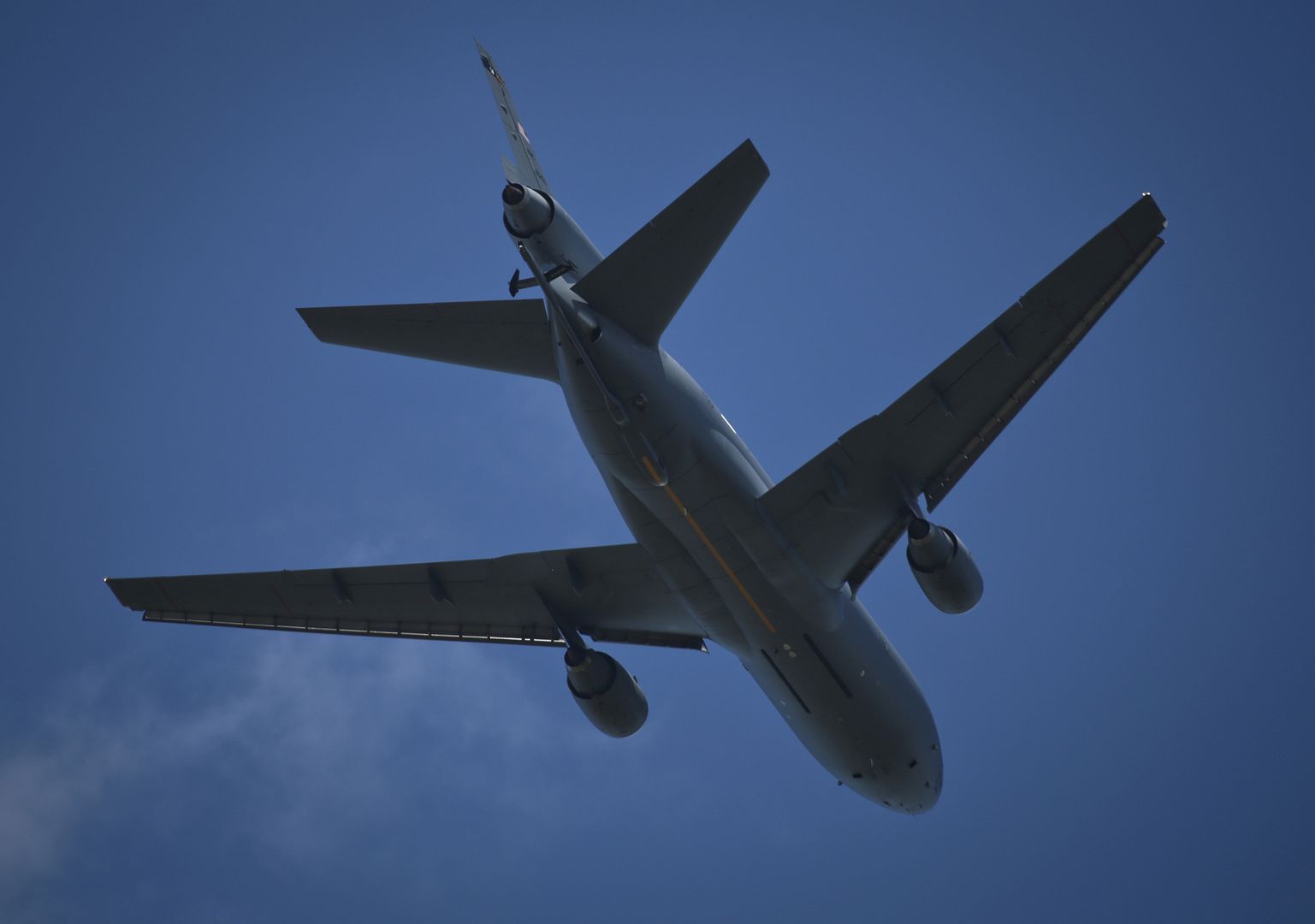
Powerliners assigned to Marine All Weather Fighter Attack Squadron (VMFA(AW)) 242 perform maintenance on an F/A-18D Hornet after a flight mission during Exercise Valiant Shield 16 at Andersen Air Force Base, Guam, Sept. 18, 2016. Powerliners, airframes mechanics, communication navigation, and ordnance technicians, work around the clock to ensure flight schedules are met for aviation operations during the exercise. During this U.S.-only, biennial field training exercise, F/A-18D Hornets flew in a plethora of missions that emphasize joint integration, interoperability and expeditionary readiness. (U.S. Marine Corps photo by Sgt. Jessica Quezada)
An F-15C Eagle with the 18th Wing, Kadena Air Base, Japan, takes off Sept. 18, 2016 on Andersen Air Force Base, Guam, during Exercise Valiant Shield 2016. VS16 is a biennial, U.S.-only, field training exercise with a focus on integration of joint training among U.S. forces. (U.S. Air Force photo by Senior Airman Joshua Smoot)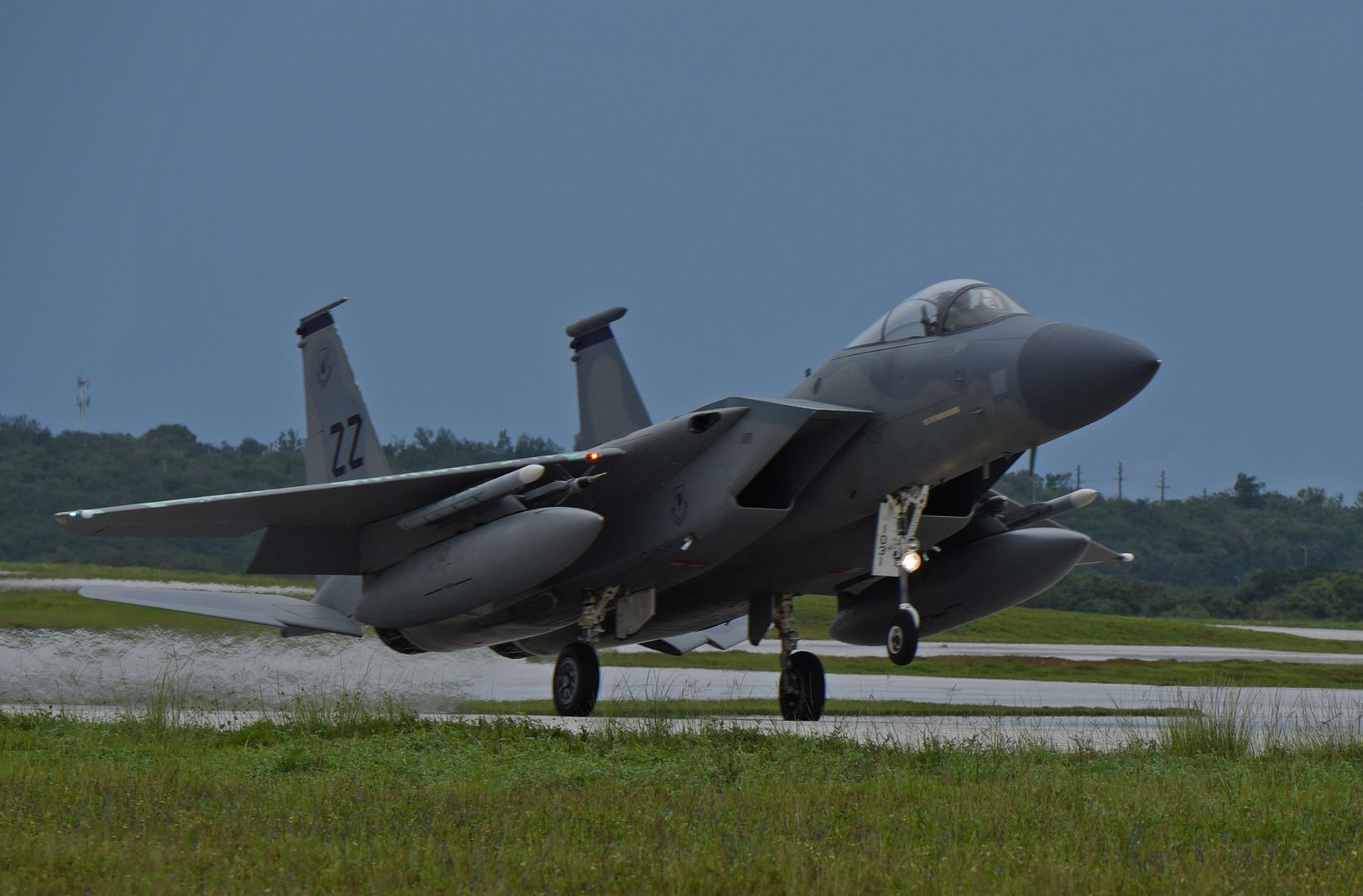
An EA-18G Growler takes off Sept. 18, 2016, on Andersen Air Force Base, Guam, during Exercise Valiant Shield 2016. VS16 is a biennial, U.S.-only, field training exercise with a focus on integration of joint training among U.S. forces. (U.S. Air Force photo by Senior Airman Joshua Smoot)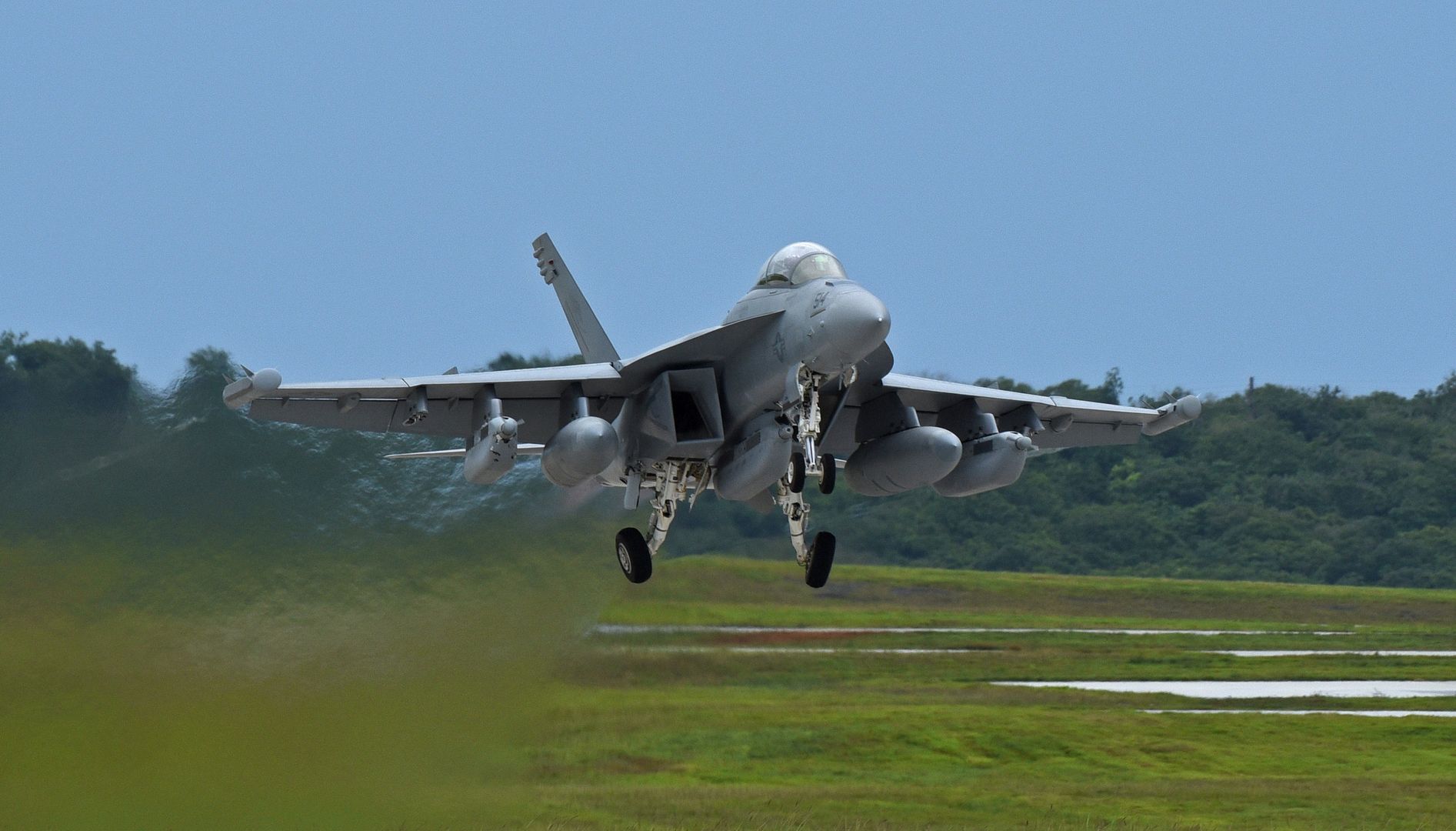
Fireworks explode over KC-135 Stratotanker at the 2016 Japanese-American Friendship Festival at Yokota Air Base, Japan, Sept. 18, 2016. Tens of thousands of people attend the festival every year to learn more about the US military and American culture. (U.S. Air Force photo's by Senior Airman Delano Scott/Released)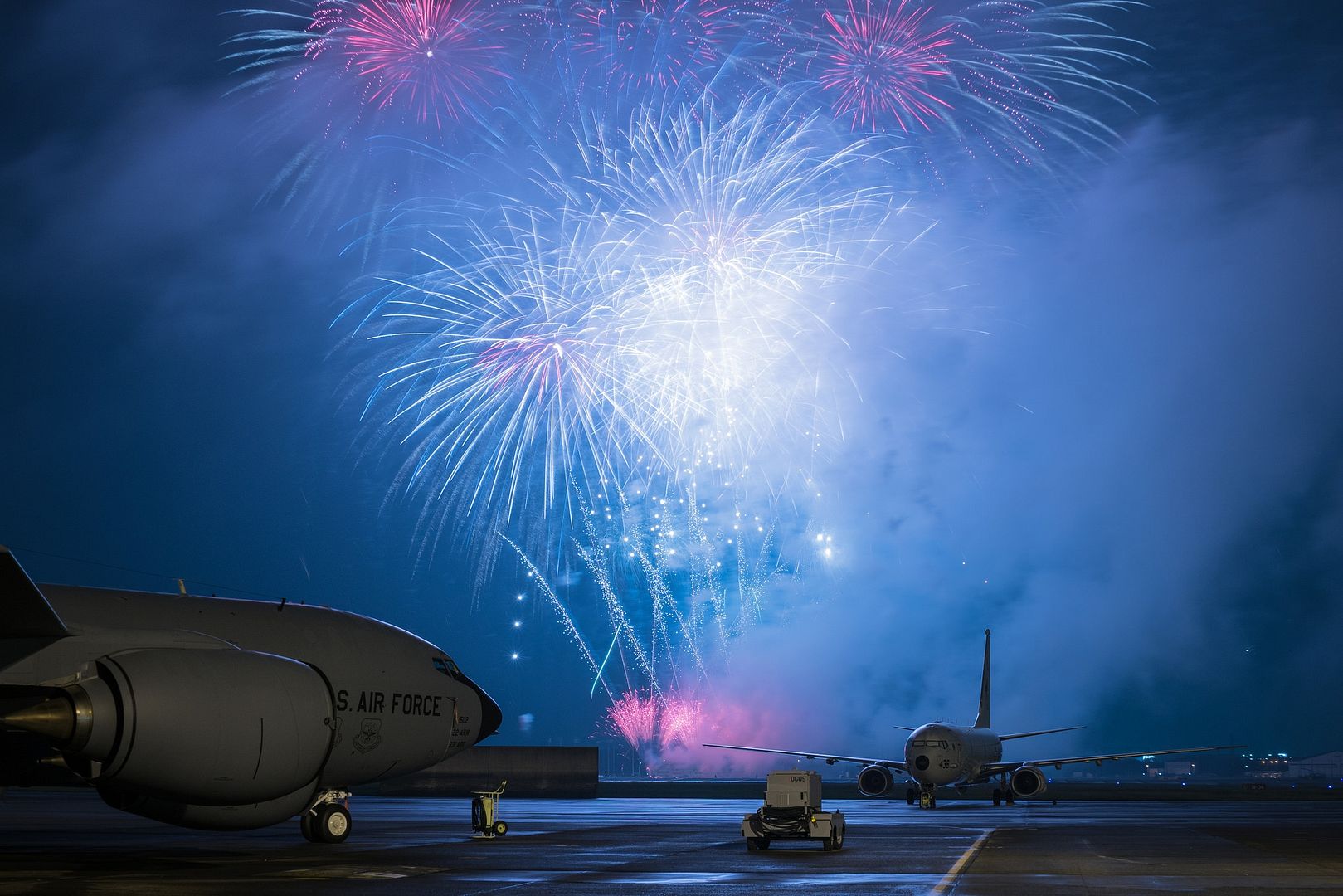
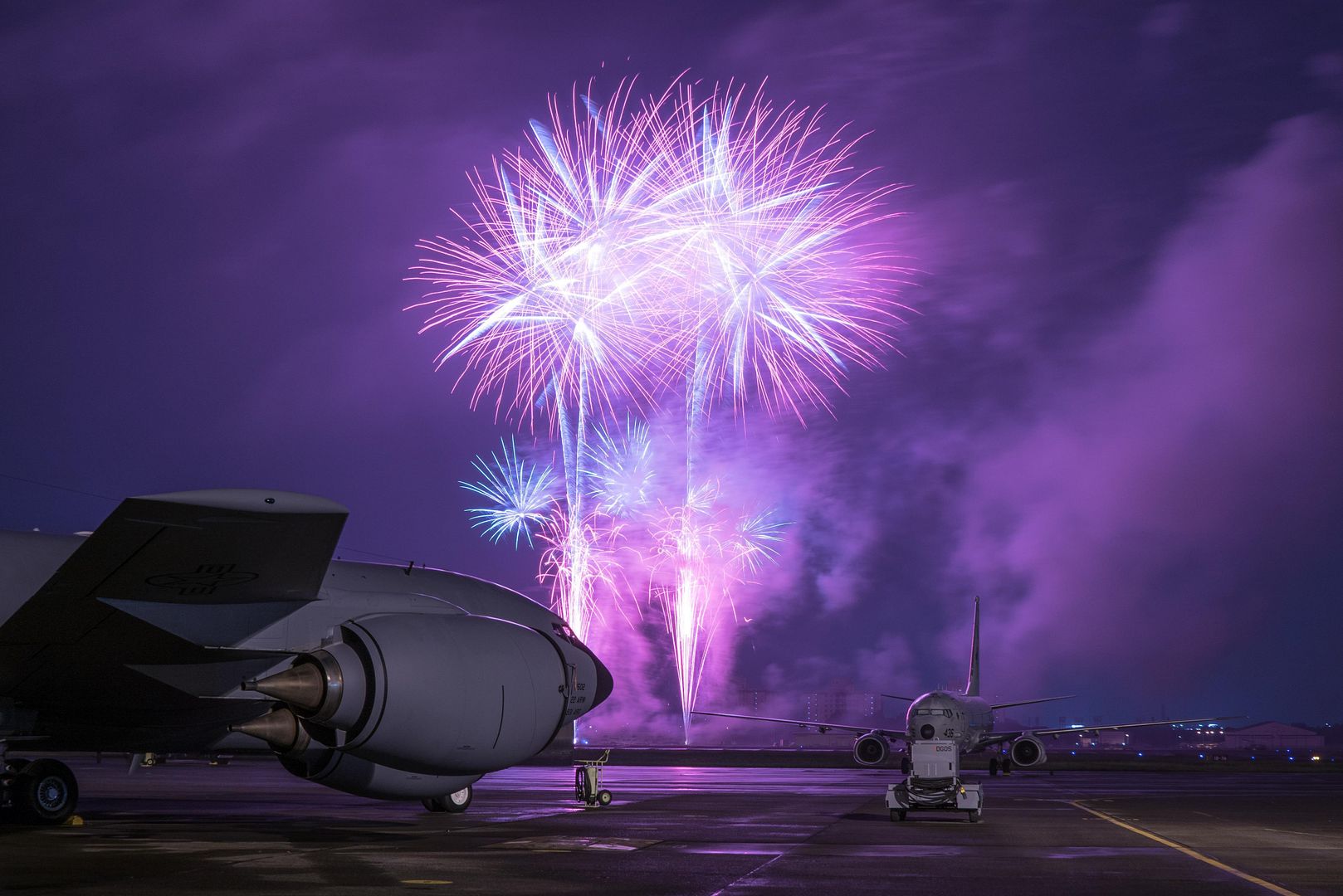
An AH-1W Super Cobra helicopter, part of Marine Medium Tiltrotor Squadron 262 (Reinforced), 31st Marine Expeditionary Unit, flies over the Pacific Ocean during a fire support training exercise, Sept. 16, 2016. As the Marine Corps? only continuously forward deployed unit, the 31st Marine Expeditionary Unit is prepared to respond to a wide range of military operations, from humanitarian assistance missions to limited combat operations, at a moment?s notice. (U.S. Marine Corps photo by Cpl. Darien J. Bjorndal/Released)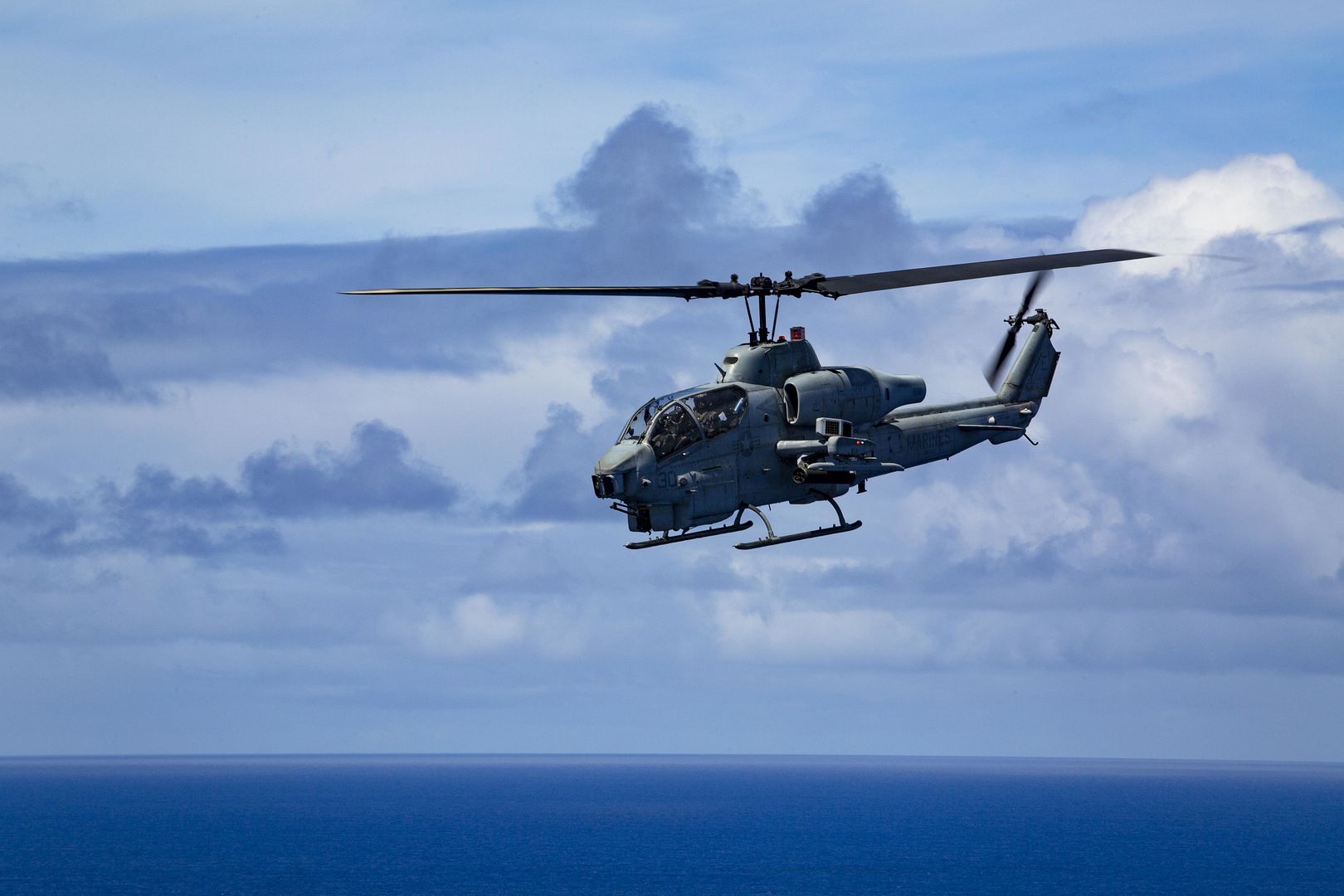
The UK?s Royal Air Force (RAF) is a step closer to being the first to use Leonardo-Finmeccanica?s new ?BriteCloud? missile-jamming countermeasure, following a purchase by the UK Ministry of Defence (MoD) worth several million Euros. The buy, which will see a significant number of the decoys delivered, will enable the RAF to further evaluate BriteCloud?s protective effect with its fleet of Tornado jets and develop what the military calls a ?concept of operations? (or ?CONOPS?) for the technology. A CONOPS essentially provides an instruction manual for the crews who will deploy with BriteCloud and the development of CONOPS is usually seen as the last step before the new technology goes into use on real missions.
BriteCloud will be delivered by the electronic warfare experts at Leonardo?s Luton site. The decoy provides digital countermeasure protection against air-to-air and surface-to-air radar-guided missiles in a package the size of a 55mm flare. It is currently the world?s only such system to have been sold and proven effective via end-to-end testing. Based on miniaturised jamming technology, BriteCloud is able to launch from a standard 55mm flare dispenser with no extra integration required.
The purchase follows previous RAF trials with the countermeasure at a specialist testing range in the US in October 2015. These trials proved the effectiveness of the BriteCloud decoys against modern, representative Radio Frequency (RF) threats. The next step towards a potential adoption for operational use by the RAF is the development of a concept of operations. This will allow the RAF to characterise the behavior of the decoy in realistic scenarios and develop ways to use it in combat. As part of this development, a series of further trials on RAF Tornadoes will take place to verify and extend the operational advantage of the countermeasure.
Defence Secretary Michael Fallon said: ?The cutting-edge technology behind BriteCloud demonstrates the MOD?s commitment to harnessing and growing the incredible creativity in our Defence supply chain. ?Supported by our ?178 billion investment in equipment, these new decoy systems show that we are continually pushing the boundaries of innovation, making the most of Great British skills and brains to keep our Armed Forces safe from our adversaries.?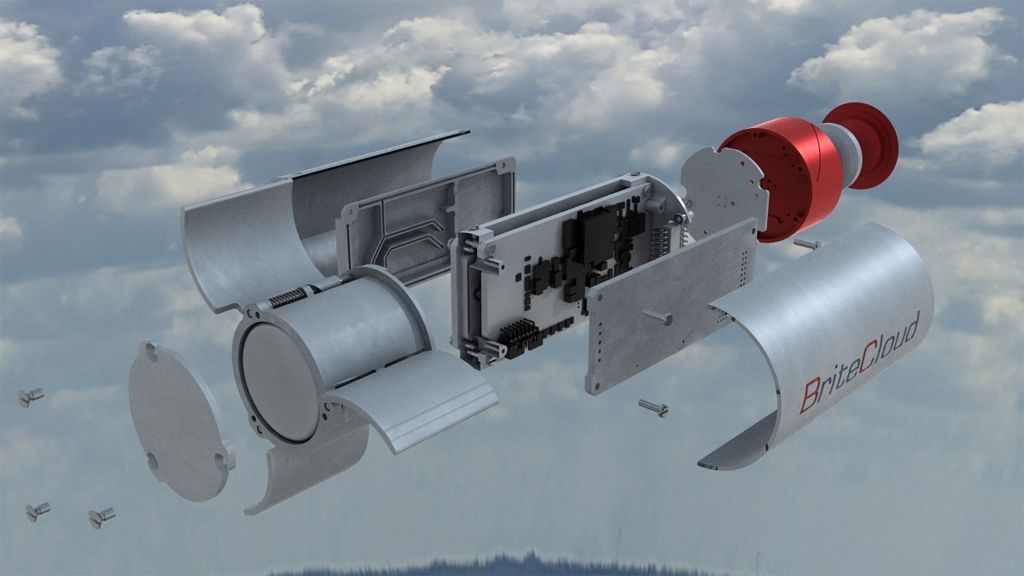
The BriteCloud Expendable Active Decoy (EAD) has been developed by Leonardo in collaboration with the UK's Defence Science and Technology Laboratory (DSTL) and the UK MoD's Defence Equipment and Support organisation.
BriteCloud was launched in November 2013 and is now in full production following successful trials on Tornado and Saab?s Gripen NG aircraft. Leonardo is working with Saab to offer the decoy as an electronic warfare enhancement option for its full range of Gripen jets including the upcoming ?E? model.
BriteCloud is dispensed from a standard 55mm flare cartridge and can be swapped for a 55mm flare with no further integration required. Leonardo is also working with a number of other manufacturers to adapt existing systems for the use of the 55mm cartridge.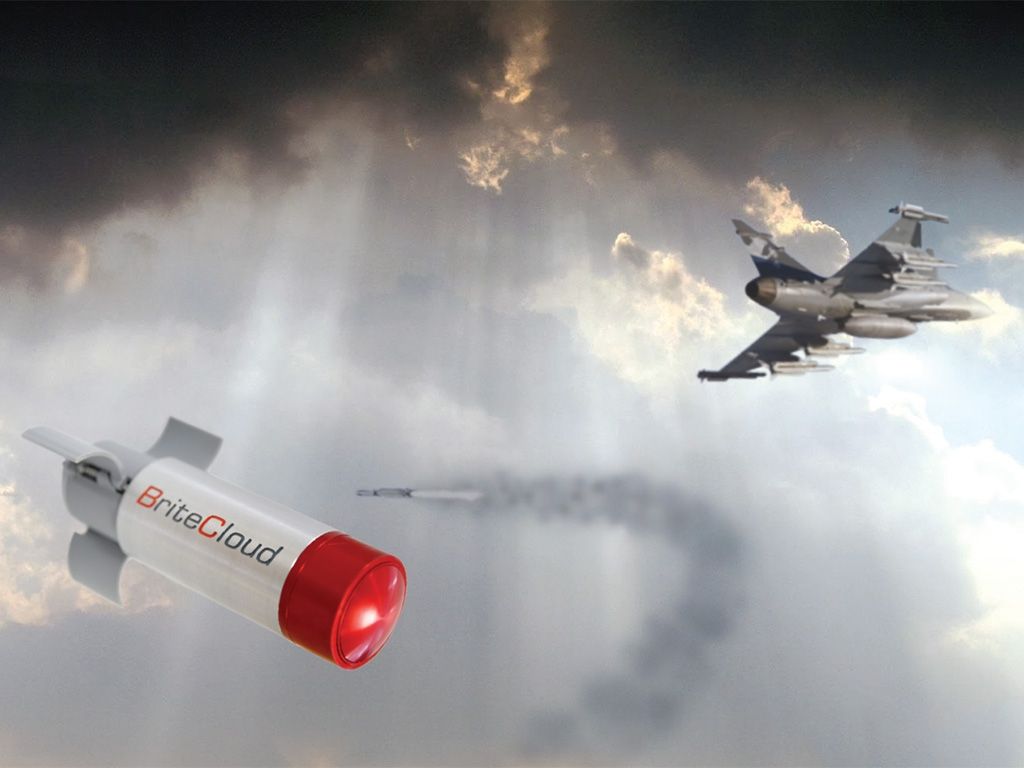
-
 Main AdminA MV-22B Osprey tiltrotor aircraft belonging to Marine Medium Tiltrotor Squadron 262 (Reinforced), 31st Marine Expeditionary Unit, from the flight deck of the USS Bonhomme Richard (LHD 6) during low-light takeoff and landing exercises in the waters of the Commonwealth Northern Mariana Islands, Sept. 18, 2016. The 31st MEU is currently embarked aboard the ships of the Bonhomme Richard Expeditionary Strike Group as part of a routine patrol of the Indo-Asia-Pacific region. As the Marine Corps? only continuously forward deployed unit, the 31st Marine Expeditionary Unit is prepared to respond to a wide range of military operations, from humanitarian assistance missions to limited combat operations, at a moment?s notice. (U.S. Marine Corps Photo's by Staff Sgt. T.T. Parish/Released)
Main AdminA MV-22B Osprey tiltrotor aircraft belonging to Marine Medium Tiltrotor Squadron 262 (Reinforced), 31st Marine Expeditionary Unit, from the flight deck of the USS Bonhomme Richard (LHD 6) during low-light takeoff and landing exercises in the waters of the Commonwealth Northern Mariana Islands, Sept. 18, 2016. The 31st MEU is currently embarked aboard the ships of the Bonhomme Richard Expeditionary Strike Group as part of a routine patrol of the Indo-Asia-Pacific region. As the Marine Corps? only continuously forward deployed unit, the 31st Marine Expeditionary Unit is prepared to respond to a wide range of military operations, from humanitarian assistance missions to limited combat operations, at a moment?s notice. (U.S. Marine Corps Photo's by Staff Sgt. T.T. Parish/Released)

The sun rises on 108th Wing, New Jersey Air National Guard, KC-135R Stratotankers at Joint Base McGuire-Dix-Lakehurst, N.J., Sept. 18, 2016, the Air Force?s 69th birthday. (U.S. Air National Guard photo by Master Sgt. Mark C. Olsen/Released)
ARABIAN GULF (Sep. 18, 2016) Capt. Paul ?Speedy? Spedero Jr., commanding officer of the aircraft carrier USS Dwight D. Eisenhower (CVN 69) (Ike), and Capt. Marc J. Miguez, deputy commander, Carrier Air Wing (CVW) 3, pilot an F/A-18F Super Hornet assigned to the Fighting Swordsmen of Strike Fighter Squadron (VFA) 32 as it makes an arrested landing on the flight deck. Ike and its Carrier Strike Group are deployed in support of Operation Inherent Resolve, maritime security operations and theater security cooperation efforts in the U.S. 5th Fleet area of operations. (U.S. Navy photo by Mass Communication Specialist 3rd Class Nathan T. Beard)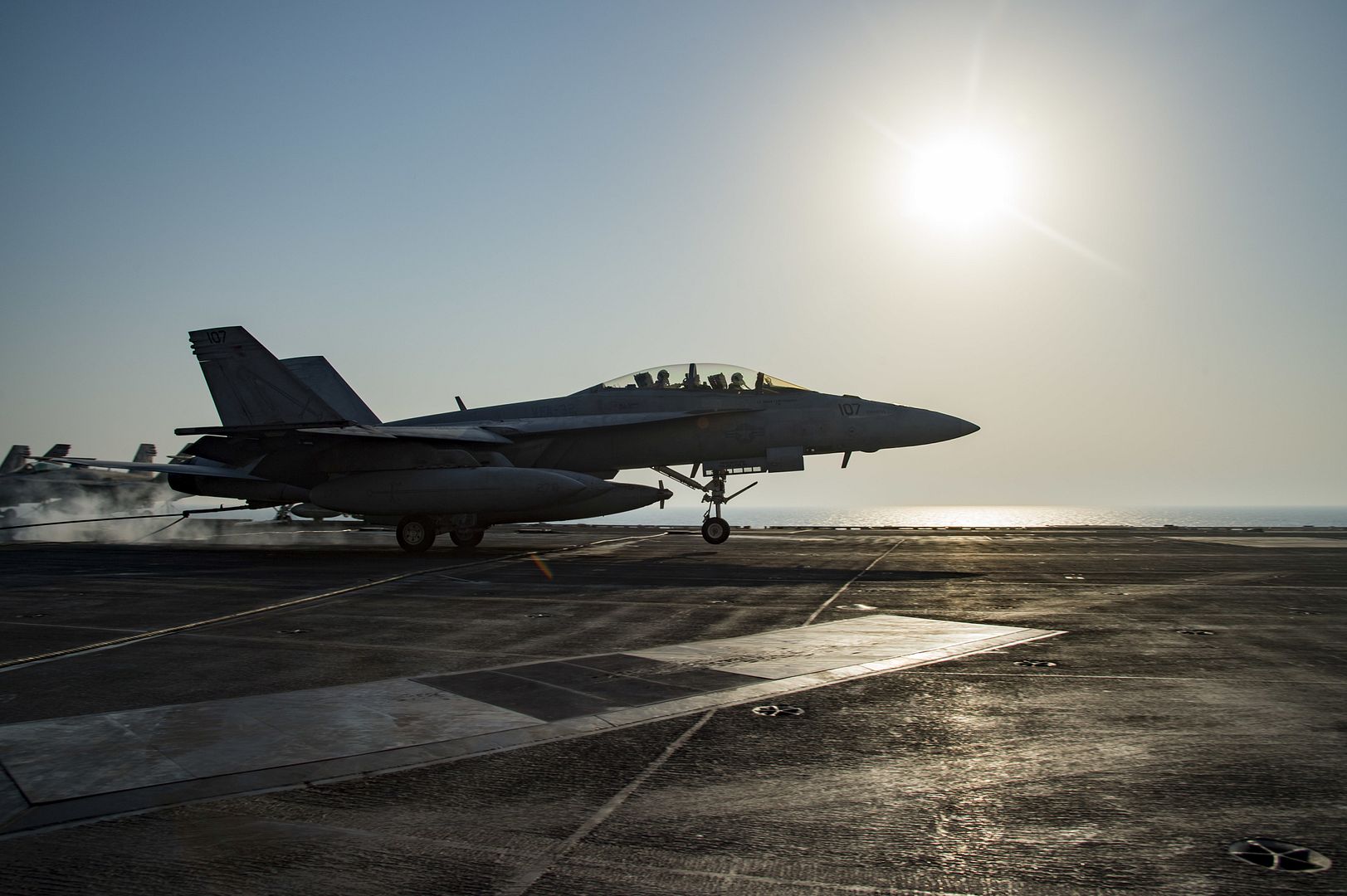
An F-15C Eagle, from the 67th Fighter Squadron, part of the 18th Operations Group at Kadena Air Base, Japan., begins inflight refueling from a KC-135 Stratotanker assigned to the 909th Air Refueling Squadron, 300 nautical miles from Guam, during Exercise Valiant Shield 16. VS16 is a biennial field exercise with a primary focus on interoperability and integration of joint training among U.S. forces.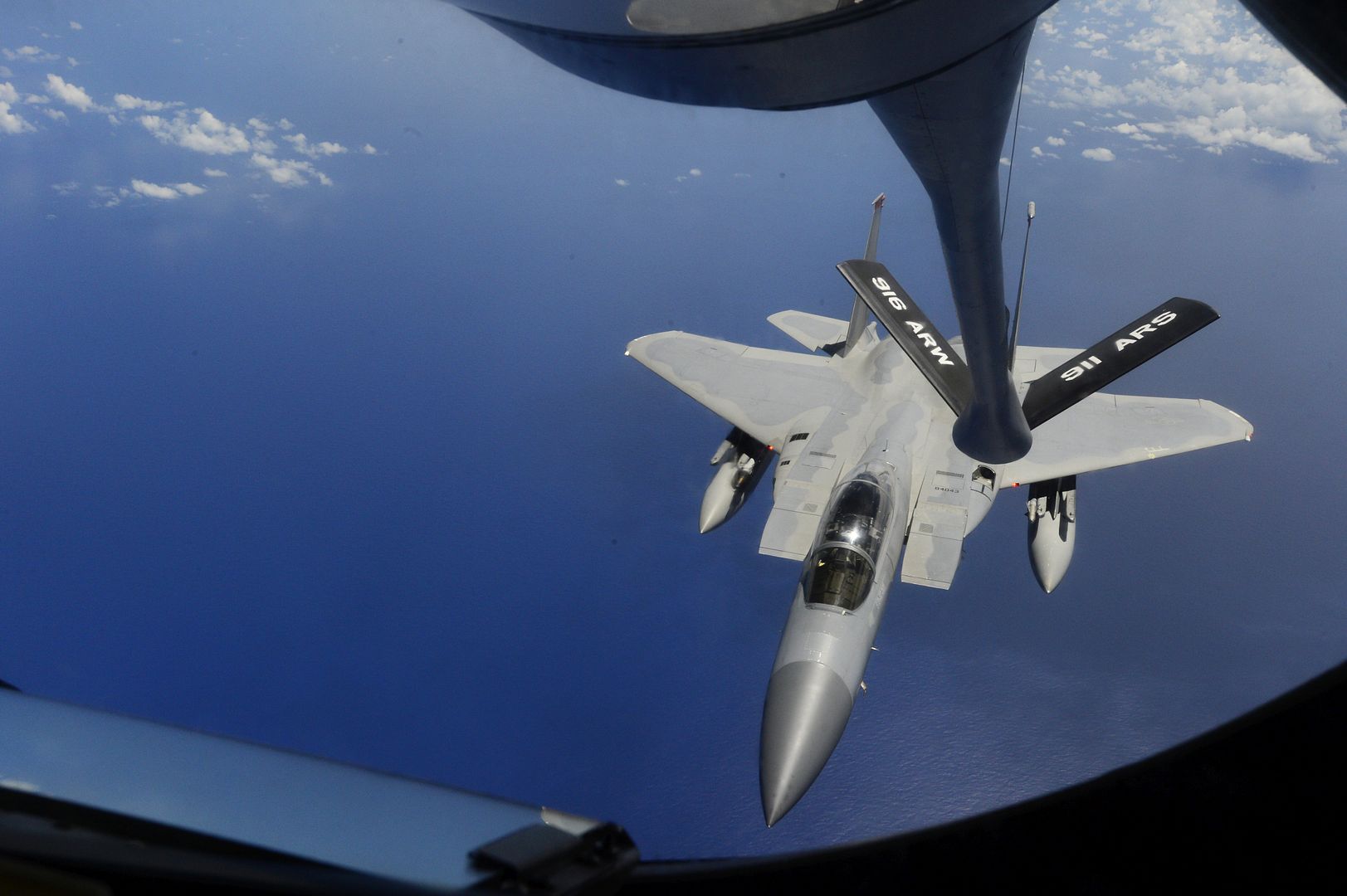
F-16 Fighting Falcon's, from the 18th Aggressor Squadron based out of Fairbanks, Alaska, during inflight refueling from a KC-135 Stratotanker assigned to the 909th Air Refueling Squadron, 300 nautical miles from Guam, during Exercise Valiant Shield 16. VS16 is a biennial field exercise with a primary focus on interoperability and integration of joint training among U.S. forces.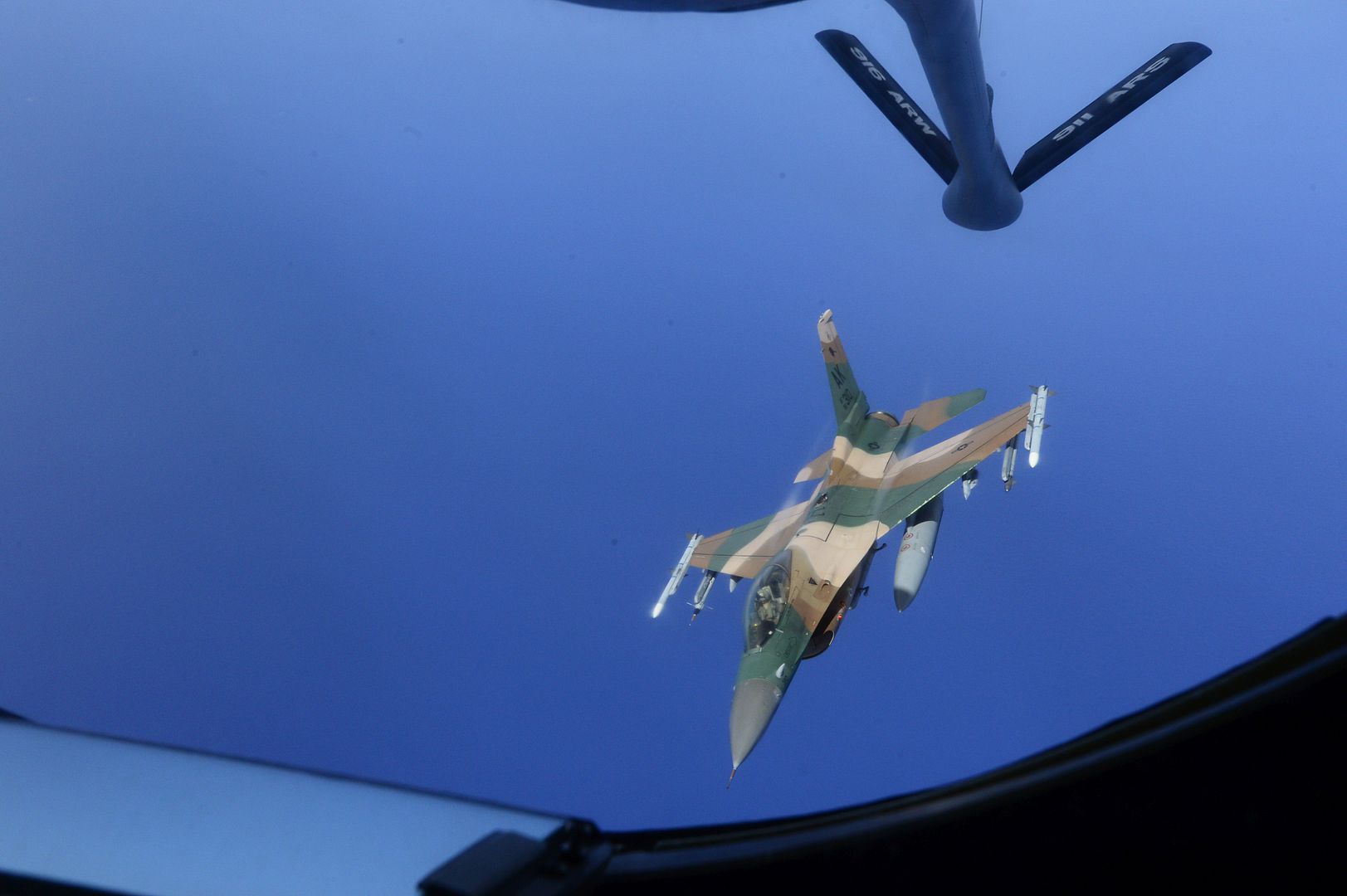

NATIONAL HARBOR, Md. (AFNS) --
The Air Force?s long-range strike bomber has officially been named the B-21 Raider.
Air Force Secretary Deborah Lee James announced the results of the Air Force Global Strike Command led naming contest alongside selected members during her remarks at the Air Force Association?s Air, Space and Cyber Conference here Sept. 19, 2016.
?Today I want to recognize three Airmen who answered the call to be a part of a new Air Force legacy and name our new bomber,? James said. ?The first two ? submitted proposals that captured the essence of the bomber force and they are the winners of our contest.?
The third Airmen James recognized, calling him one of the greatest men of his generation, was Doolittle Raider retired Lt. Col. Richard E. Cole.
The Doolittle Raiders are known for their surprise attack against Japan during World War II on April 18, 1942, which forced the Japanese to recall combat forces for home defense, and boosted morale among Americans and U.S. allies abroad.
The name was ultimately selected by James and Air Force Chief of Staff Gen. Dave Goldfein after a panel composed of staff from AFGSC and Headquarters Air Force determined the top-ranked selections from more than 2,100 unique naming submissions.
While there were multiple entries advocating for the B-21 to be dubbed Raider, Air Force officials said the members were selected based on the overall quality of their justification.
James has often highlighted the important role the B-21 Raider will play in allowing the Air Force to operate in tomorrow?s high end threat environment, and in providing the Air Force the flexibility and capability to launch from the continental United States and deliver air strikes on any location in the world. She has also cautioned of the delays the program could face under a continuing resolution.
?A short-term (continuing resolution) is manageable ? but, let me tell you, a long-term continuing resolution would be very damaging for the Air Force,? James said. ?(It would) cap the production of the KC-46, prevent us from devoting more funds to developing the B-21 next year, and delay about 50 construction projects.?
The service?s ability to divest old capabilities and build new is paramount, and modernization remains a priority for the Air Force as it continues to play a major role defending against current and emerging threats.
?We have the oldest aircraft fleet we have ever had, 27 years old on average,? James said. ?This absolutely needs to be a focus for us.?
The B-21 Raider, designed based on a set of requirements that allow the use of existing and mature technology, is currently in the Engineering and Manufacturing Development phase and the Air Force plans to field the initial capability of the aircraft in mid-2020s.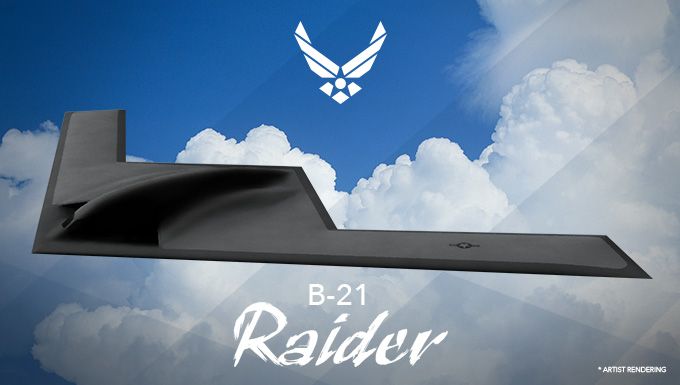
19 September 2016 Press Release
The first delivery of an A321 aircraft from the Airbus U.S. Manufacturing Facility to Spirit Airlines took place today in Mobile, Alabama. On hand for the occasion were executives from Airbus and Spirit Airlines, 140 Spirit Airlines employees, and the 350 Airbus employees at the Airbus U.S. Manufacturing Facility.
?Many years ago, Spirit recognized that Airbus was the right partner to provide the most modern, fuel-efficient aircraft, which allowed them to become a leading Ultra Low Cost Carrier in the U.S.,? said Bob Lekites, Executive Vice President-Customers, Airbus Americas. ?It?s been a successful partnership, and this aircraft ? the first to be produced for Spirit in Mobile and the U.S.A ? will hold a special place in our memories as we go forward. It?s truly a great milestone.?
?This is an exciting day for Spirit Airlines,? said Bob Fornaro, President and CEO of Spirit Airlines. ?Our Fit Fleet is one of the youngest and most fuel-efficient in the industry and we?re thrilled to add our first American-made aircraft to the Spirit family. Spirit?s all-Airbus fleet helps us maintain an efficient, streamlined operation, allowing the company to save on costs and provide customers with ultra-low fares.?
Airbus announced its commitment to build a single-aisle assembly line in Mobile, Alabama in 2012, and less than one year later, broke ground on the $600 million facility. The ceremonial inauguration of the plant took place in September 2015. The aircraft delivered today is the 10th aircraft delivered from Mobile.
Airbus anticipates delivering four aircraft per month from the Mobile plant by the end of 2017. The initial deliveries will all be A320 Family aircraft with the Current Engine Option (CEO), but will begin transitioning to New Engine Option (NEO) derivatives in late 2017.
In addition to hundreds of new Airbus jobs the project has brought to the local community, the Mobile area has seen many Airbus suppliers open new facilities in the region, providing even more employment and a parallel boost to the local economy. Airbus is proud that 87 percent of its new employees are from the Gulf Coast region, with nearly one third being U.S. military veterans.
Demonstrating the adage ?The Sun Never Sets on Airbus Manufacturing? ? Airbus aircraft are now produced around the clock, 24 hours a day, at facilities in: Mobile, Alabama; Hamburg, Germany; Toulouse, France; and Tianjin, China.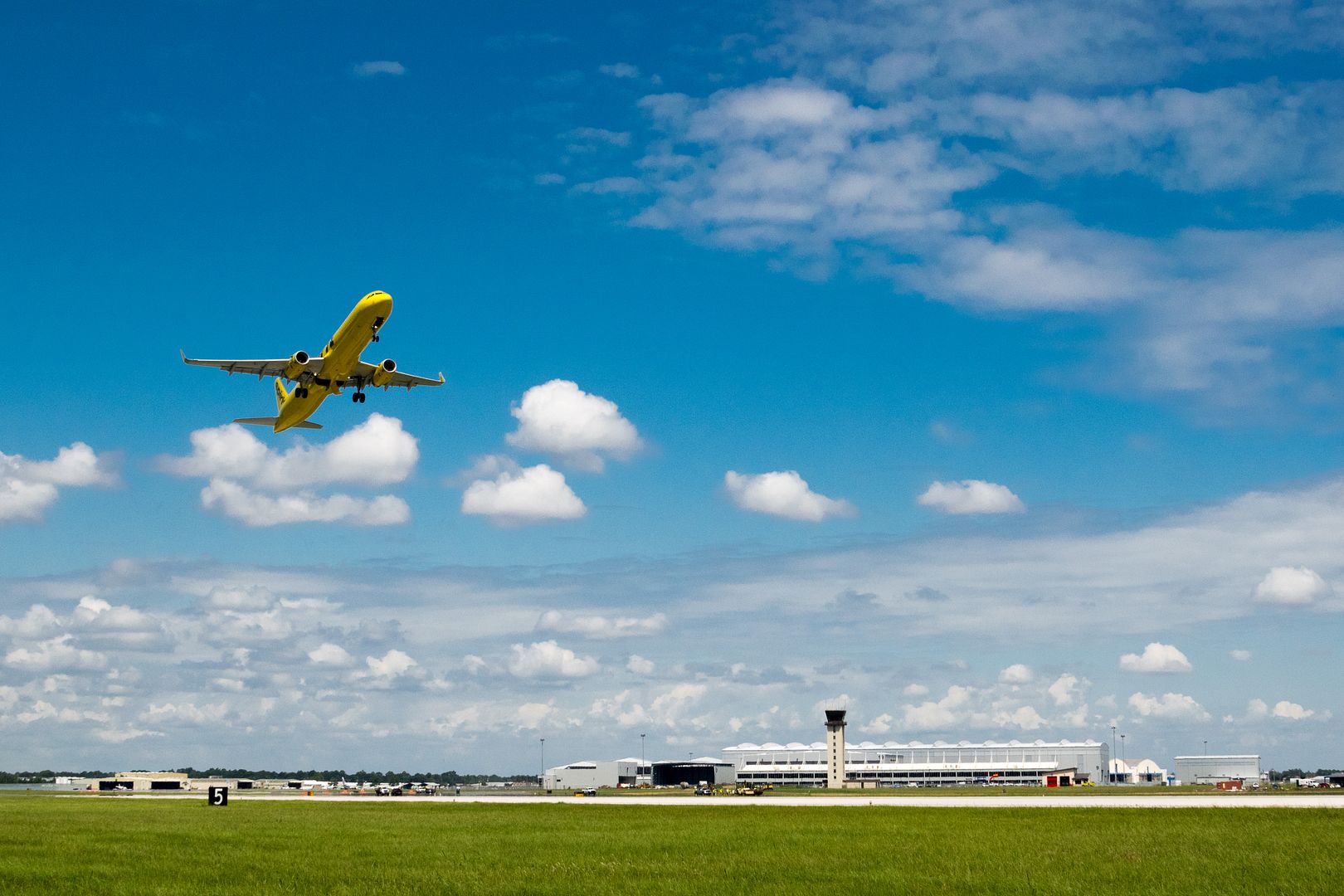
-
 Main AdminPHILIPPINE SEA (Sept. 20, 2016) Marines conduct maintenance on an SH-53E Super Stallion on the flight deck of amphibious assault ship USS Bonhomme Richard (LHD 6). Bonhomme Richard, flagship of the Bonhomme Richard Expeditionary Strike Group, is operating in the Philippine Sea in support of security and stability in the Indo-Asia Pacific region. (U.S. Navy photo by Mass Communication Specialist 3rd Class William Sykes/Released)
Main AdminPHILIPPINE SEA (Sept. 20, 2016) Marines conduct maintenance on an SH-53E Super Stallion on the flight deck of amphibious assault ship USS Bonhomme Richard (LHD 6). Bonhomme Richard, flagship of the Bonhomme Richard Expeditionary Strike Group, is operating in the Philippine Sea in support of security and stability in the Indo-Asia Pacific region. (U.S. Navy photo by Mass Communication Specialist 3rd Class William Sykes/Released)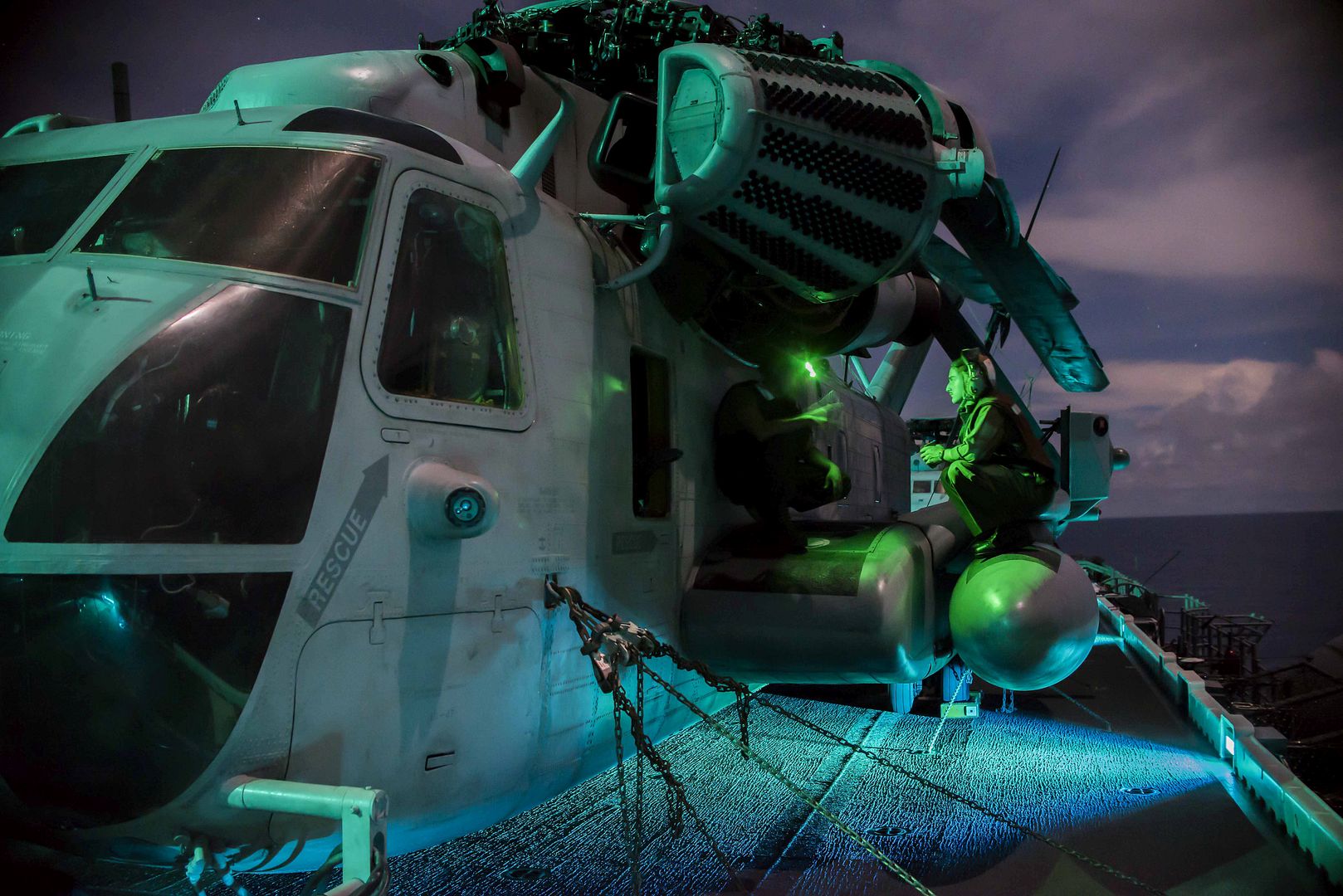
Sikorsky CH-53E Super Stallions, assigned to Marine Medium Tiltrotor Squadron 262 (reinforced), depart with Marines from the 2nd Battalion, 4th Marine Regiment, attached to 31st Marine Expeditionary after participating in an exercise to secure Orote Airfield on U.S. Naval Base Guam during Exercise Valiant Shield. VS16 is a biennial field exercise with a primary focus on interoperability and integration of joint training among U.S. forces. (U.S. Navy photo by Mass Communication Specialist 1st Class John Johnson)
MV-22B Ospreys with Marine Medium Tiltrotor Squadron (VMM) 262 (Reinforced) stand by to transport Marines from 3rd Battalion, 3rd Marine Regiment on North Ramp, Andersen Air Force Base, Guam, during Exercise Valiant Shield 16, Sept. 20, 2016. The Kilo 3/3 Marines departed to perform an airfield seizure on Tinian for Valiant Shield. VS16 is a biennial U.S. only, field training exercise that focuses on joint training with U.S. Navy, Air Force and Marine Corps to increase interoperability and working relationships. (U.S. Marine Corps photo by Sgt. Justin A. Fisher)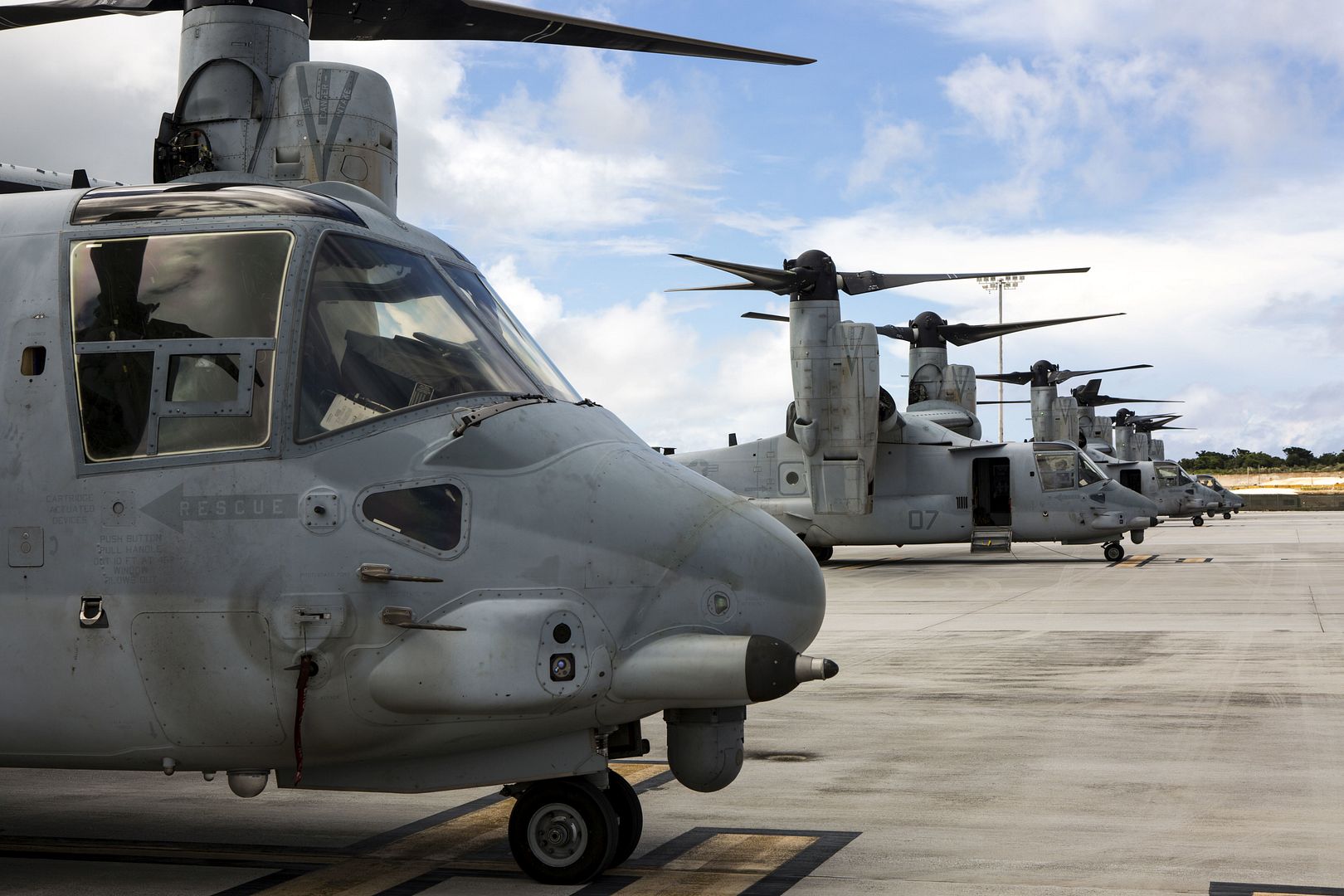
A MV-22B Osprey transports Marines assigned to 3rd Battalion, 3rd Marines during an island seizure drill as part of Exercise Valiant Shield 2016 in Tinian, Commonwealth of the Northern Mariana Islands (CNMI), Sept. 20, 2016. Valiant Shield is a biennial, U.S. Air Force, Navy and Marine Corps exercise held in Guam, focusing on real-world proficiency in sustaining joint forces at sea, in the air, on land and in cyberspace. (U.S. Navy Combat Camera photo by Mass Communication Specialist 1st Class Benjamin A. Lewis/Released)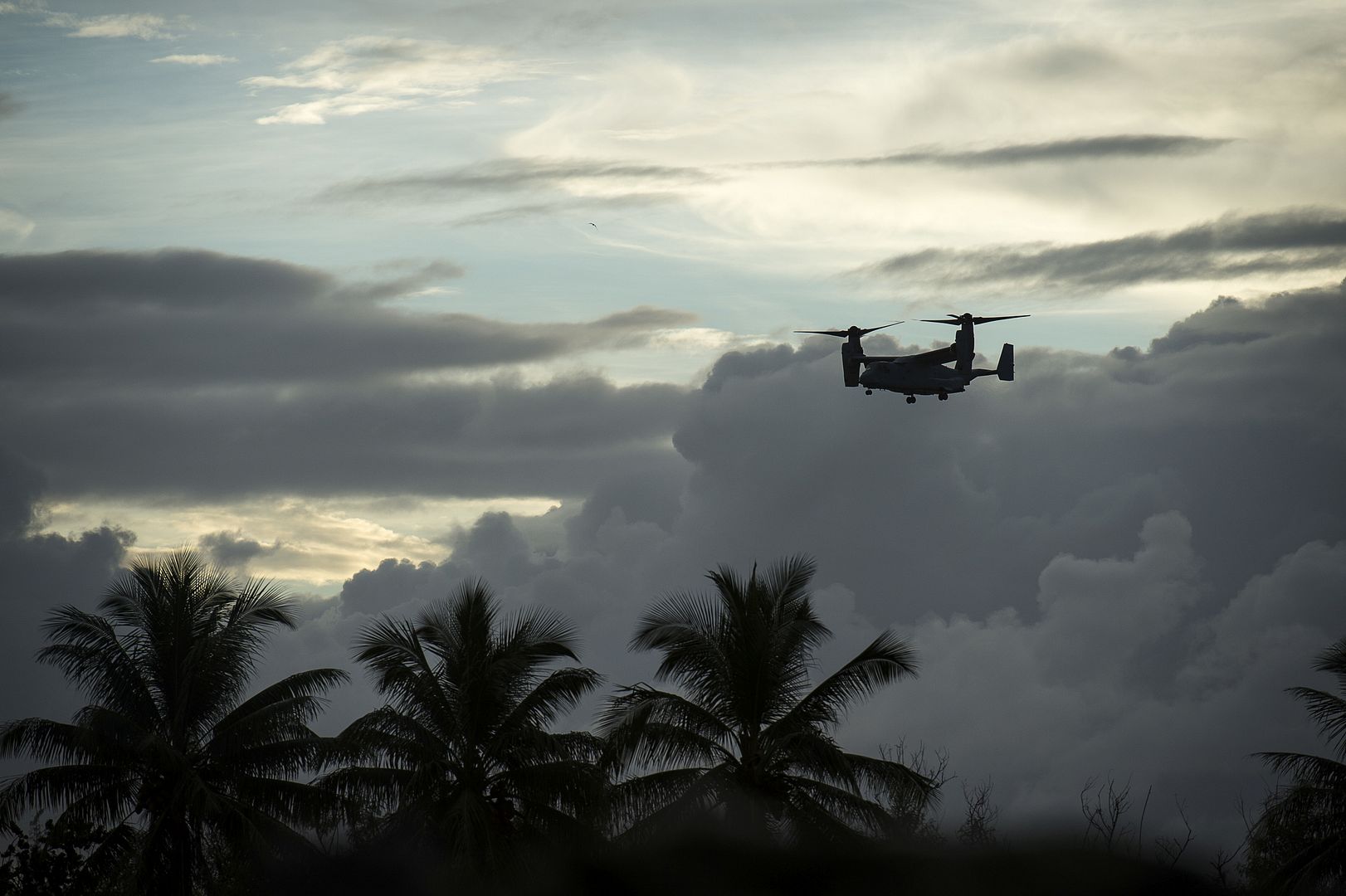
A U.S. Air Force B-1B Lancer deployed from Andersen Air Base, Guam, performs a landing at Osan Air Base, Republic of Korea, Sept. 21, 2016. This is the first time the Lancer has landed on the Korean peninsula in 20 years. The B-1 is the backbone of the U.S. long-range bomber mission and is capable of carrying the largest payload of both guided and unguided weapons in the Air Force inventory.(U.S. Air Force photo by Staff Sgt. Jonathan Steffen)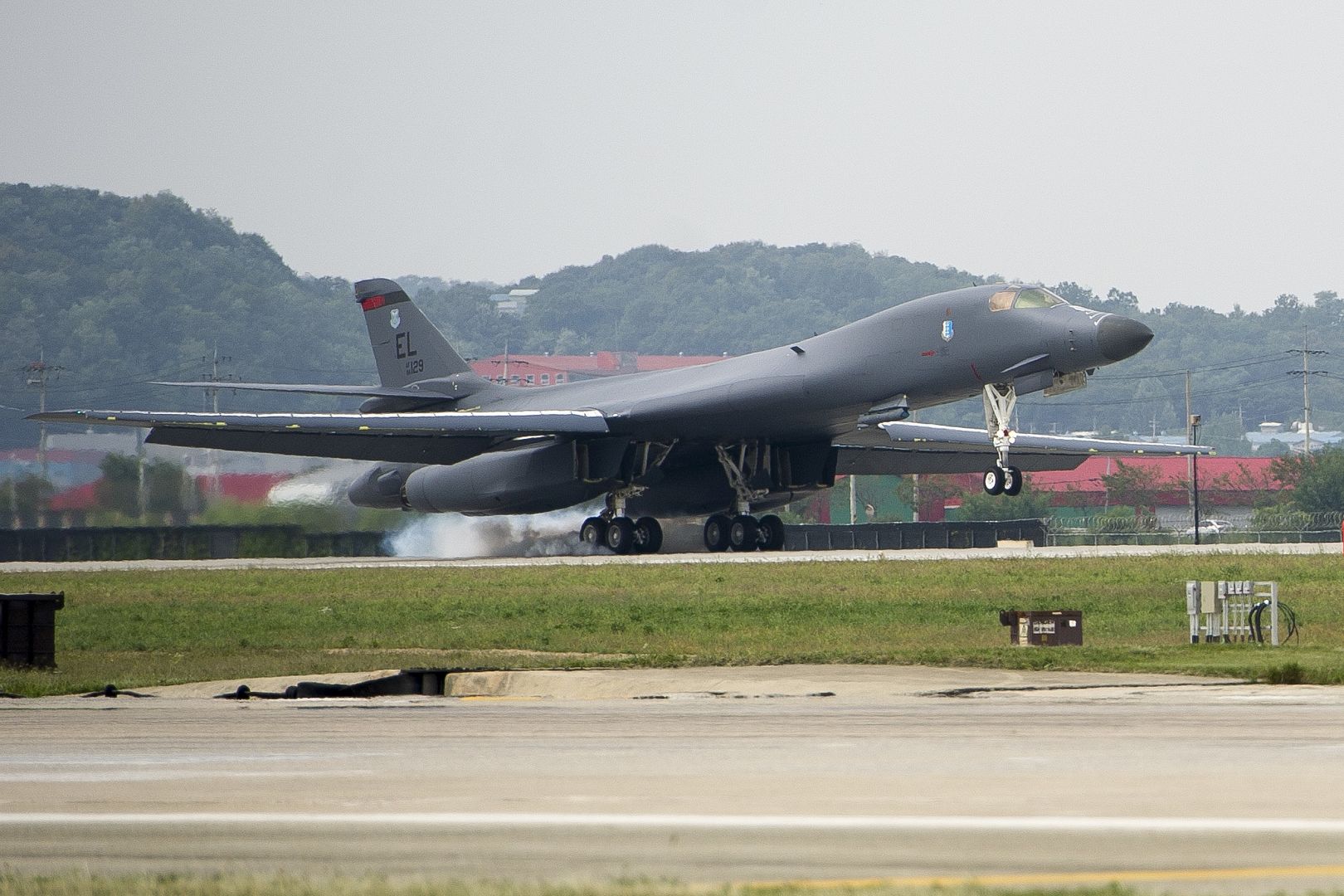
A U.S. Air Force B1-B Lancer deployed to Andersen Air Base, Guam, makes a low-level pass before landing at Osan Air Base, Republic of Korea, Sept. 21, 2016. The B-1 is the backbone of the U.S. long-range bomber mission and is capable of carrying the largest payload of both guided and unguided weapons in the Air Force inventory. The flight was the closest a B-1 has ever flown to the border between the Republic of Korea and North Korea. (U.S. Air Force photo by Staff Sgt. Rachelle Coleman)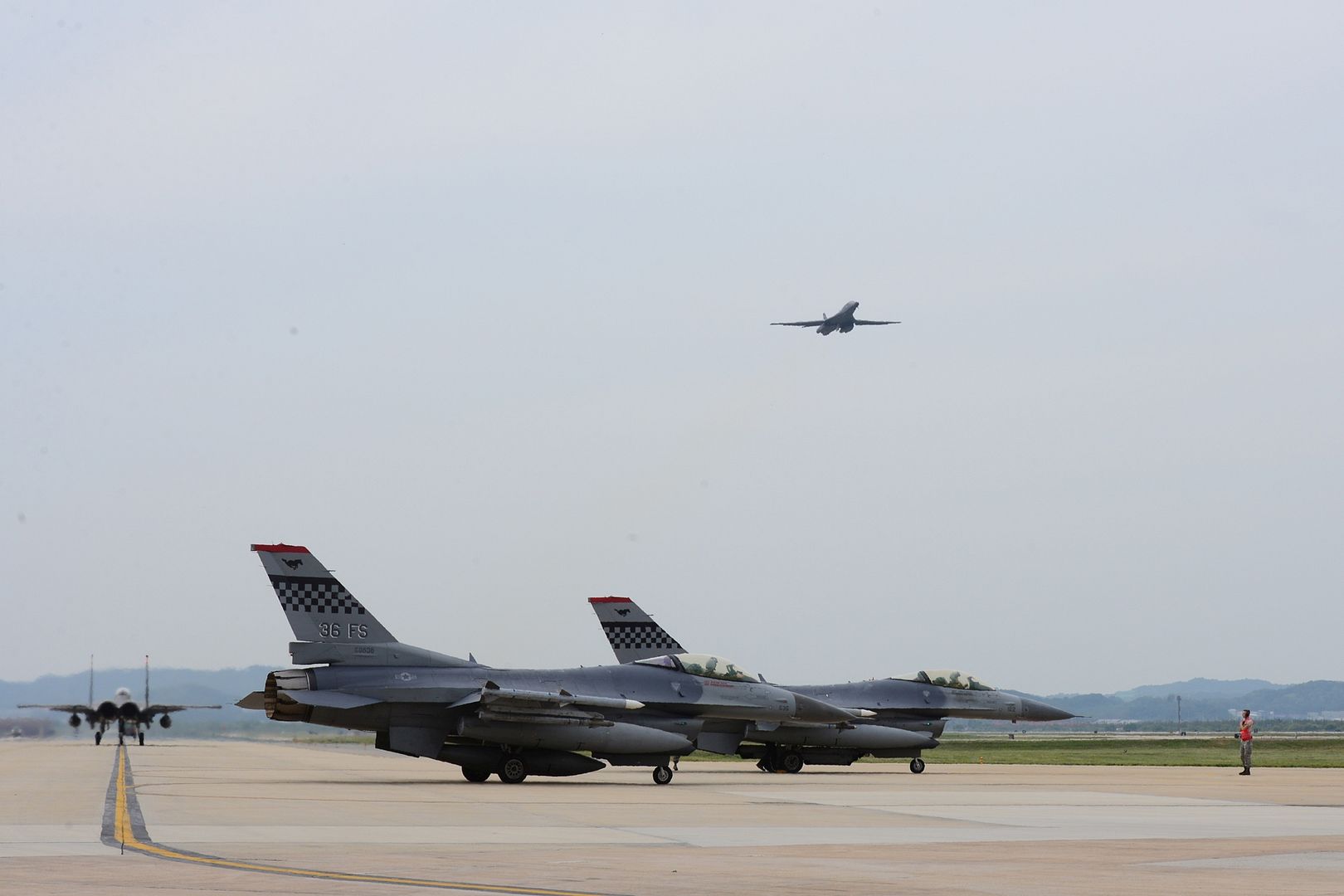
A U.S. Air Force B-1B Lancer assigned to Andersen Air Base, Guam, performs a landing at Osan Air Base, Republic of Korea. Sept. 21, 2016. The B-1 is the backbone of the U.S. long-range bomer mission and is capable of carrying the largest payload of both guided and unguided weapons in the Air Force Inventory. (U.S. Air Force photo by Senior Airman Dillian Bamman)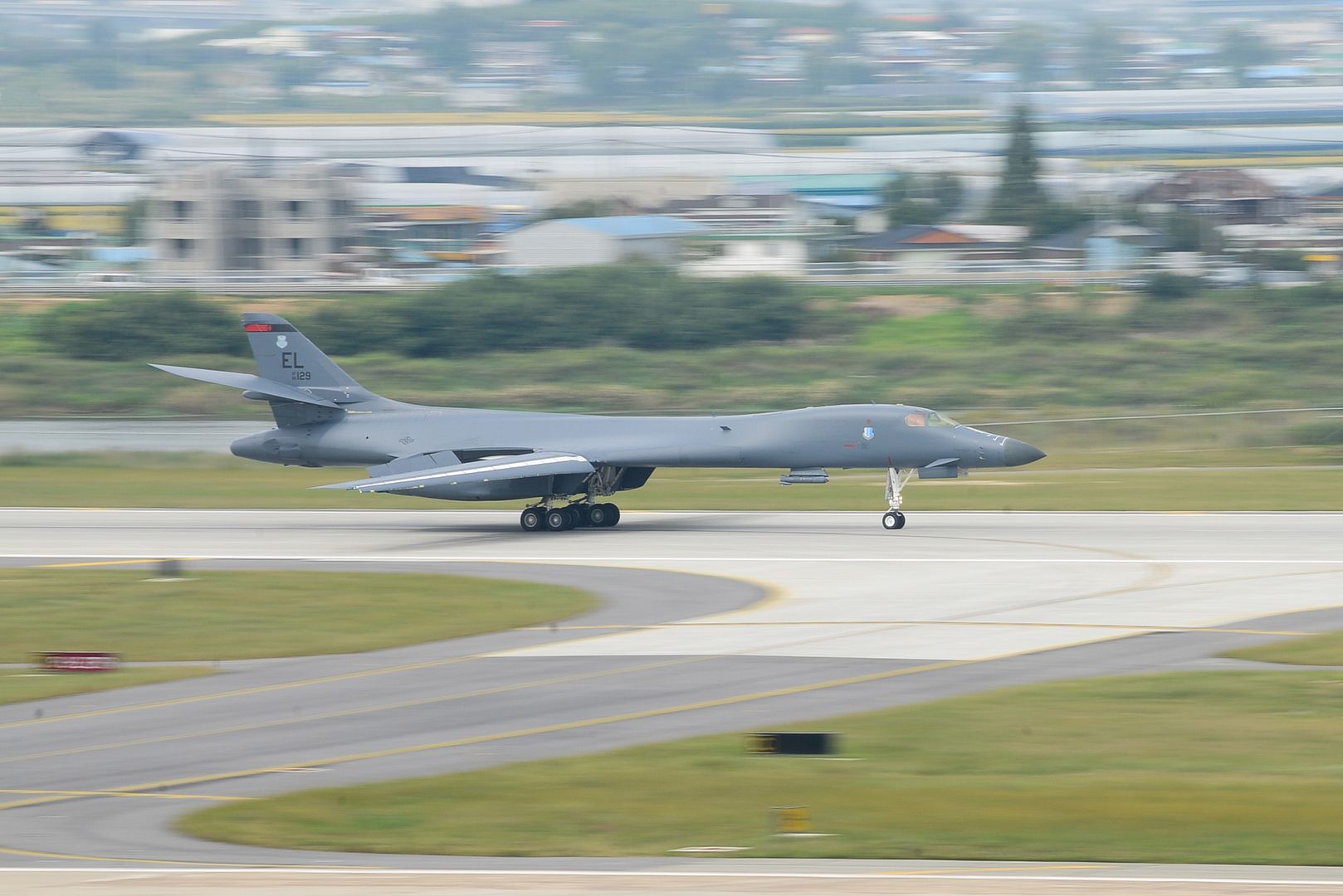
A B-1B Lancer assigned to Andersen Air Base, Guam, performs a low level flight over Osan Air Base, Republic of Korea, Sept. 21, 2016. The B-1 is the backbone of the U.S. long-range bomber mission and is capable of carrying the largest payload of both guided and unguided weapons in the Air Force inventory. (U.S. Air Force photo by Senior Airman Dillian Bamman)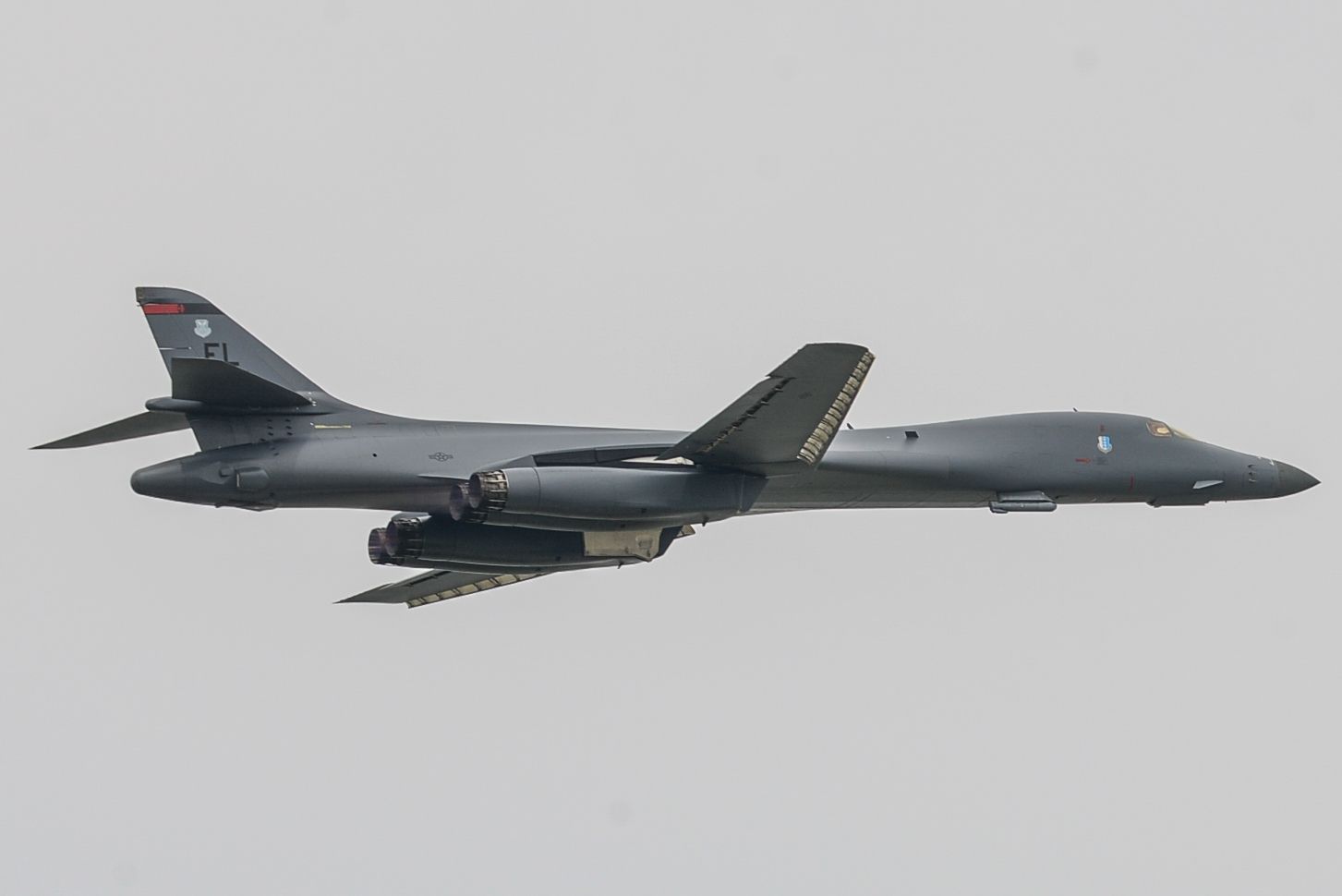
A Republic of Korea air force F-15K Slam Eagle taxis off the runway at Osan Air Base, Republic of Korea, Sept. 21, 2016. Several fighter aircraft, including the F-15K, escorted a B-1B Lancer deployed from Andersen Air Base, Guam, to Osan after a mission flying the B-1 closest to the North Korean border ever. (U.S. Air Force photo by Senior Airman Victor J. Caputo)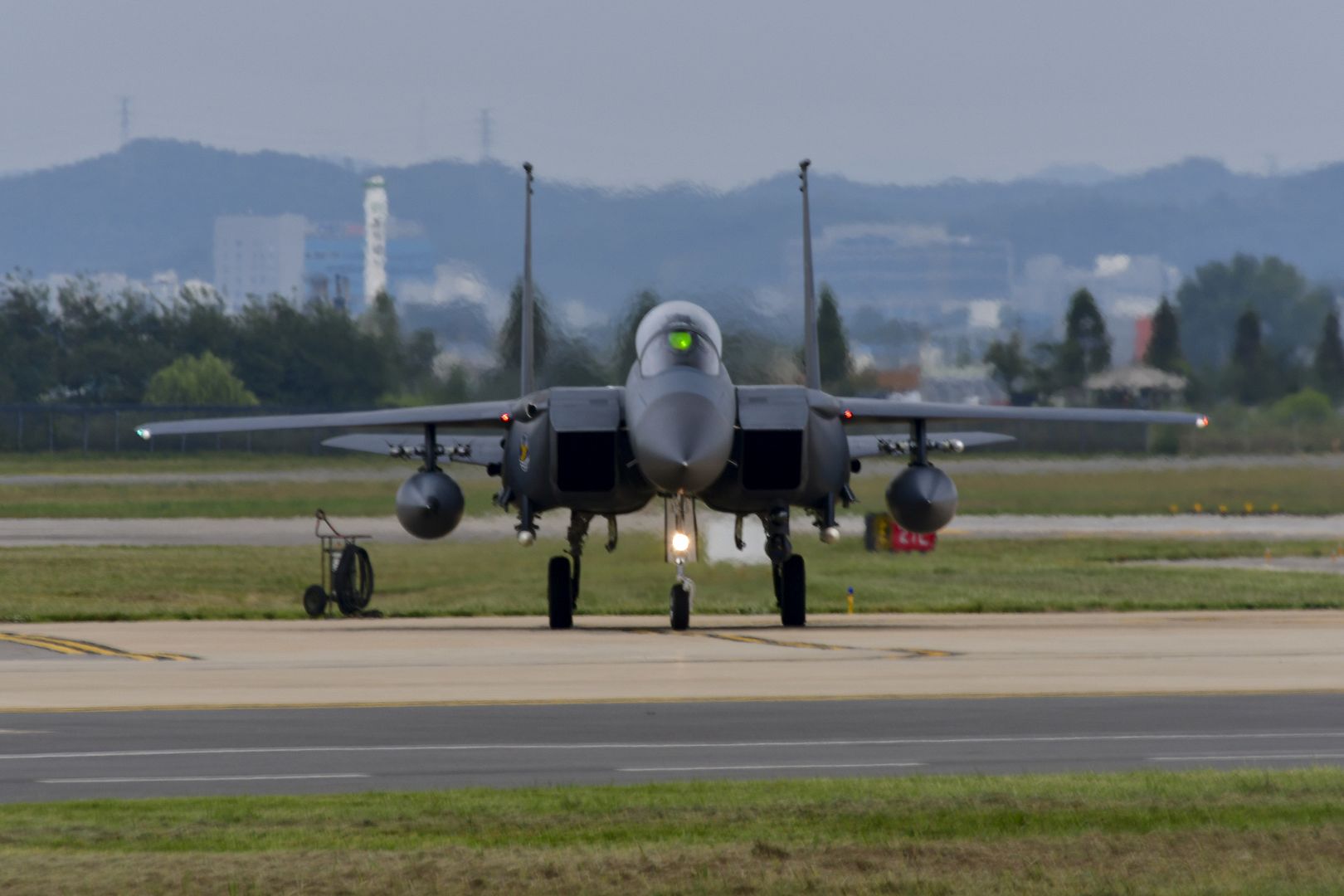
A U.S. Air Force B-1B Lancer deployed to Andersen Air Base, Guam, is flanked by two F-15K Slam Eagles assigned to Daegu Air Base, Republic of Korea, during flight over ROK skies Sept. 21, 2016. The flight was the closest a B-1 has ever flown to the border between the ROK and North Korea. The B-1 is the backbone of the U.S. long-range bomber mission and is capable of carrying the largest payload of both guided and unguided weapons in the Air Force inventory. (Republic of Korea air force photo by Chief Master Sgt. Kim, Kyeong Ryul)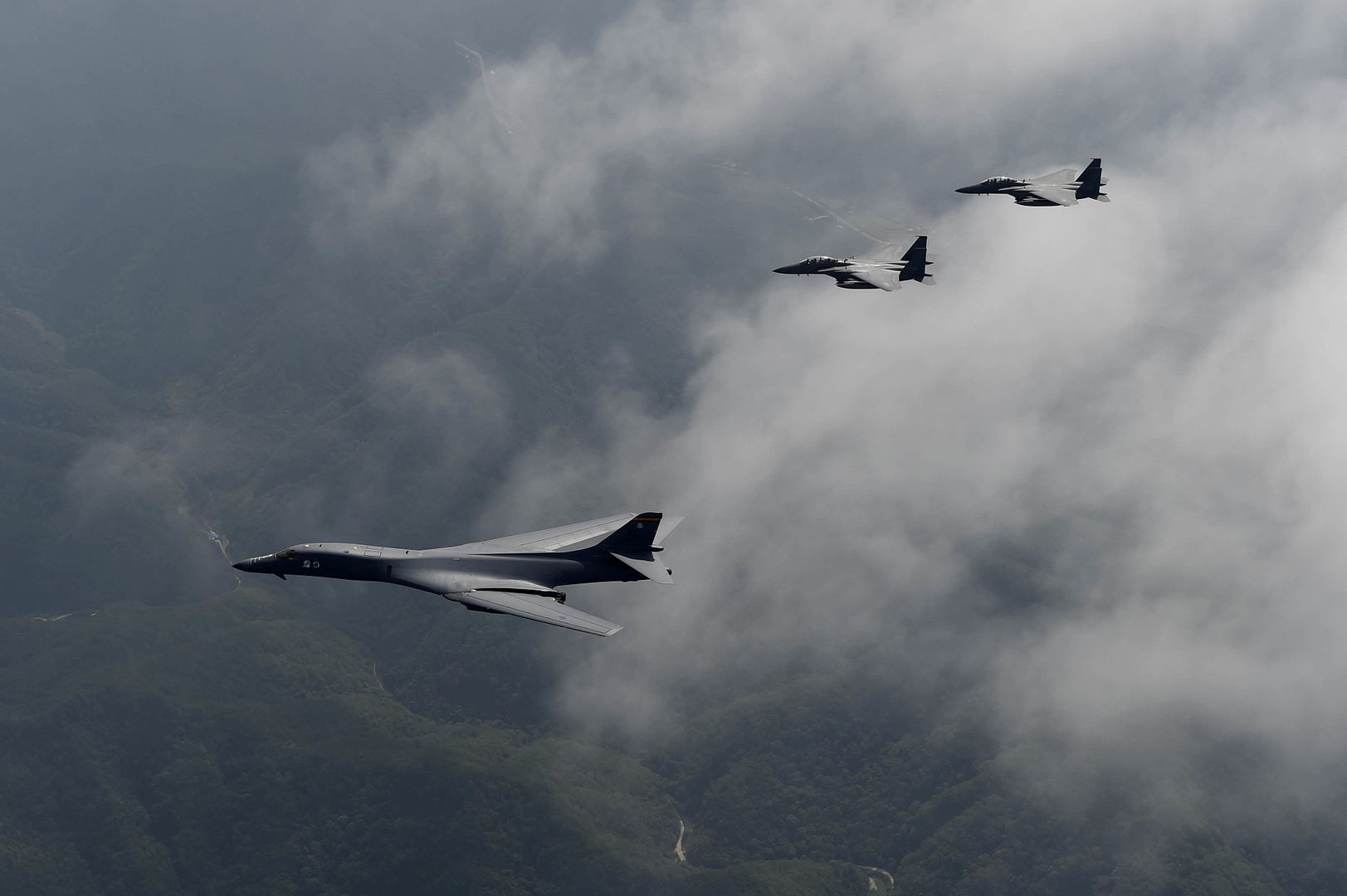
A U.S. Air Force B-1B Lancer deployed to Andersen Air Base, Guam, is flanked by two F-15K Slam Eagles assigned to Daegu Air Base, Republic of Korea, during flight over ROK skies Sept. 21, 2016. The flight was the closest a B-1 has ever flown to the border between the ROK and North Korea. The B-1 is the backbone of the U.S. long-range bomber mission and is capable of carrying the largest payload of both guided and unguided weapons in the Air Force inventory. (Republic of Korea air force photo by Chief Master Sgt. Kim, Kyeong Ryul)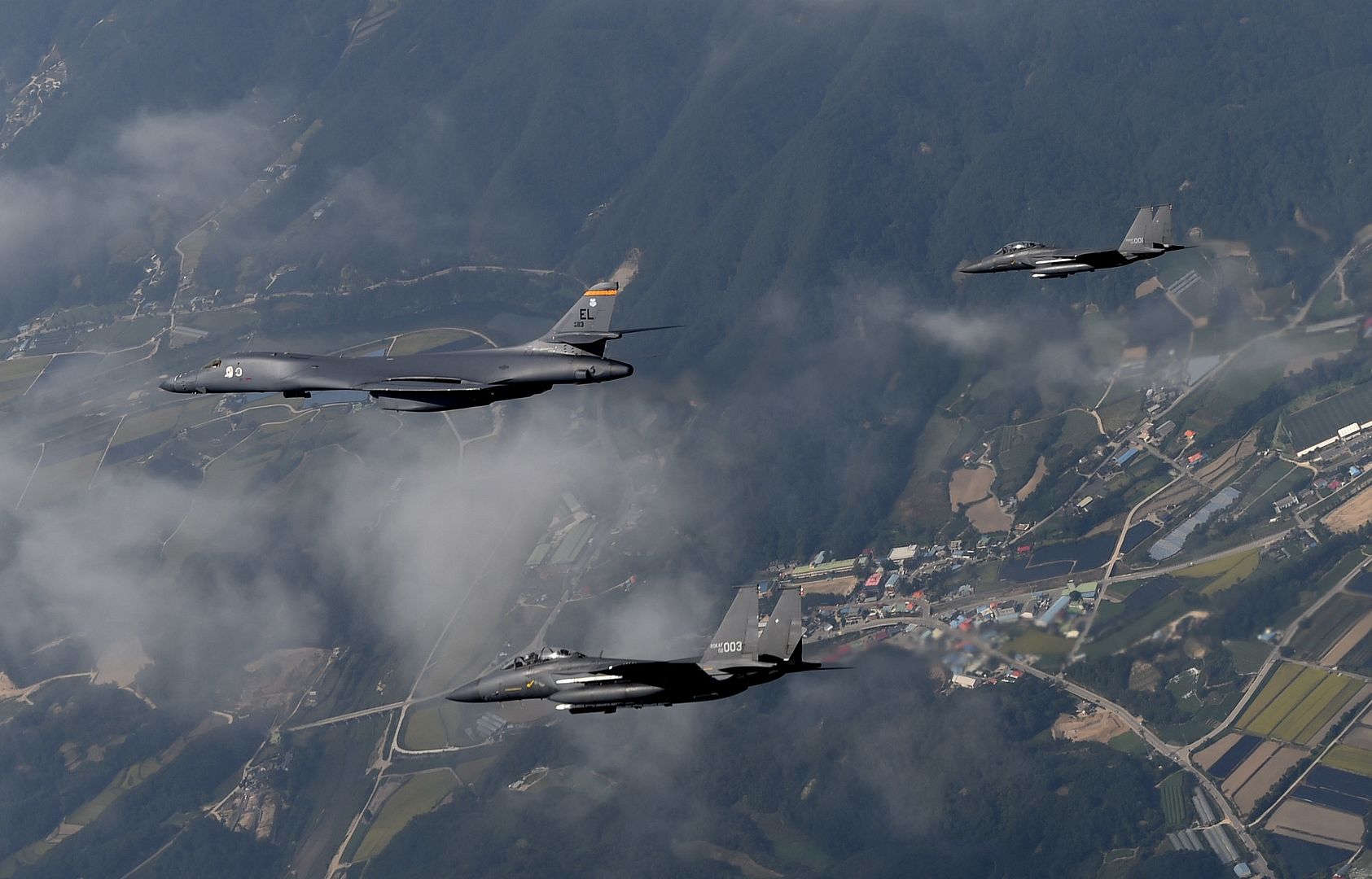
Two U.S. Air Force B-1B Lancers deployed to Andersen Air Base, Guam, fly over Republic of Korean skies Sept. 21, 2016. The flight was the closest a B-1 has ever flown to the border between the ROK and North Korea. The B-1 is the backbone of the U.S. long-range bomber mission and is capable of carrying the largest payload of both guided and unguided weapons in the Air Force inventory. (Republic of Korea air force photo by Chief Master Sgt. Kim, Kyeong Ryul)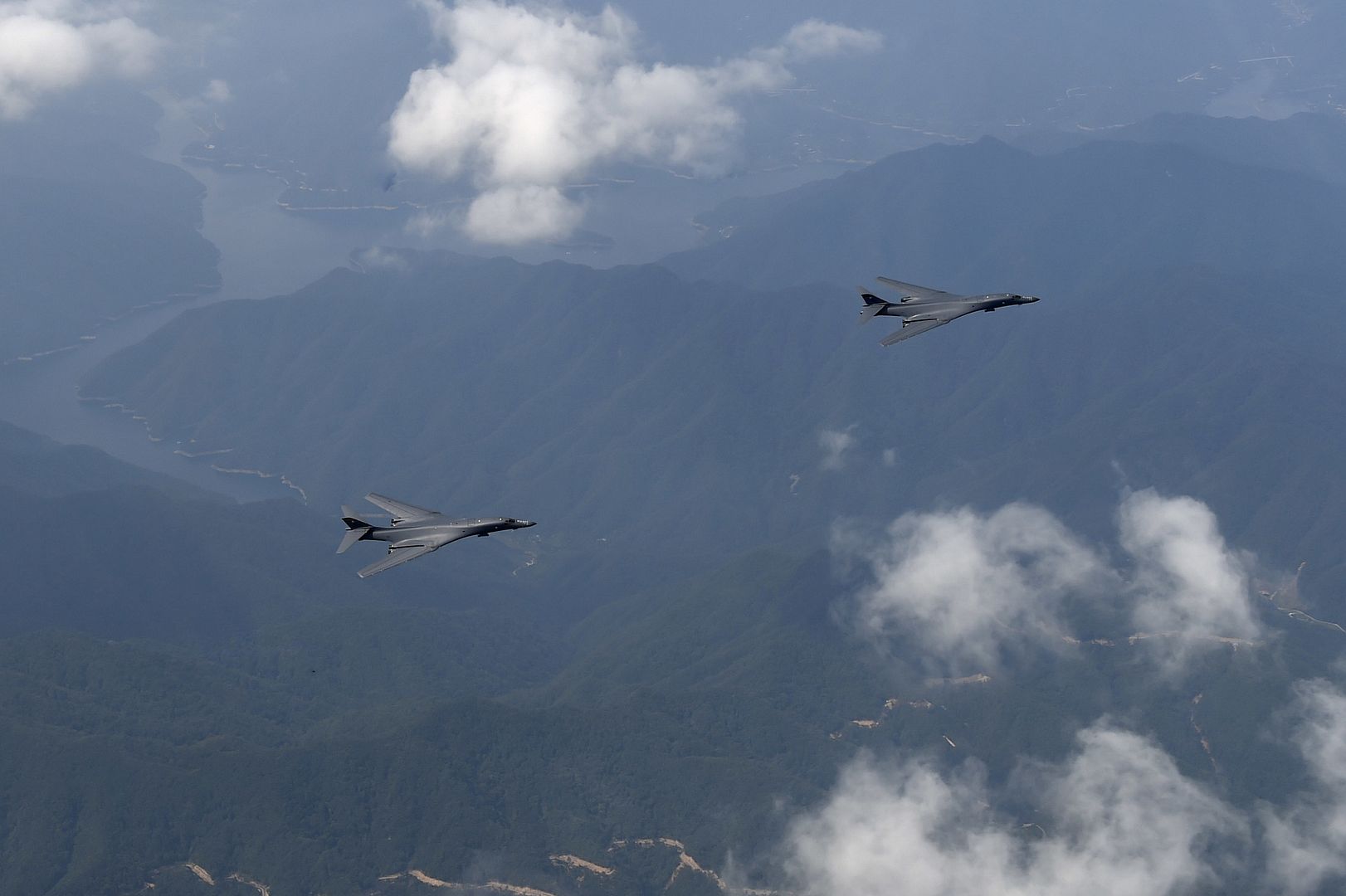
20 September 2016 Press Release
Azores airlines which is fully owned by Sociedade A?oreana de Transportes A?reos (SATA) is modernizing its short-haul and transatlantic fleet with the A321neo and by 2019 with the longer range A321LR. The decision follows a growth strategy to expand into new transatlantic routes.
Azores airlines has been an Airbus customer since 1999 operating seven A310, A320 and A330 Airbus aircrafts across Europe, Canada and North America.
?Our mission is to bring the Azores to the world and the world to the Azores and we are happy to be investing in the Airbus A321neo aircraft to continue achieving this,? says Paulo Menezes, CEO of SATA Group. ?The A321LR passenger comfort, performance, superior range and fuel efficiency match our long haul as well as regional needs. We have a vision of being ever stronger and more competitive in a demanding global world and also of being able to build an airline of excellence that can make its mark in the world of international commercial aviation and gradually and consistently conquer market share and visibility for the brand.?
"We are very excited about this order which confirms the A321LR as the single aisle aircraft of choice for transatlantic and regional routes,? said John Leahy, Chief Operating Officer Customers. ?No other single aisle aircraft can match the A321LR?s performance, fuel efficiency and productivity and with its wider fuselage passengers will also enjoy the most comfortable cabin experience.
The A321LR, the latest member of the market leading A320neo Family, will be able to fly longer routes of up to 4,000 nm. The A321LR will provide additional flexibility as it will have the longest range of any single aisle airliner, making it ideally suited to transatlantic routes and enable airlines to tap into new long haul markets which were not previously accessible with current single aisle aircraft. First deliveries will start in 2019.
The A320neo Family incorporates latest technologies including new generation engines and Sharklet wing tip devices, which together deliver more than 15 percent in fuel savings from day one and 20 percent by 2020 with further cabin innovations. With nearly 4,800 orders received from 87 customers since its launch in 2010, the A320neo Family has captured some 60 percent share of the market.
-
 Main AdminEDWARDS AIR FORCE BASE, Calif. --
Main AdminEDWARDS AIR FORCE BASE, Calif. --
A historic aircraft with close ties to Edwards Air Force Base returned to its roots after more than six decades Monday morning.
The XB-47A Stratojet bomber, an icon of aerospace history, returned to Edwards Air Force Base at approximately 9 a.m., arriving disassembled on several flatbed trucks.
The aircraft entered the base on Rocket Site road, then proceeded across Rogers Dry Lake to its temporary home on North Base for reassembly and restoration by Air Force Flight Test Museum volunteers.
George Welsh, AFFT Museum director, said the restoration will be done in stages.
?The assembly and external restoration of the aircraft should take about one year,? he said.
Once the aircraft is assembled and cleaned up, it will be painted and ready for display at the museum. Then the restoration team can go to work refurbishing the internal areas of the plane ? like the cockpit and bomb bays ? that will be seen by the public.
?It will be an ongoing effort,? he said. ?I think it would be really cool for visitors to see volunteers restoring the cockpit.?
The XB-47A was the precursor to the U.S. Air Force's strategic bomber aircraft family, to include the B-52 Stratofortress, B-1 Lancer and B-2 Spirit. Its multi-engine and swept wing profile were major innovations in post-World War II combat jet design, and contributed to the development of modern commercial jet airliners.
This XB-47 is the earliest survivor of the B-47 series and served as one of two experimental test airframes. The Air Force accepted the airframe December 1948 and logged almost 100 hours of test flights with the contractor, Boeing, and more than 237 for the Air Force. Testing included flight time at Edwards.
There were only two XB-47 prototype aircraft ever built, and both were test flown at Edwards. However the number one XB-47, 46-065, was disassembled and eventually scrapped by the Air Force in 1954, making the number two prototype, 46-066, the sole surviving XB-47.
After completing flight testing at Edwards from 1948 to 1954, tail number 46-066 spent the next six decades on static display at Chanute Air Force Base, Ill.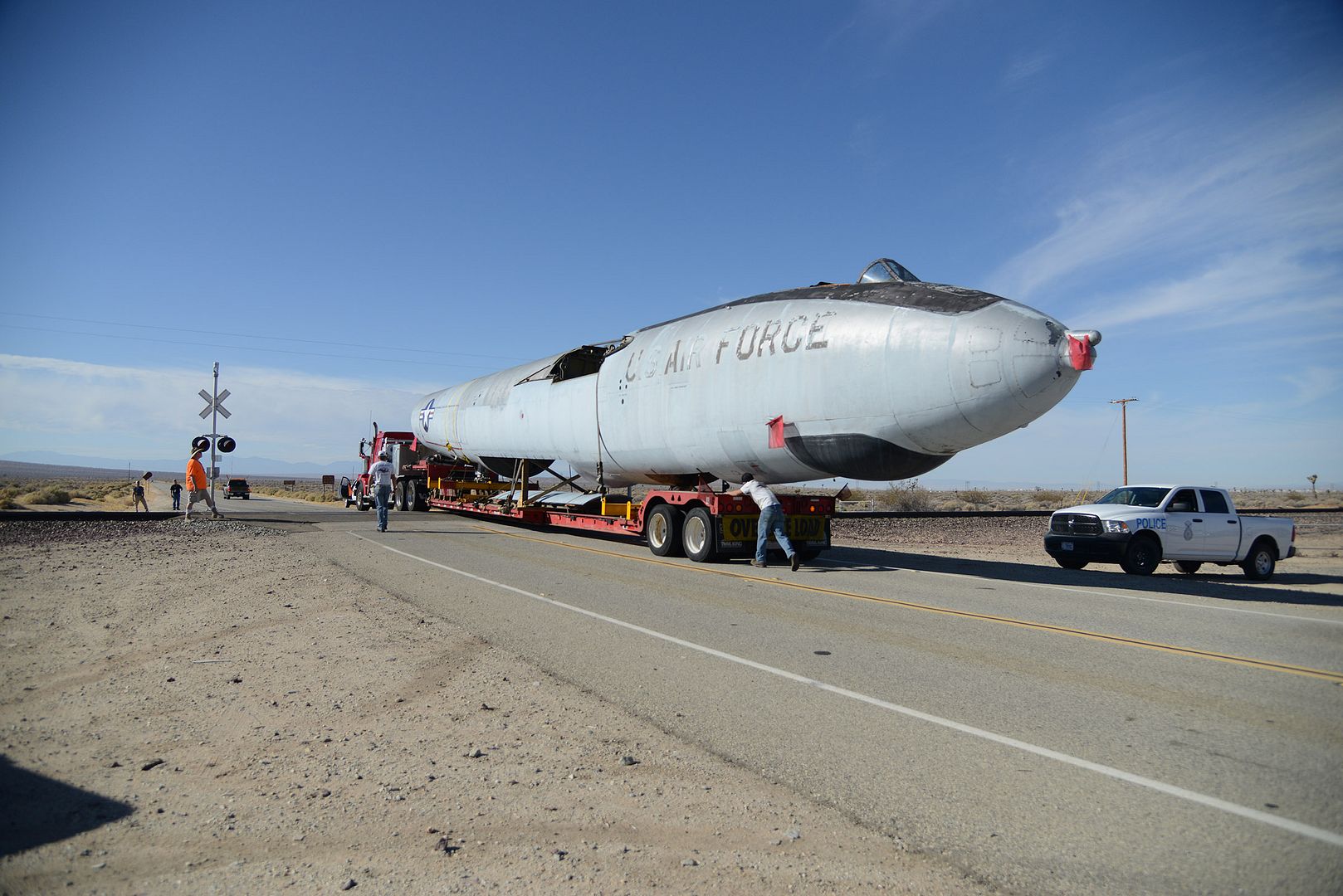
20 September 2016 Headline news
The commonality feature of Airbus? fly-by-wire jetliner families is marking 25 years of operations, providing benefits that range from enhanced fleet deployment, improved efficiency and better scheduling for airlines to greater productivity, proficiency and job satisfaction for pilots.
Airbus? A320 was the first fly-by-wire airliner to enter commercial service, providing a cornerstone in the company?s forward-looking approach that brought cockpits and flight controls into the modern era. The commonality results from Airbus? continuous application of similarities in cockpit layout and functionality ? along with shared aircraft handling characteristics and similarity in systems ? across its product line of fly-by-wire aircraft.
Today, Airbus commonality covers everything from the single-aisle A320 Family (composed of the A318, A319, A320 and A321) to the widebody A330, A340, A350 XWB and the double-deck A380.
Single Fleet Flying: a foundation of Airbus commonality
Within the twin-engine A320 Family, flight crew members can perform Single Fleet Flying ? easily shifting among the various aircraft models, thereby flying multiple versions with the same type rating.
Advantages of Single Fleet Flying include the optimum use of pilot resources by airlines, reduced training requirements for flight crews as well as related lower costs for airlines, and increased flight opportunities for pilots.
These benefits extend to the latest A320neo (new engine option) variants as well. The world?s airworthiness authorities have concluded that even with the installation of NEO?s new powerplants, the aircraft can be considered variants of the A320ceo (current engine option) family members ? allowing all versions to be operated by pilots with the same A320 type rating.
Single Fleet Flying also applies within other Airbus product line segments, such as the A330, covering its A330-200 and A330-300 passenger models, the A330-200F freighter?and in the future, the A330neo (new engine option) version.
And while the long-range A330 and next-generation A350 XWB have different type certificates, their handling characteristics are so similar that they have been granted a Common Type Rating from the airworthiness authorities. To transition from an A330 to the A350 XWB, pilots use laptop-based systems and ground-based trainers, eliminating the mandatory need for expensive full-flight simulators and a full type rating check ride. The pilots can then be assigned to both the A330 and A350 under terms of a single licence endorsement ? another example of Single Fleet Flying that results directly from Airbus commonality.
Cross Crew Qualification, and the advantages of Mixed Fleet Flying
Commonality also streamlines the requirements in transitioning from one Airbus jetliner product type to another. For instance, an A320-rated pilot who is going to qualify on the very large, four-engine A380 is given shortened ground training courses and only five simulator sessions; whereas pilots without previous Airbus fly-by-wire experience would require more extensive training ? both in ground school and with flight simulators.
This commonality-related aspect within the Airbus product line is called Cross Crew Qualification, and it enhances the opportunities for a pool of multi-qualified pilots to operate, for example, both single-aisle and widebody Airbus airliners in what is referred to as Mixed Fleet Flying.
Significant cost savings and more flexibility for airlines
Commonality enables airlines to create a truly integrated fleet management structure, offering flexibility in the scheduling rosters for their crews and improving the utilisation of their aircraft ? such as seamlessly bringing in a longer-fuselage A321 on a route where passenger volume has grown beyond the capacity of an A320.
Gerrit Van Dijk, who works in Technical Marketing - Aircraft Operations for Airbus Customer Affairs, noted that it is not uncommon for a pilot to experience six to eight changes in the aircraft types flown during a career, involving typical retraining costs of $30,000 for each changeover. ?Add some 1.5 months of pilot downtime for each change, and it becomes obvious that the combined costs to airlines is several billion dollars every year,? he said. ?However, those with Airbus fleets can reduce pilot retraining costs by two-thirds on average.?
According to Van Dijk, the advantages of commonality not only apply to large main-line carriers with significant aircraft fleets; smaller airlines in particular can benefit from powerful economies of scale that previously were the privilege of big operators. Depending on the mix of fleet and the nature of an airline?s flight operations, annual revenue flying time per pilot may increase by 5-15 percent with Single Fleet Flying and Mixed Fleet Flying, he added.
A better work environment and more proficiency for pilots
Pilots appreciate Airbus commonality for the opportunities of a more varied work environment, including the ability to fly on a larger part of an airline?s route network, while enjoying better mobility within their airline and across the job market, Van Dijk explained.
He cited the example of pilots who alternate long-haul and short-range trips by applying Single Fleet Flying and Mixed Fleet Flying. These flight crew personnel have the possibility to perform more takeoffs and landings for proficiency, while enabling a better work and life balance compared with being assigned only long-haul flying.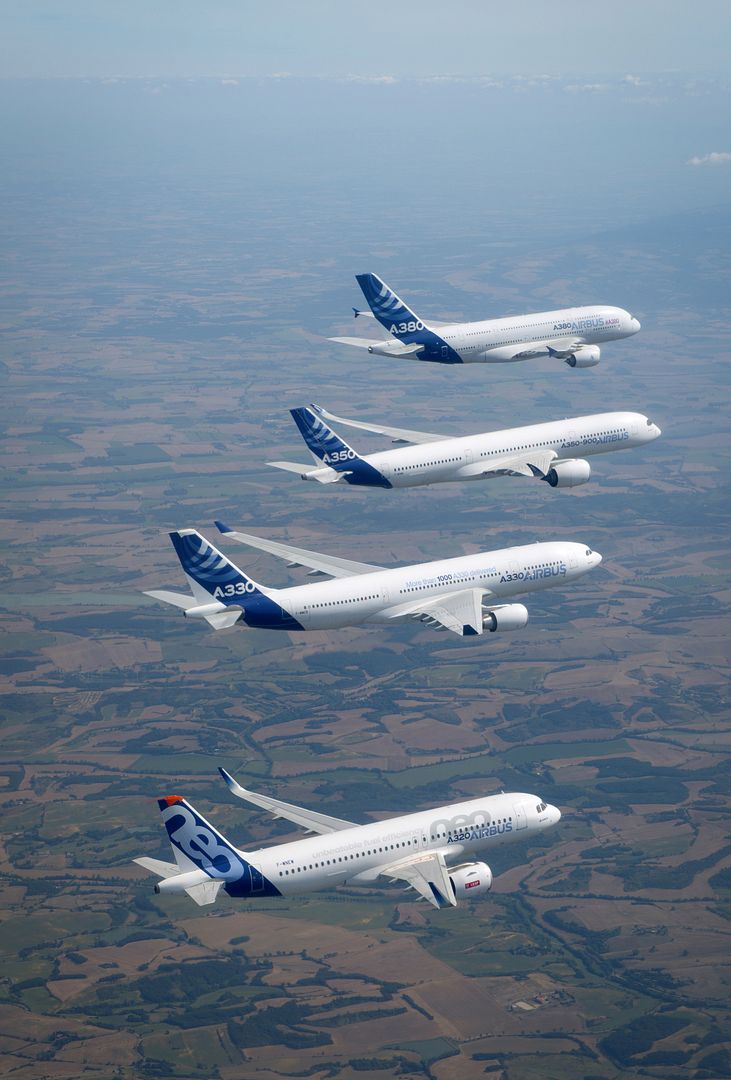
-
 Main AdminPHILIPPINE SEA (Sept. 21, 2016) Marines, assigned to the Flying Tigers of Marine Medium Tiltrotor Squadron (VMM) 262, conduct maintenance on a CH-53E Super Stallion aboard amphibious assault ship USS Bonhomme Richard (LHD 6) as part of Valiant Shield 2016 (VS16). VS16 is a biennial, U.S.-only, field training exercise (FTX) with a focus on integration of joint training among U.S. forces. This training enables real-world proficiency in sustaining joint forces through detecting, locating, tracking and engaging units at sea, in the air, on land, and in cyberspace in response to a range of mission areas. Bonhomme Richard, flagship of the Bonhomme Richard Expeditionary Strike Group, is operating in the Philippine Sea in support of security and stability in the Indo-Asia Pacific region. Bonhomme Richard, flagship of the Bonhomme Richard Expeditionary Strike Group, is operating in the Philippine Sea in support of security and stability in the Indo-Asia Pacific region. (U.S. Navy photo by Mass Communication Specialist 3rd Class William Sykes/Released
Main AdminPHILIPPINE SEA (Sept. 21, 2016) Marines, assigned to the Flying Tigers of Marine Medium Tiltrotor Squadron (VMM) 262, conduct maintenance on a CH-53E Super Stallion aboard amphibious assault ship USS Bonhomme Richard (LHD 6) as part of Valiant Shield 2016 (VS16). VS16 is a biennial, U.S.-only, field training exercise (FTX) with a focus on integration of joint training among U.S. forces. This training enables real-world proficiency in sustaining joint forces through detecting, locating, tracking and engaging units at sea, in the air, on land, and in cyberspace in response to a range of mission areas. Bonhomme Richard, flagship of the Bonhomme Richard Expeditionary Strike Group, is operating in the Philippine Sea in support of security and stability in the Indo-Asia Pacific region. Bonhomme Richard, flagship of the Bonhomme Richard Expeditionary Strike Group, is operating in the Philippine Sea in support of security and stability in the Indo-Asia Pacific region. (U.S. Navy photo by Mass Communication Specialist 3rd Class William Sykes/Released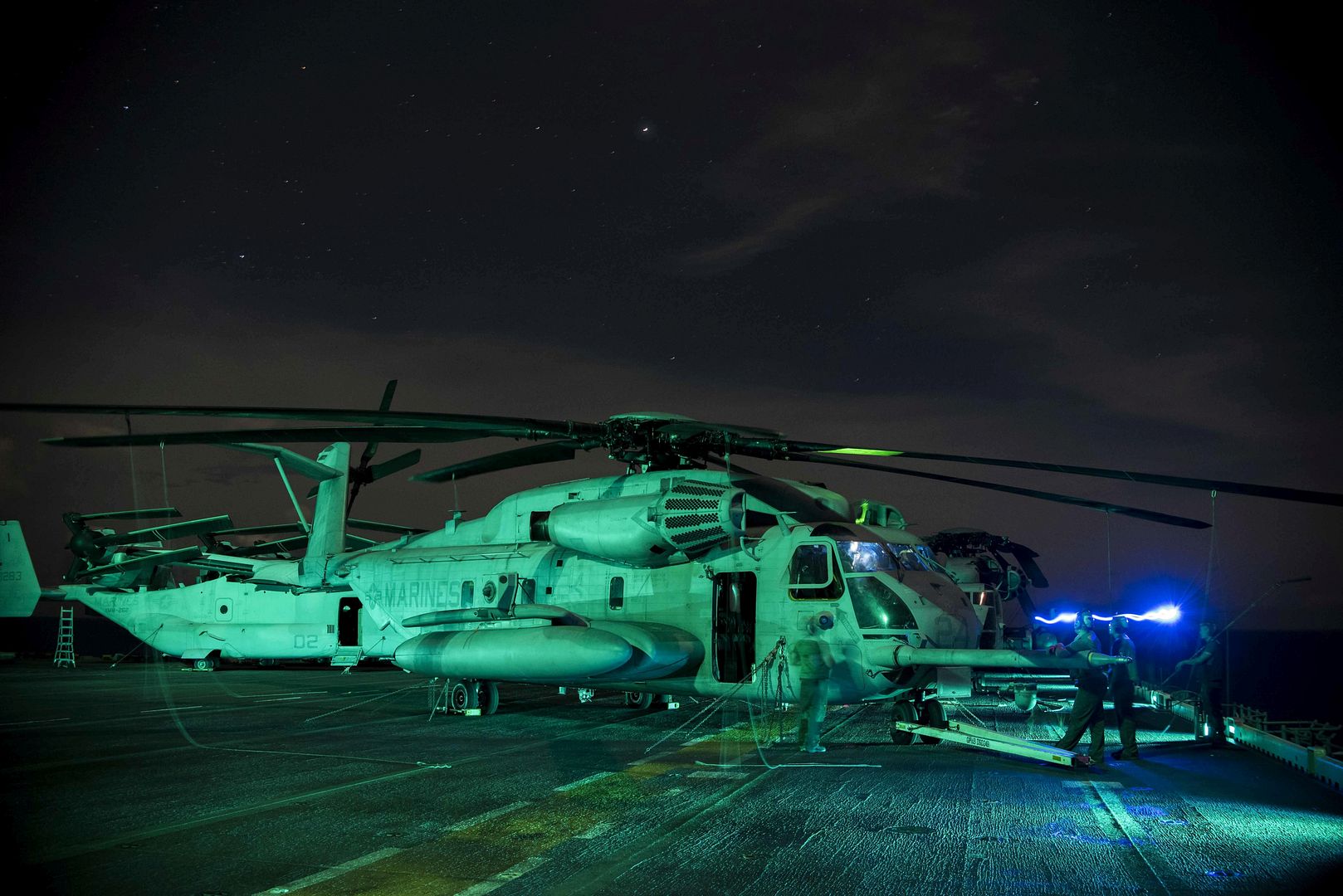
A U.S. Air Force KC-135, from the 185th Air Refueling Wing, Iowa Air National Guard, is refueling a U.S. Air Force F-16 from the South Dakota Air National Guard?s 114th Fighter Wing, based in Sioux Falls, SD while above Lake Andes, South Dakota, on September 22, 2016.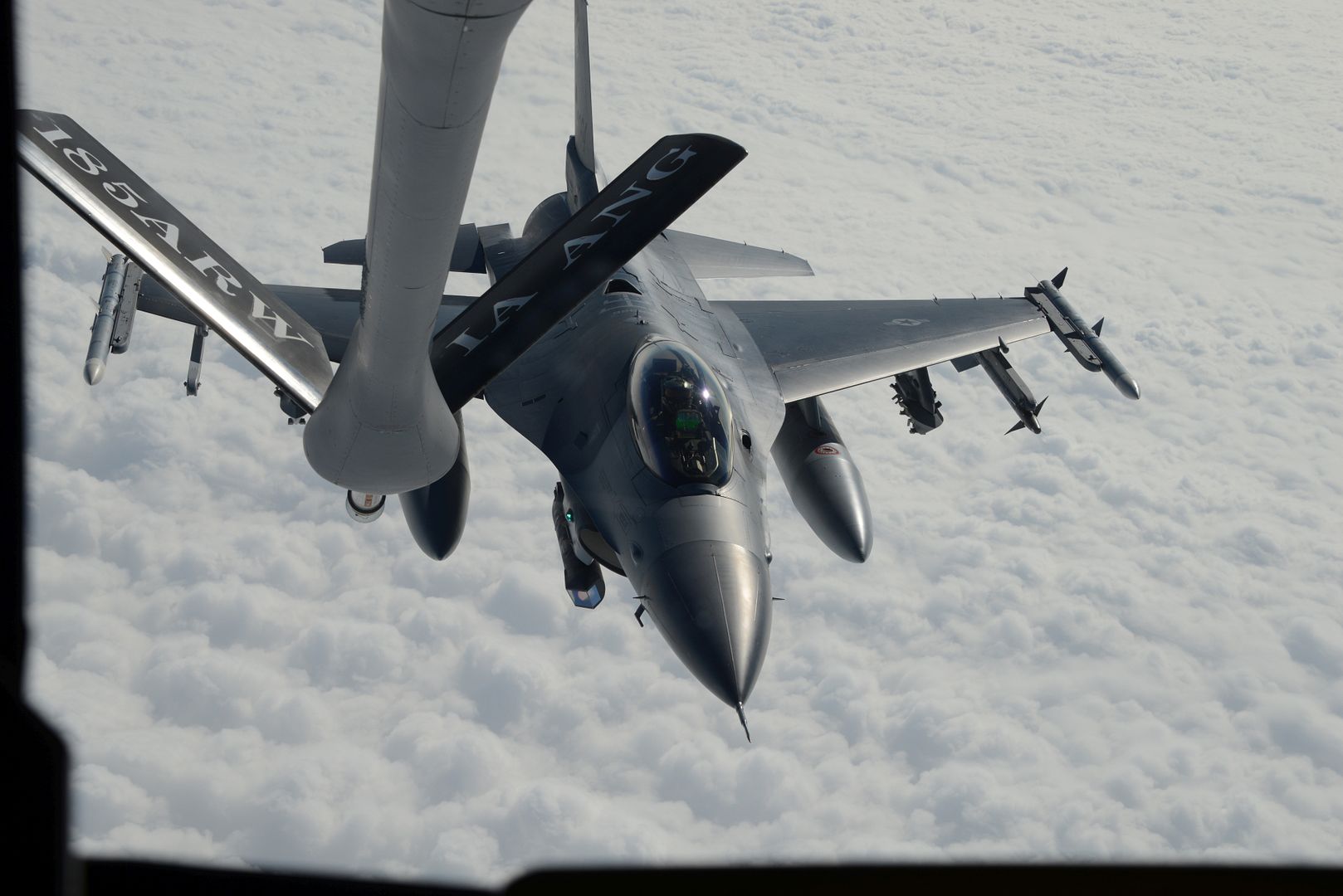
A U.S. Air Force F-16 from the South Dakota Air National Guard?s 114th Fighter Wing, based in Sioux Falls, SD flies off the wing of a U.S. Air Force KC-135 while above Lake Andes, South Dakota, on September 22, 2016.
U.S. Air National Guard photo's by Master Sgt. Vincent De Groot 185th ARW Wing PA
-
 Main AdminGULF OF PANAMA (Sept. 22, 2016) ? A Chilean Toro Dauphine (Dolphin) HH-65 lands on board USNS Spearhead (T-EPF 1), embarking multinational force staff participating in UNITAS 2016. UNITAS is an annual multi-national exercise that focuses on strengthening our existing regional partnerships and encourages establishing new relationships through the exchange of maritime mission-focused knowledge and expertise throughout the exercise. (U.S. Navy Photo by Mass Communication Specialist 1st Class Jacob Sippel/RELEASED)
Main AdminGULF OF PANAMA (Sept. 22, 2016) ? A Chilean Toro Dauphine (Dolphin) HH-65 lands on board USNS Spearhead (T-EPF 1), embarking multinational force staff participating in UNITAS 2016. UNITAS is an annual multi-national exercise that focuses on strengthening our existing regional partnerships and encourages establishing new relationships through the exchange of maritime mission-focused knowledge and expertise throughout the exercise. (U.S. Navy Photo by Mass Communication Specialist 1st Class Jacob Sippel/RELEASED)
Two F-22 Raptors from Elmendorf Air Force Base, Ala. arrived on Sept. 22, 2016 to Travis Air Force Base, Calif. to perform in the Wings over Wine Country Airshow in Sonoma, Calif. The F-22s are part of the Air Combat Command F-22 Demonstration Team from Langley Air Force Base, Va., and will perform precision aerial maneuvers demonstrating the unique capabilities of the fifth-generation fighter aircraft. (U.S. Air Force photo by Louis Briscese)
U.S. Marines with Marine Fighter Attack Squadron 121 (VMFA-121), 3rd Marine Aircraft Wing, conduct the first ever hot load on the F-35B Lightning II in support of Weapons and Tactics Instructor Course (WTI) 1-17 at Marine Corps Air Station Yuma, Ariz., Sept. 22, 2016. The exercise is part of WTI 1-17, a seven-week training event hosted by Marine Aviation Weapons and Tactics Squadron One (MAWTS-1) cadre. MAWTS-1 provides standardized tactical training and certification of unit instructor qualifications to support Marine Aviation Training and Readiness and assists in developing and employing aviation weapons and tactics. (U.S. Marine Corps photograph by SSgt. Artur Shvartsberg, MAWTS-1 COMCAM)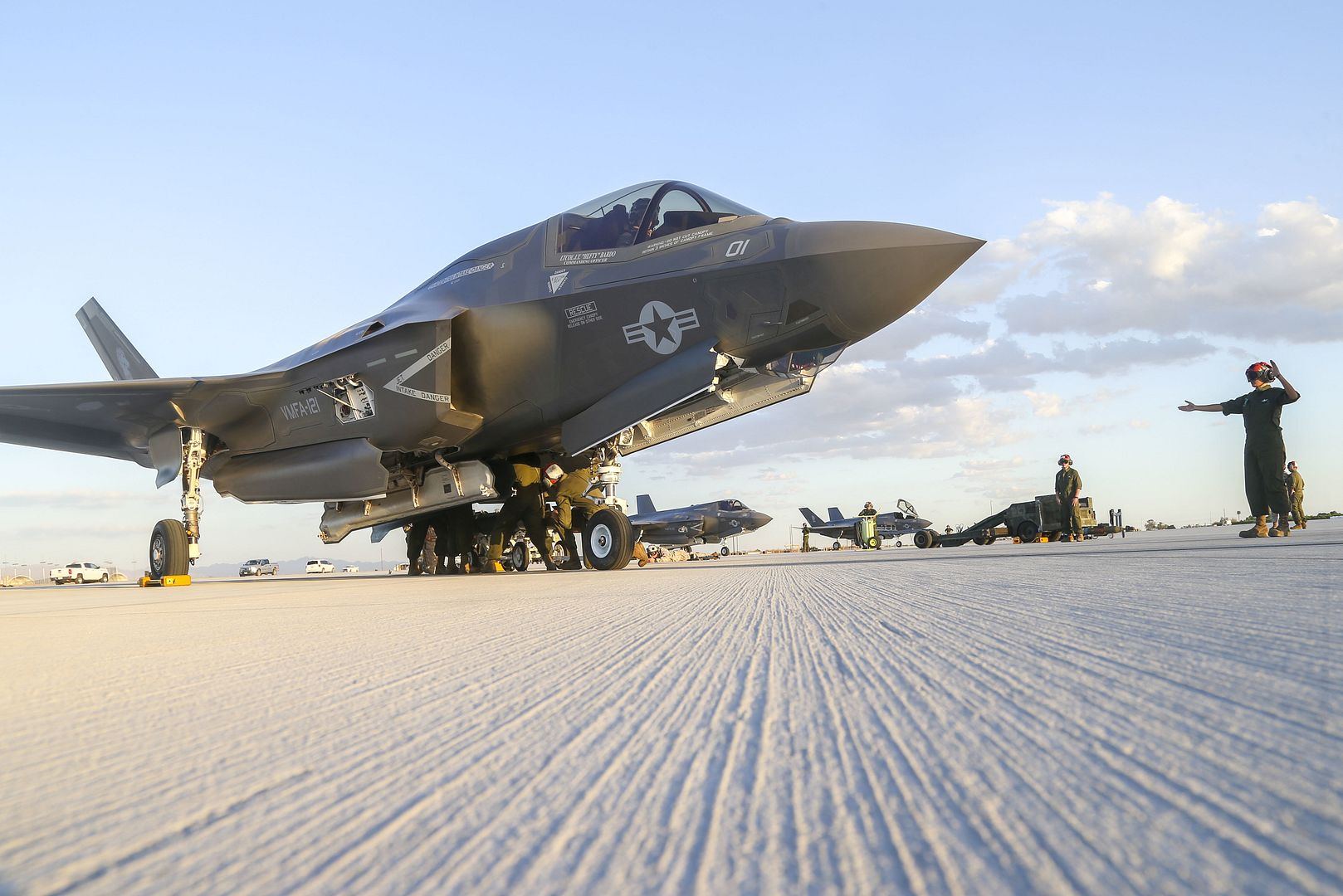
Bret Willat pilots a Grob G-103 Acro sailplane during his ?Sailplane Magic? performance at the 2016 MCAS Miramar Air Show aboard Marine Corps Air Station Miramar, Calif., Sept. 23. Willat?s wife and two sons also work on the team, making them the only known performing air show family. The MCAS Miramar Air Show showcases world-class performers, military flight demonstration teams, the capabilities of the Marine Air-Ground Task Force and celebrates Miramar?s longstanding relationship with the local San Diego community. (U.S. Marine Corps photo by Lance Cpl. Jake McClung/Released)
An AV-8B Harrier demonstrates it?s hovering and maneuvering capabilities during the 2016 MCAS Miramar Air Show aboard Marine Corps Air Station Miramar, Calif., Sept. 23. The Harrier also played a role in the Marine Air-Ground Task Force demonstration. The MCAS Miramar Air Show showcases world-class performers, military flight demonstration teams, the capabilities of the Marine Air-Ground Task Force and celebrates Miramar?s longstanding relationship with the local San Diego community. (U.S. Marine Corps photo by Pfc. Liah Kitchen/Released)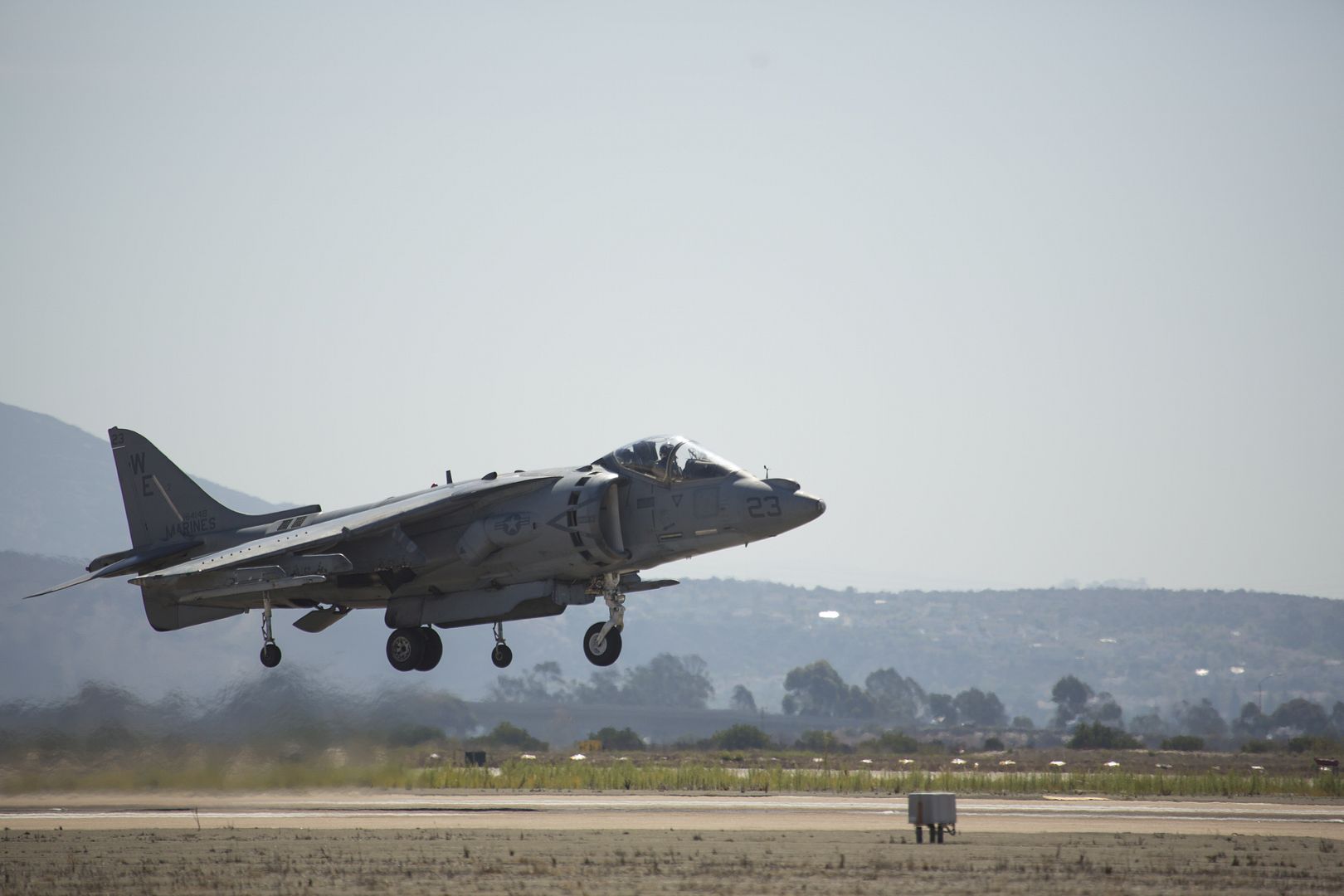
A U.S. Air Force F-16 Viper performs a tactical demonstration and heritage flight during the 2016 MCAS Miramar Air Show aboard Marine Corps Air Station Miramar, Calif., Sept. 23. The heritage flight presents the evolution of the Air Force by flying the current state-of-the-art fighter aircraft in formation with vintage aircraft. The MCAS Miramar Air Show showcases world-class performers, military flight demonstration teams, the capabilities of the Marine Air-Ground Task Force and celebrates Miramar?s longstanding relationship with the local San Diego community. (U.S. Marine Corps photo by Lance Cpl. Harley Robinson/Released)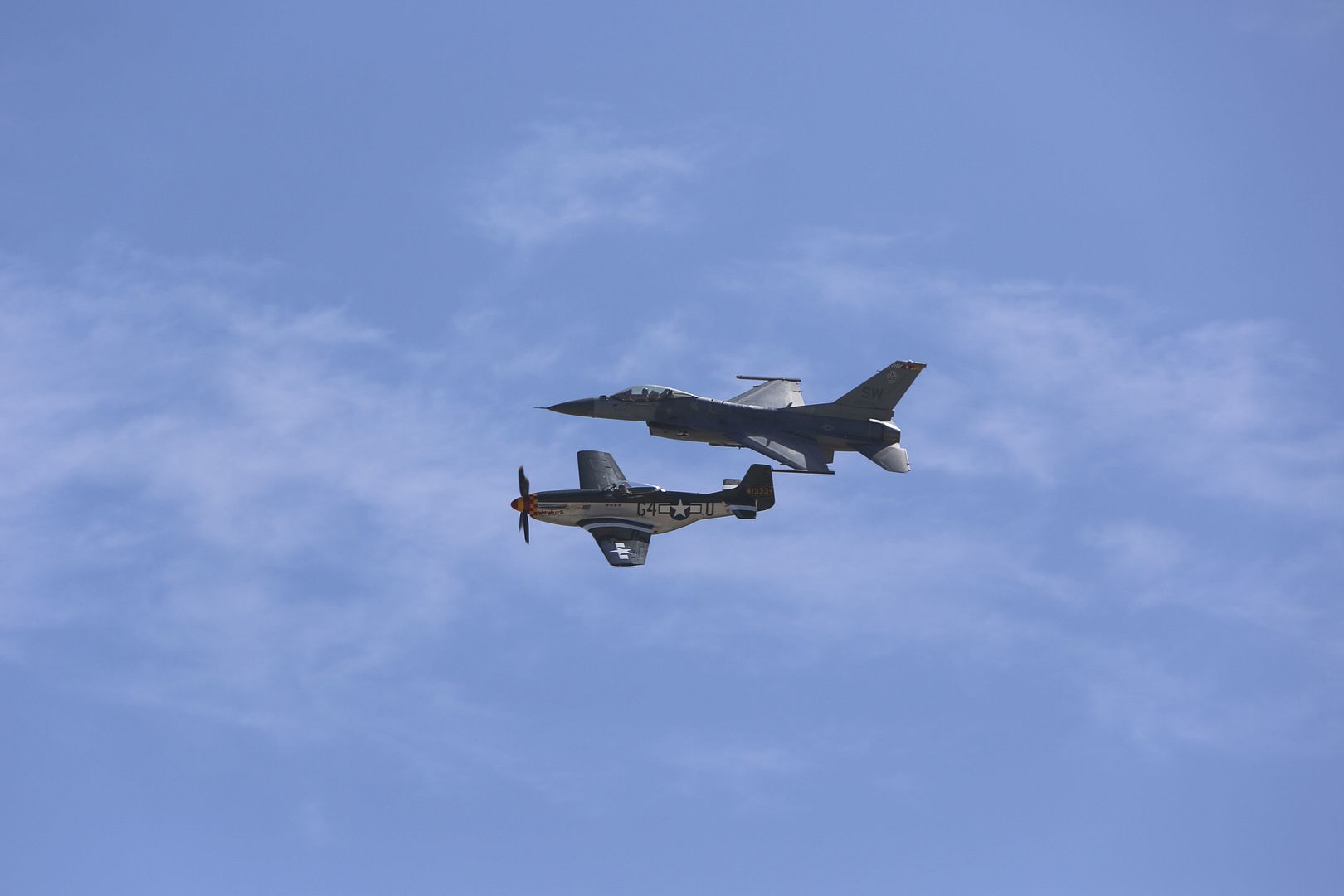
U.S. Navy Blue Angels perform aerial maneuvers during the Marine Corps Community Services (MCCS) sponsored 2016 Air Show aboard Marine Corps Air Station(MCAS) Miramar, San Diego, Calif., Sep 23, 2016. The air show showcases civilian performances and the aerial prowess of the armed forces but also their appreciation of the civilian community's support and dedication to the troops. (U.S. Marine Corps photo by Cpl. Travis Jordan/Released)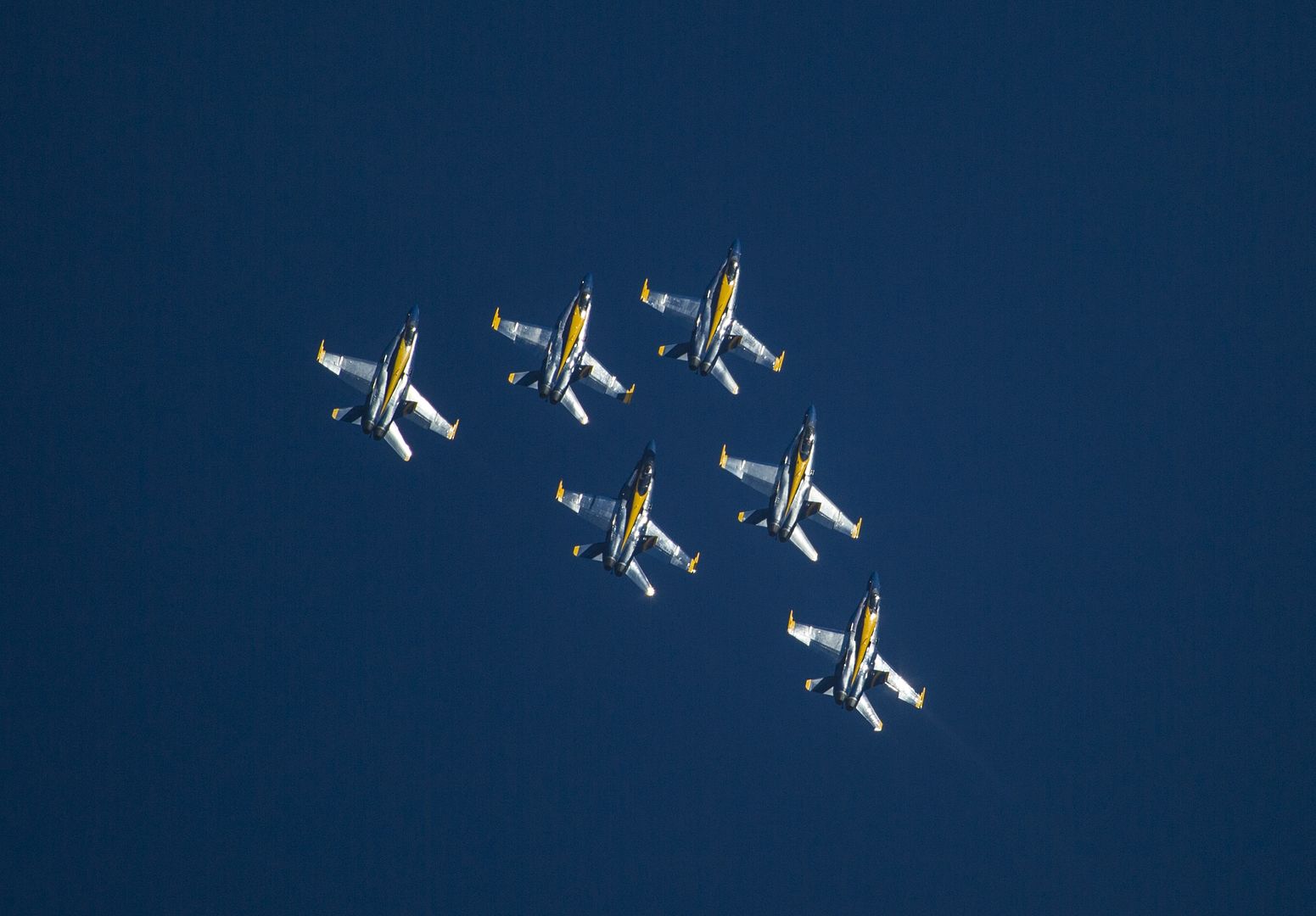
-
 Main AdminAn A-10 Thunderbolt II assigned to the 25th Fighter Squadron shoots a flair during a combat search and rescue demonstration during Air Power Day 2016 at Osan Air Base, Republic of Korea, Sept. 24, 2016. The A-10?s high maneuverability at low altitudes and low speeds makes it an ideal airframe to assist in CSAR operations. (U.S. Air Force photo by Senior Airman Victor J. Caputo)
Main AdminAn A-10 Thunderbolt II assigned to the 25th Fighter Squadron shoots a flair during a combat search and rescue demonstration during Air Power Day 2016 at Osan Air Base, Republic of Korea, Sept. 24, 2016. The A-10?s high maneuverability at low altitudes and low speeds makes it an ideal airframe to assist in CSAR operations. (U.S. Air Force photo by Senior Airman Victor J. Caputo)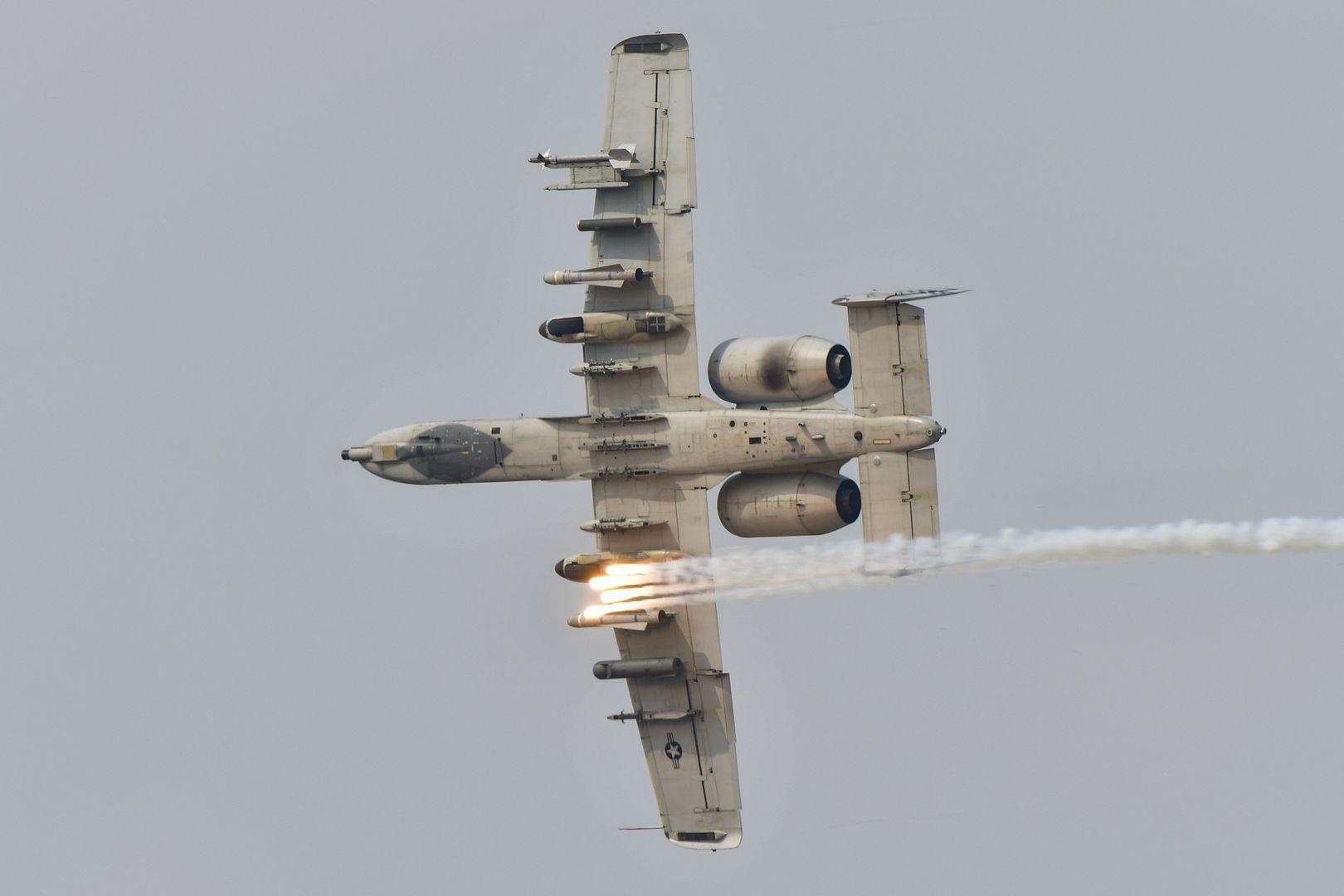
An F-16 Fighting Falcon assigned to the 13th Fighter Squadron, Misawa Air Base, Japan, lands after performing a demonstration during Air Power Day 2016 at Osan Air Base, Republic of Korea, Sept. 24, 2016. The F-16 is a highly maneuverable, multi-role aircraft that has a proven record in air-to-air and air-to-surface combat. (U.S. Air Force photo by Senior Airman Victor J. Caputo)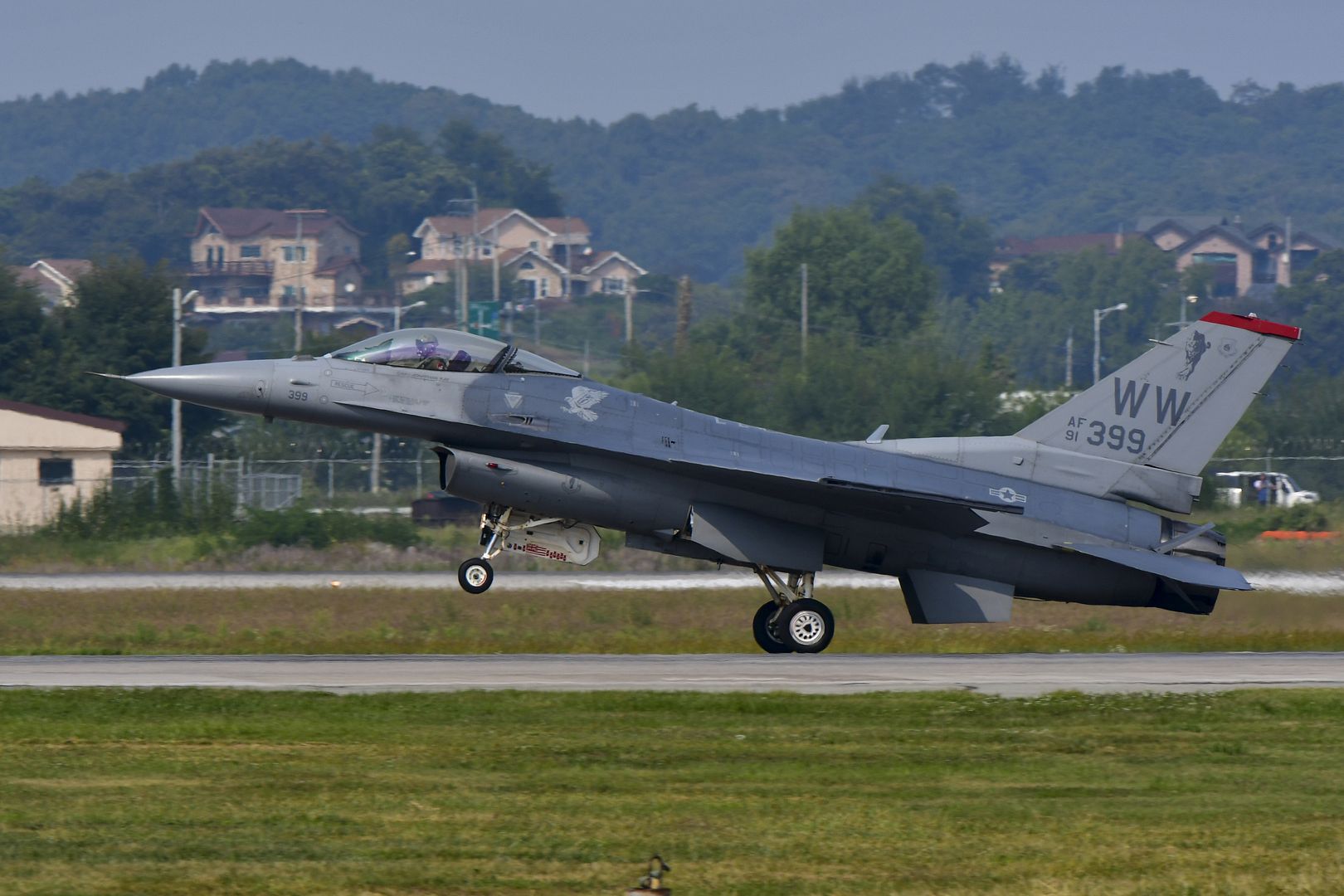
A U.S. Air Force U-2 Dragon Lady performs a fly by during Air Power Day 2016 at Osan Air Base, Republic of Korea, Sept. 24, 2016. The U-2, from the 5th Reconnaissance Squadron, is a high-altitude, all-weather surveillance and reconnaissance aircraft. (U.S. Air Force photo by Staff Sgt. Jonathan Steffen)
A U.S. Air Force U-2 Dragon Lady rests on the flightline during 2016 Air Power Day at Osan Air Base, Republic of Korea, Sept. 24, 2016. Members of the 5th Reconnaissance Squadron decorated the aircraft in remembrance of U.S. Air Force Lt. Col. Ira S. Eadie, 9th Reconnaissance Wing trainer pilot. Eadie passed away Sept. 20 following a U-2 crash during a training mission near Beale Air Force Base, Calif. (U.S. Air Force photo by Senior Airman Dillian Bamman)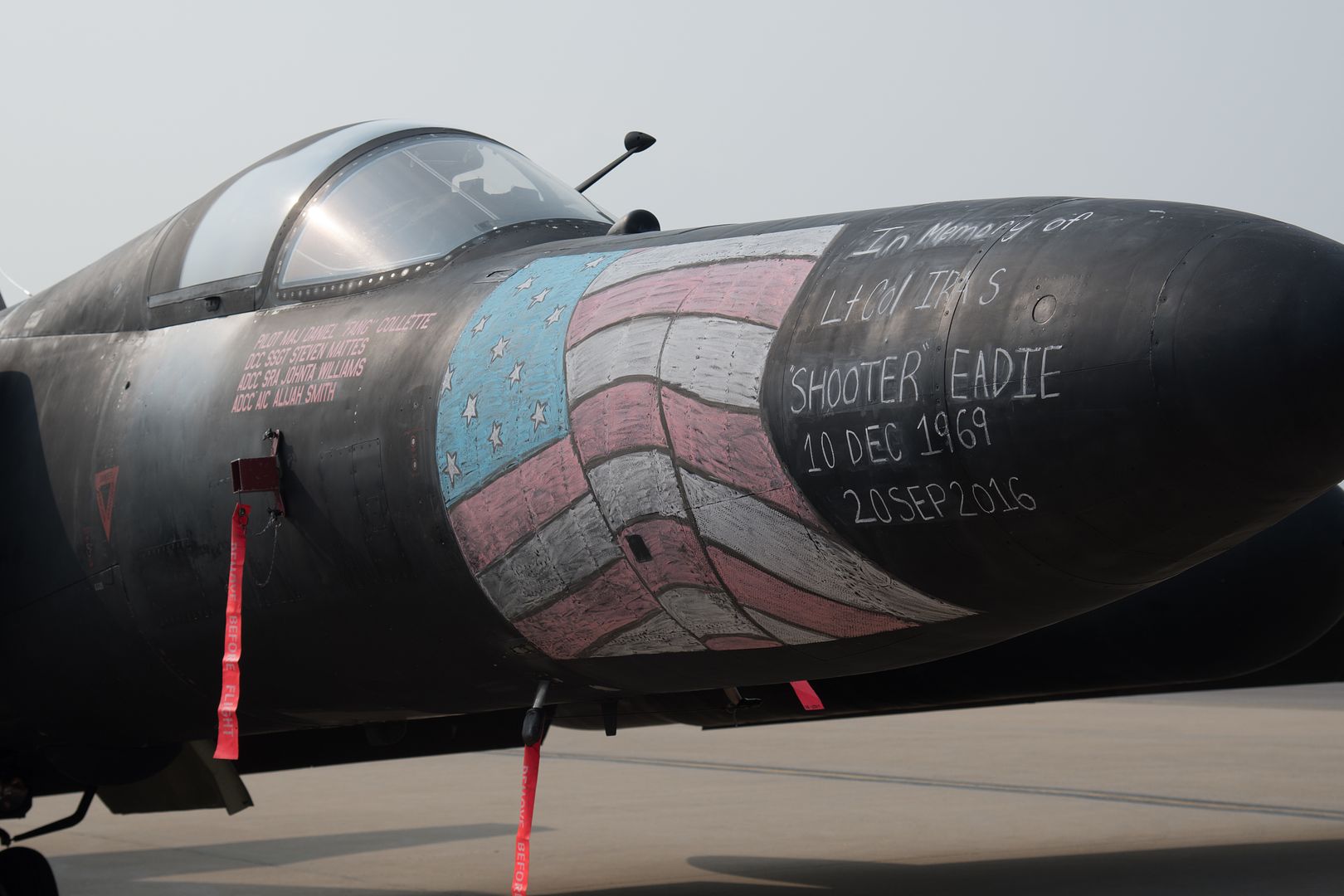
A maintainer with the Republic of Korea air force Black Eagles marshals a ROKAF FA-50 aircraft before flight during Air Power Day 2016 at Osan Air Base, Republic of Korea, Sept. 24, 2016. The Black Eagles are an aircraft acrobatics team that performs across the Pacific during air shows and memorials. (U.S. Air Force photo by Senior Airman Dillian Bamman)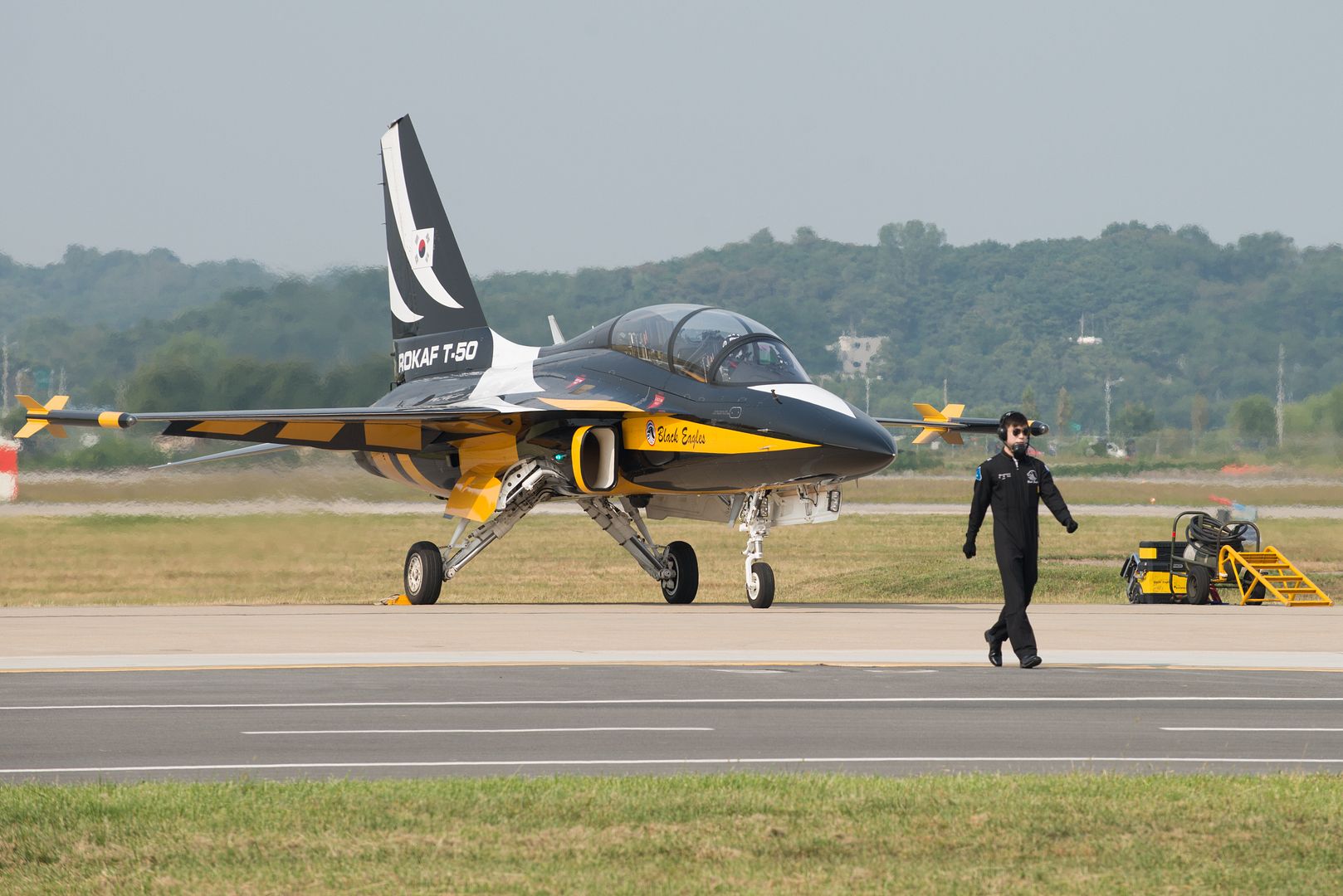
The Republic of Korea air force Black Eagles perform an aerial maneuver during 2016 Air Power Day at Osan Air Base, Republic of Korea, Sept. 24, 2016. The Black Eagles are an aircraft acrobatics team that performs across the Pacific during air shows and memorials. (U.S. Air Force photo by Senior Airman Dillian Bamman)
The Breitling Jet Team performs during the 2016 MCAS Miramar Air Show aboard Marine Corps Air Station Miramar, Calif., Sept. 24. Breitling is a European team that performs aerobatic maneuvers in seven L-39C Albatros aircraft. The MCAS Miramar Air Show showcases world-class performers, military flight demonstration teams, the capabilities of the Marine Air-Ground Task Force and celebrates Miramar?s longstanding relationship with the local San Diego community. (U.S. Marine Corps photo by Pfc. Jacob Pruitt/Released)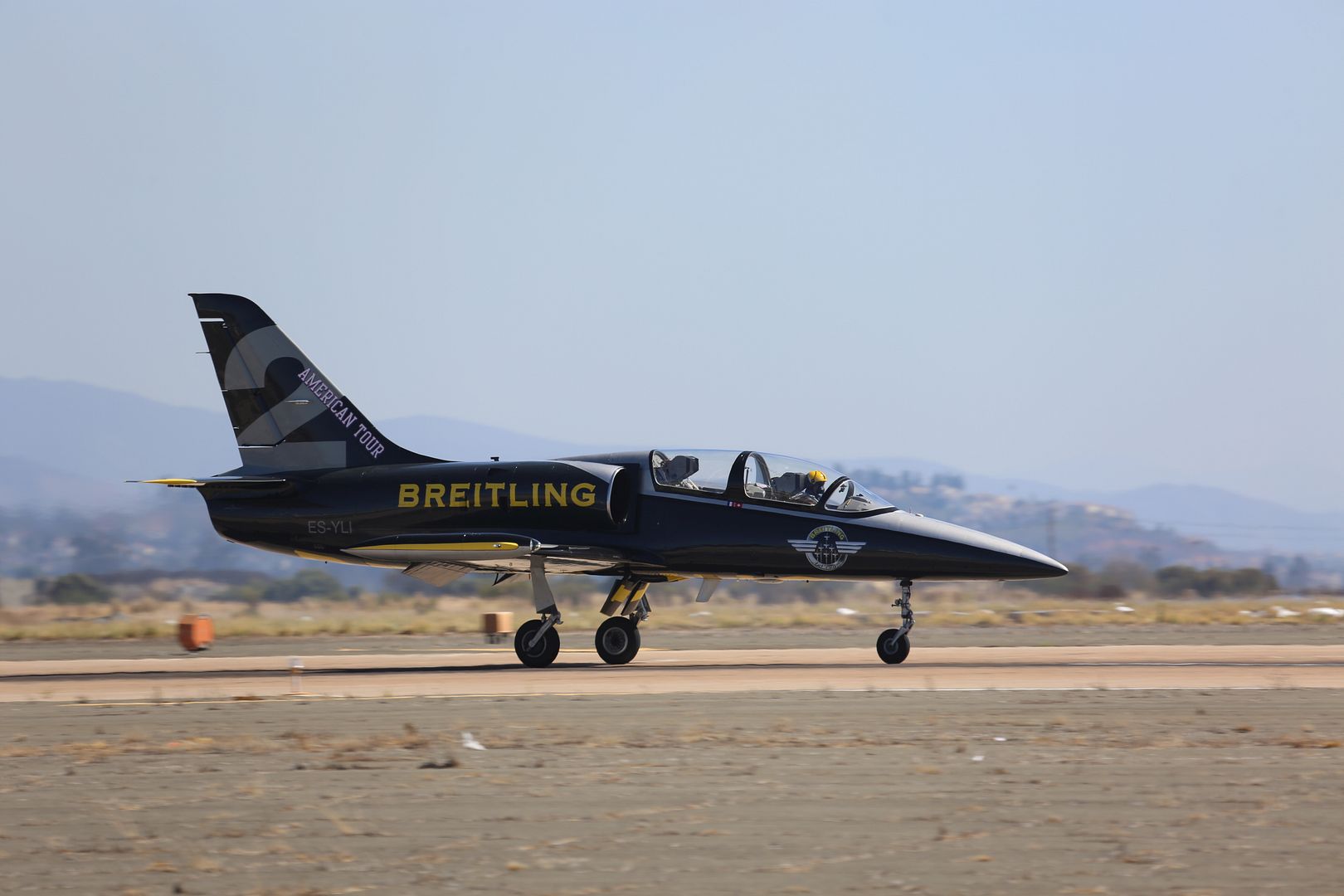
The Breitling Jet Team flies over the crowd while performing at the 2016 MCAS Miramar Air Show aboard Marine Corps Air Station Miramar, Calif., Sept. 24. This was the team?s second year performing in the annual air show. The MCAS Miramar Air Show showcases world-class performers, military flight demonstration teams, the capabilities of the Marine Air-Ground Task Force and celebrates Miramar?s longstanding relationship with the local San Diego community. (U.S. Marine Corps photo by Pfc. Jacob Pruitt/Released)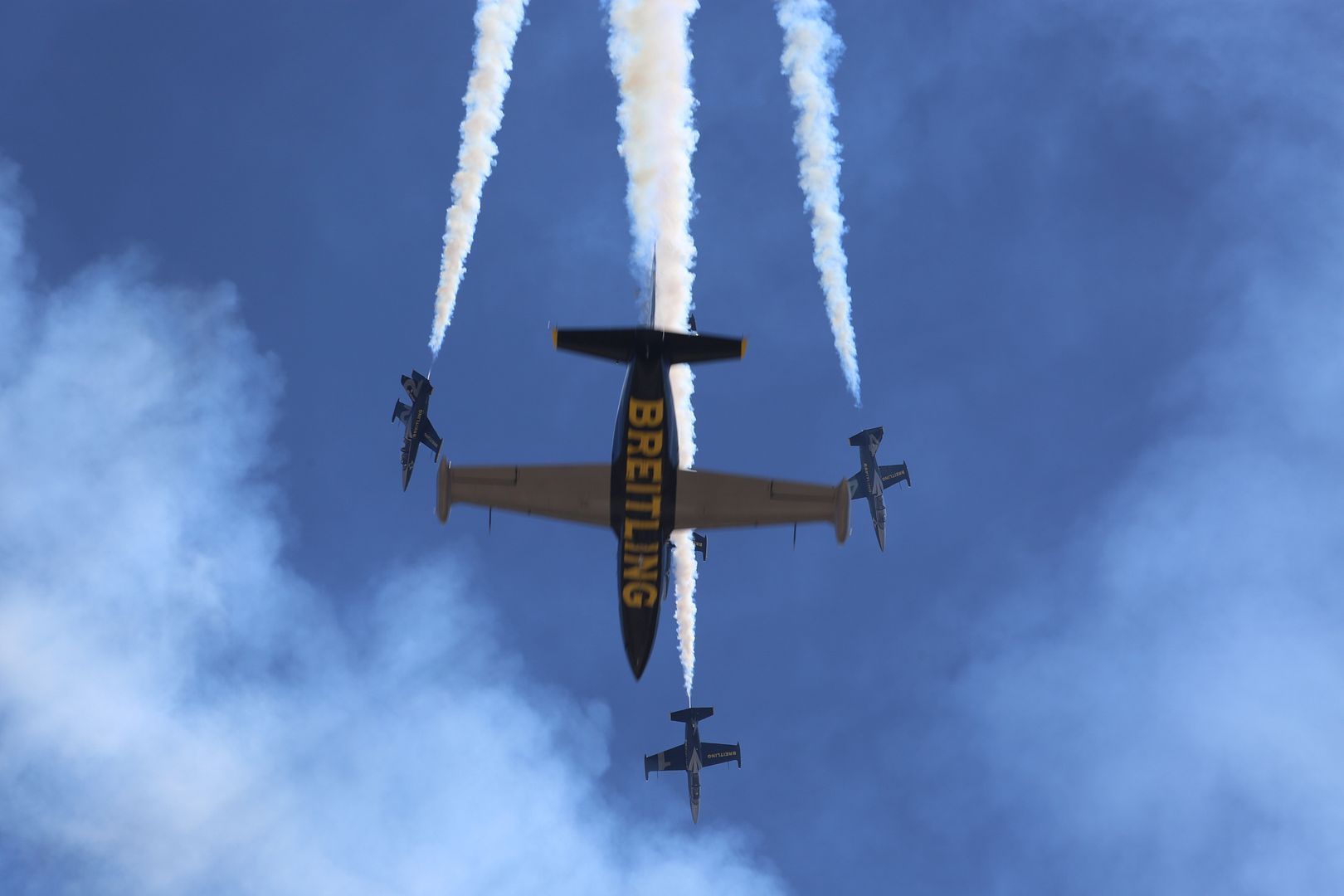
Republic of Korea air force Black Eagles fly in formation during Air Power Day 2016 on Osan Air Base, Republic of Korea, Sept. 25, 2016. Air Power Day was a two-day event that highlighted the partnership between the Republic of Korea and the U.S. military. (U.S. Air Force photo by Staff Sgt. Jonathan Steffen)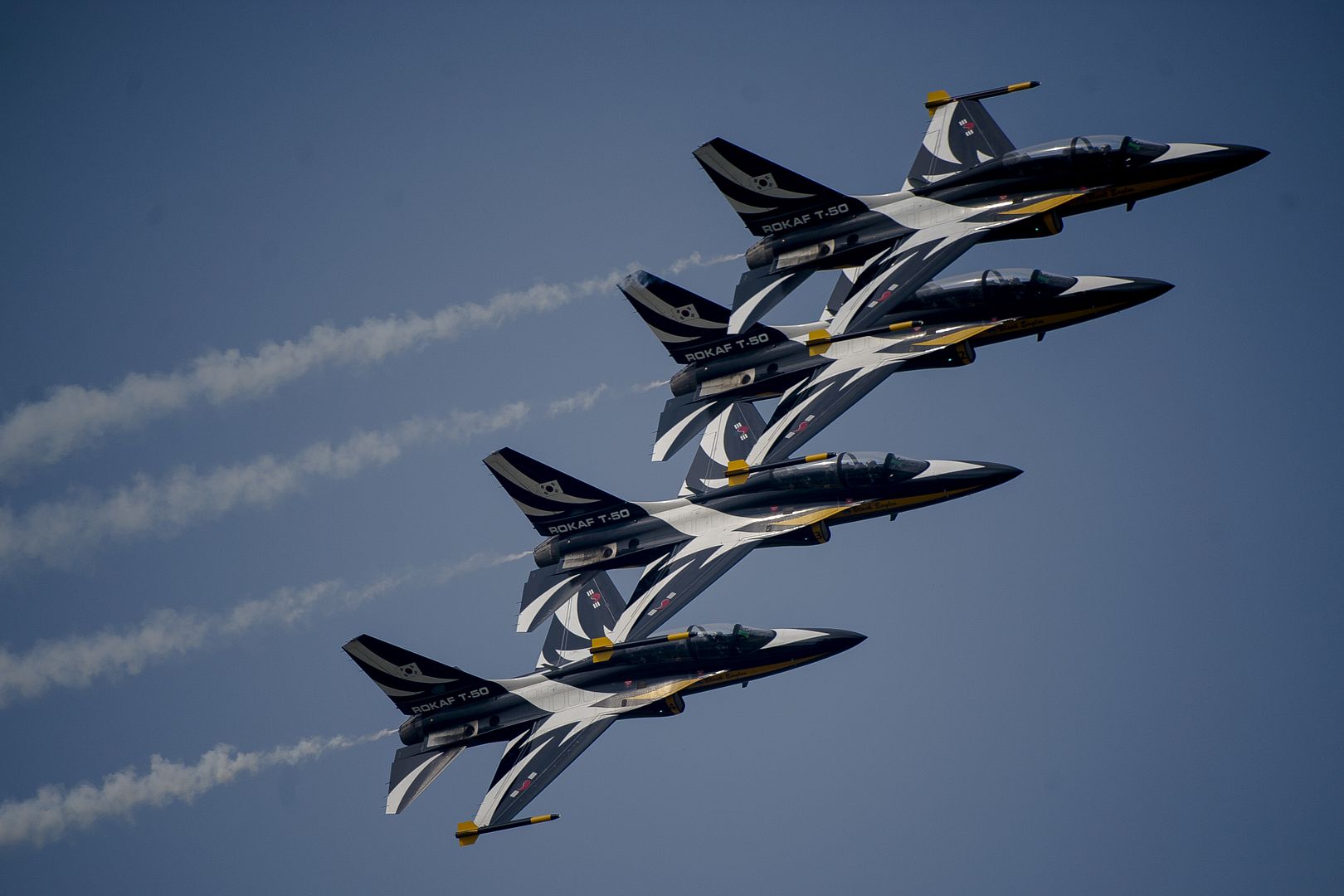
-
 Main AdminRNZAF C-130 Hercules NZ 7001 has reached an impressive milestone, being the first of the fleet to reach 30,000 flying hours with the youngest and newest No. 40 Squadron pilot, FGOFF Max Longdill (aged 21) at the controls on his first flight in the airframe.
Main AdminRNZAF C-130 Hercules NZ 7001 has reached an impressive milestone, being the first of the fleet to reach 30,000 flying hours with the youngest and newest No. 40 Squadron pilot, FGOFF Max Longdill (aged 21) at the controls on his first flight in the airframe.
This grand aircraft is the oldest in the fleet at almost 52-years-old, but still going strong.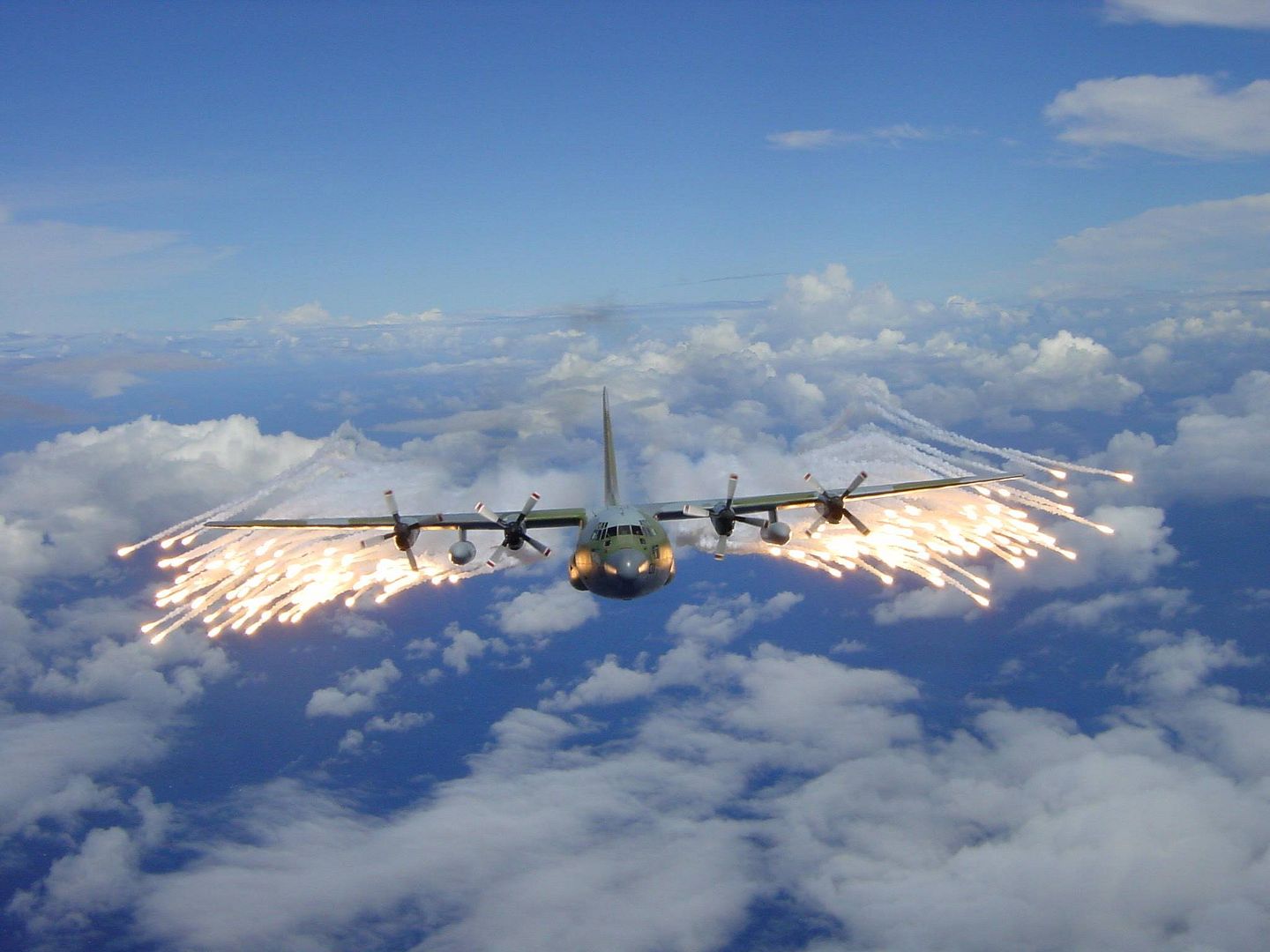
LUKE AIR FORCE BASE --
Seven Luke F-35s were at Mountain Home Air Force Base, Idaho, September 10 through 24, 2016, for pilot training. While this is not the first time Mountain Home AFB has supported F-35s, it is the first time the base has supported Air Education and Training Command pilot training.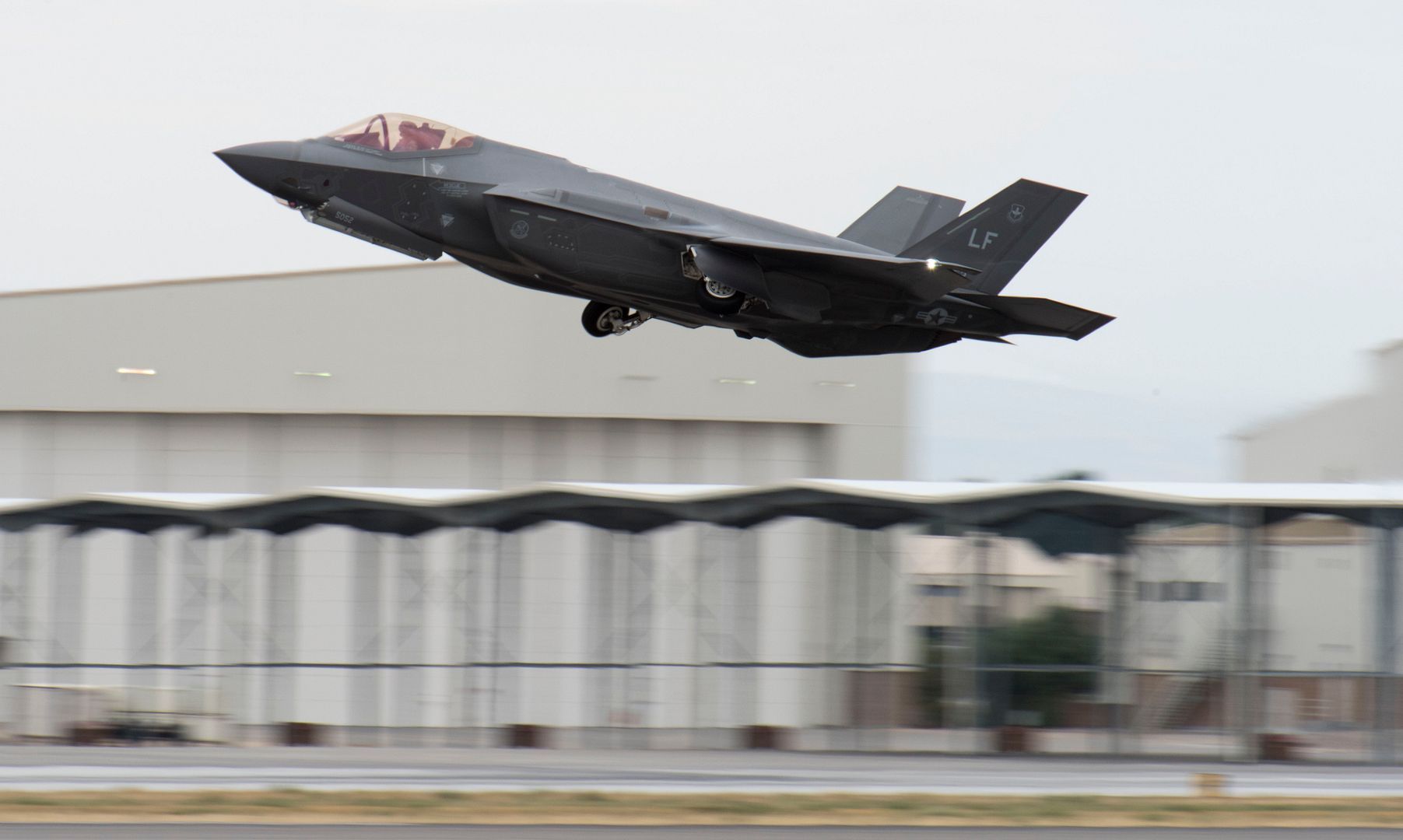
?The main objective of this training deployment was to increase our instructor pilots' proficiency in finding and destroying surface-to-air threats, which is a bread-and-butter mission for the F-35,? said Lt. Col. Michael Gette, 61st Fighter Squadron commander. ?Mountain Home AFB provides a unique opportunity for this training due to their outstanding range complex, which includes several surface-to-air threats we can ?fight? in increasingly complex scenarios.?
The success of the Mountain Home AFB training deployment was dependent on many Airmen. There were approximately 100 personnel participating in the exercise, including 80 maintainers and 15 pilots as well as seven contractors who helped with mission planning and security, according to Gette.
In addition to sharpening the pilots? warfighting skills, aircrew had the opportunity to practice a deployment-style scenario with a partner nation.
?This was the first F-35 training deployment to include partner pilots,? Gette said. ?Being able to deploy and train with our Royal Australian Air Force partners was an important step for the squadron and for the program as we continue to stand-up partner training at Luke AFB."
While the RAAF has had F-35s at Luke AFB since December 2014, this mission was an important joint experience.
?The Mountain Home deployment provided an opportunity to improve F-35 operator knowledge and skills while working hand in hand with our U.S. Air Force colleagues,? said Squadron Leader Andrew Jackson, 61st FS RAAF Senior National Representative. ?Opportunities such as these provide invaluable stepping stones in building a solid fifth generation, warfighting capability for the RAAF. As the first partner nation to arrive and train at Luke AFB, the opportunity to deploy to Mountain Home AFB with AETC is an exceptional training opportunity as we work toward our own IOC in 2020.?
The trip to Mountain Home AFB ultimately met the goals they set out to achieve.
?The Mountain Home Range Complex gave us a really unique opportunity to train against multiple surface-to-air threats,? Gette said. ?We appreciate Mountain Home AFB and the support from the community for their very warm welcome. We got everything we needed and the training deployment went very well.?
-
 Main AdminEGLIN AIR FORCE BASE, Fla. -- Air Combat Command declared Initial Operational Capability for the QF-16 Full-Scale Aerial Target September 23.
Main AdminEGLIN AIR FORCE BASE, Fla. -- Air Combat Command declared Initial Operational Capability for the QF-16 Full-Scale Aerial Target September 23.
The decision was approved by Gen. Hawk Carlisle, commander of ACC, for the total of 15 QF-16s currently available for target operations. The jets are assigned to Tyndall AFB and flown by the 82nd Aerial Target Squadron under the 53rd Wing.
The 82nd ATRS operates the only full scale aerial target capability in the Department of Defense. In accordance with U.S. law, Title 10, Section 2366 of the U.S. Code, a missile system must undergo lethality testing before it can enter full-scale production. The 82nd ATRS maintains DOD?s sole capability to execute the Title 10 requirement through the FSAT program.
The QF-16 is the introduction of 4th generation fighter capabilities in the aerial target mission. It maintains all inherent capabilities of the baseline F-16 including supersonic flight and nine-G maneuverability.
"This leap forward in airframe capabilities, combined with advanced electronic pods, will allow us to properly test and evaluate our 5th generation aircraft and weapons," said Lt. Col. Matthew Garrison, 82nd ATRS commander.
The newest aerial target was fielded to replace the QF-4, which flew its last unmanned mission Aug. 17 at Holloman AFB, New Mexico. The QF-4 will officially retire in December.
The 82nd ATRS is a geographically separated unit of the 53rd WG headquartered at here.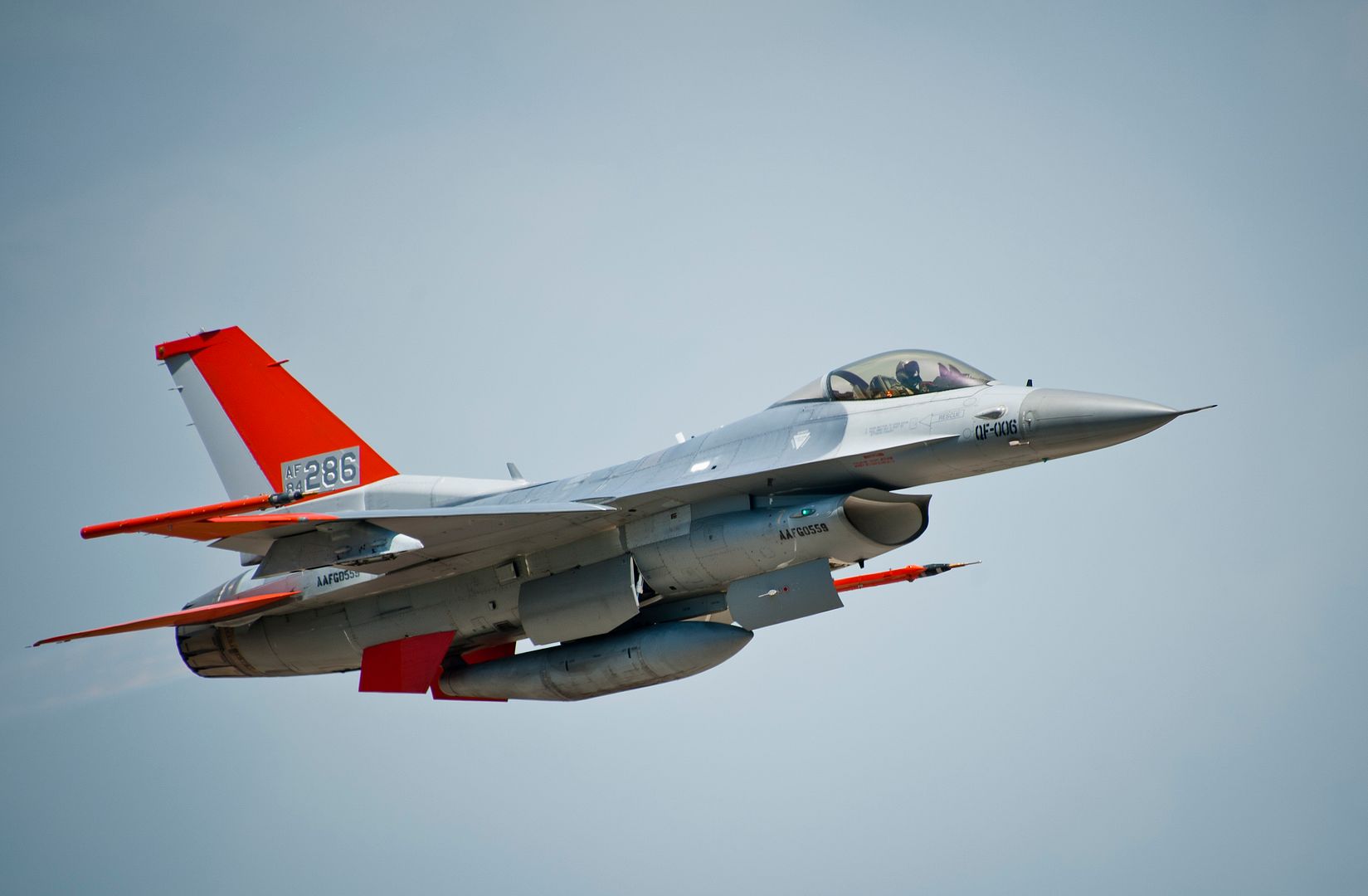
Naval Air Station Patuxent River, Md. ? Sept. 26, 2016 ? Following a successful Milestone Decision Authority (MDA) led review, the U.S. Navy?s MQ-4C Triton unmanned aircraft system (UAS) obtained positive Milestone C low-rate initial production approval. The decision marks the beginning of the production and deployment phase of the DoD acquisition process.
?Triton?s critical technology is mature, and the system development and design review phases have been successful,? said Doug Shaffer, vice president, Triton programs, Northrop Grumman. ?Completion of the full system Operational Assessment (OA) testing exercised in various real-world scenarios validated the system?s ability to protect the Navy?s fleet from evolving threats. We are extremely pleased with the maritime domain awareness products and results coming from Triton.?
An integrated test team made up of Navy personnel from Air Test and Evaluation Squadrons VX-1 and VX-20, Unmanned Patrol Squadron, VUP-19 and Northrop Grumman demonstrated the true reliability of Triton going into Milestone C. The team analyzed and validated sensor imagery and performance at different altitudes and ranges. The aircraft system?s ability to classify targets and disseminate critical data was also examined as part of the OA testing. Successful evaluation of Triton?s time on station confirmed that it will meet flight duration requirements. Triton also transferred full motion video to a P-8A Poseidon in flight, proving a key capability to significantly enhance its ability to detect, track, classify and identify maritime threats.
Northrop Grumman is a leading global security company providing innovative systems, products and solutions in autonomous systems, cyber, C4ISR, strike, and logistics and modernization to customers worldwide. Please visit www.northropgrumman.com for more information.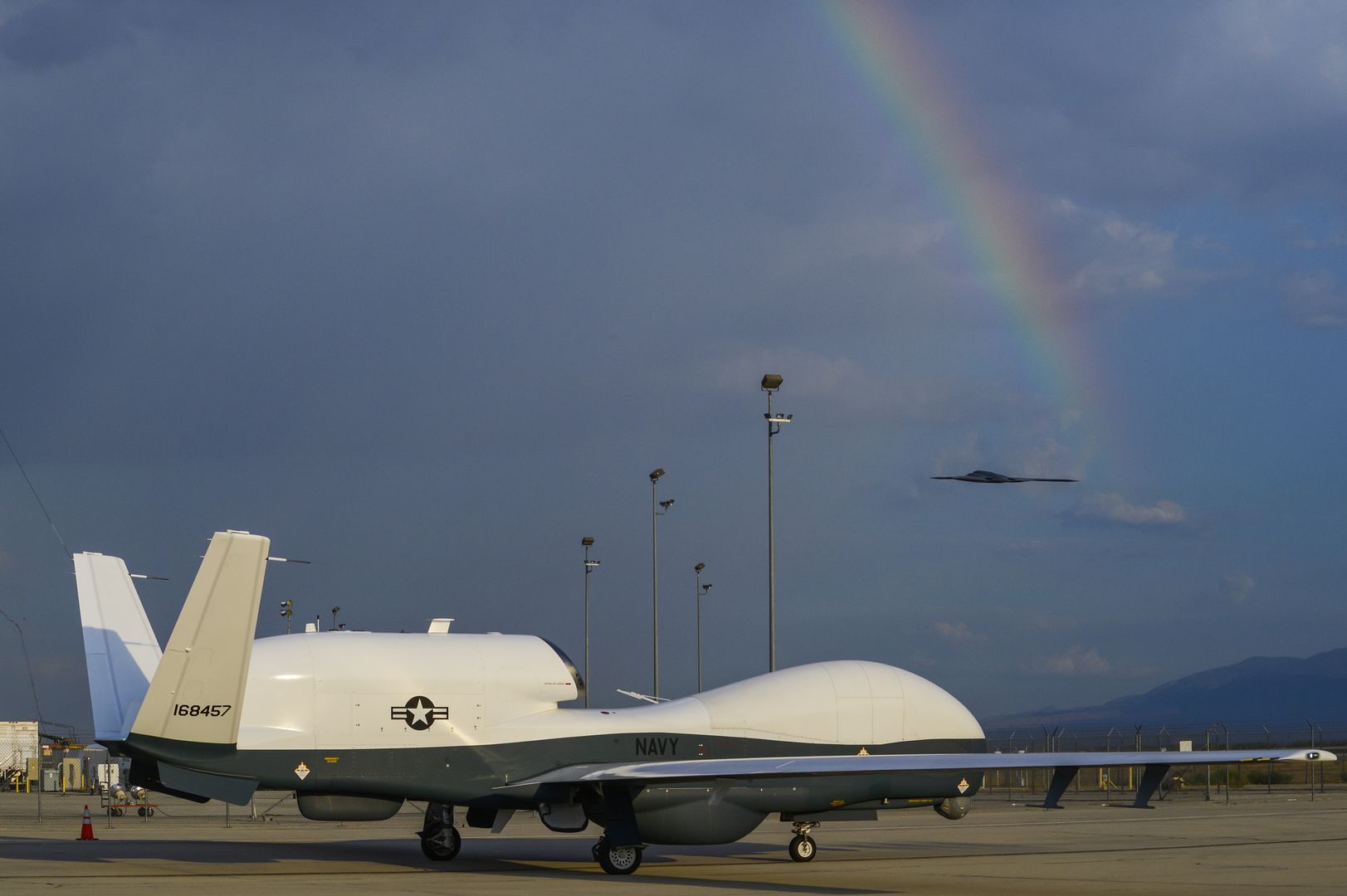
September 27, 2016 Toronto Commercial Aircraft, Press Release
Bombardier Commercial Aircraft announced today the delivery of the Tanzanian Government Flight Agency?s two Q400 turboprops. The aircraft, which were newly delivered with a 76-seat, dual-lavatory configuration, will be operated by Air Tanzania, the national airline of the United Republic of Tanzania. The delivery of the two aircraft increases the fleet of Q Series turboprops in Africa to approximately 125 aircraft including 40 Q400 aircraft.
?As we look to expand operations and increase our route network across Tanzania and the African continent, the technologically advanced Q400 aircraft is a key component in our growth strategy,? said Dr. Leonard Chamuriho, Permanent Secretary, Ministry of Transport, Works and Communication, Tanzania. ?Its ability to operate at challenging airfields, combined with its fuel efficiency, excellent reliability and comfortable passenger amenities, make it a valuable addition to our fleet.?
?The Q400 aircraft is showcased very well in Africa where it has proven itself to be extremely efficient and continues to maintain strong market share in its class,? said Jean-Paul Boutibou, Vice President, Sales - Middle East and Africa, Bombardier Commercial Aircraft. ?We are delighted to welcome Air Tanzania to the Q400 aircraft family and proud to support the airline as it joins our vast network of Q Series operators in Africa.?
Bombardier?s commercial aircraft presence in Africa includes a Regional Support Office (RSO) and spare parts depot, co-located in Johannesburg, South Africa as well as Authorized Service Facilities in South Africa and Ethiopia. Operating from the company?s regional office located in the United Arab Emirates, Bombardier Commercial Aircraft?s sales and marketing team is well positioned to provide industry-leading solutions to its current and prospective customers.
About the Q400 Aircraft
Designed as a modern, 21st-century turboprop, the Q400 aircraft is the most recent development in the Q Series family of aircraft. It provides unmatched performance, operational flexibility and passenger comfort. In addition to the standard single-class configuration, Q400 aircraft are available with an optional dual-class interior for enhanced passenger comfort; in an optional extra-capacity configuration offering up to 90 seats for higher-density markets; and in a cargo-passenger combi configuration.
Thanks to its combination of turboprop attributes, jet-like features, industry-leading passenger experience and environmental footprint, the Q400 aircraft is exceptionally versatile and can be adapted to a variety of business models. By offering a 30 per cent reduction in fuel burn over the jets it often replaces, the Q400 aircraft radically reduces carbon emissions and increases cost efficiency. Its high-speed cruise -- 160 km/h faster than conventional turboprops -- places the aircraft?s flight time within minutes of jet schedules, at the same seat cost as larger single-aisle jets. Its large propellers operate at a lower RPM, generating more power with less noise and making it a friendly option for city centres.
The Q400 aircraft family includes over 60 owners and operators in almost 40 countries. The worldwide fleet has logged more than 7 million flight hours and has transported more than 429 million passengers. Long recognized as a high-value asset by operators, the Q400 aircraft is now also attracting growing interest from the leasing community.
Bombardier has recorded firm orders for a total of 565 Q400 aircraft.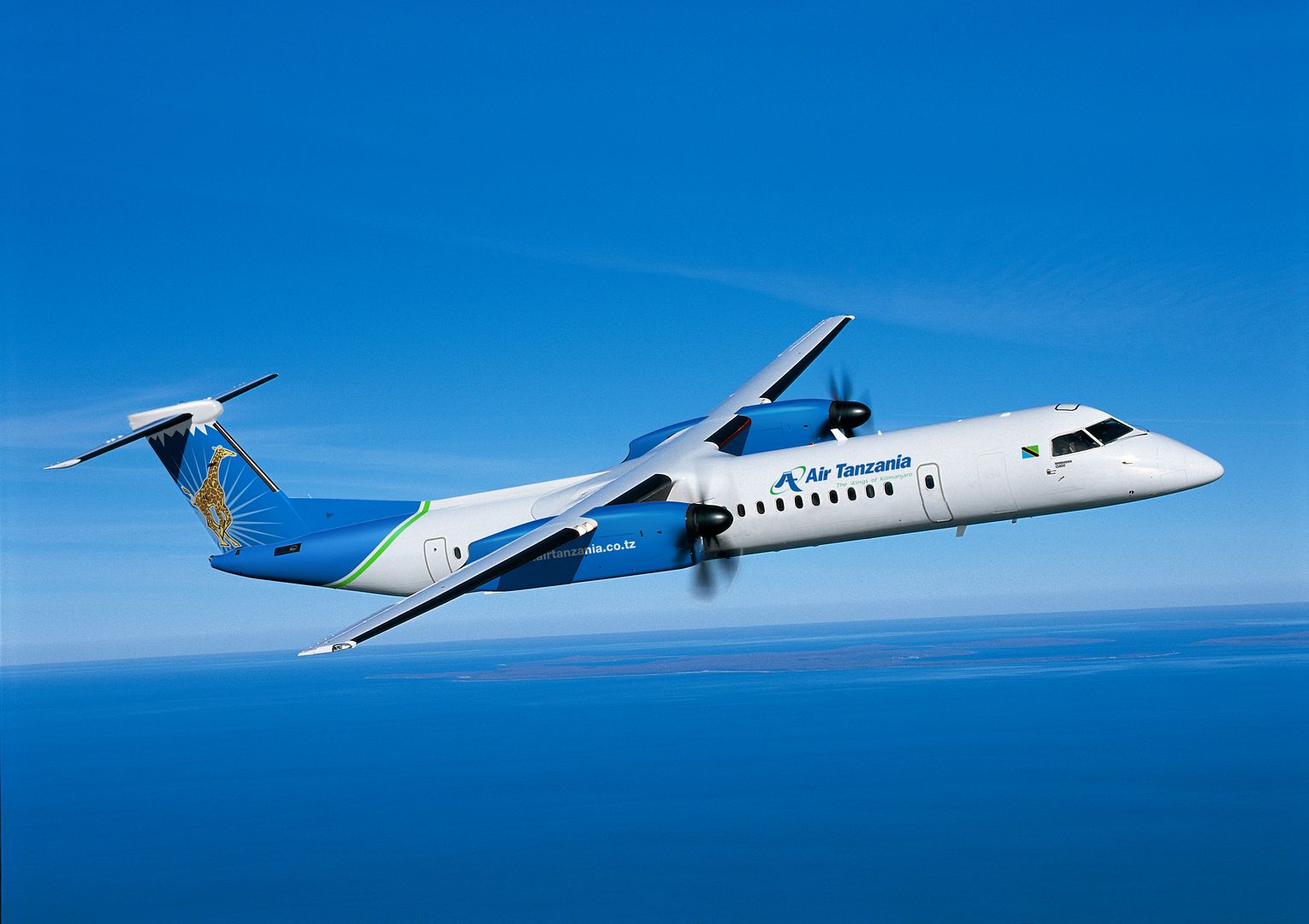
A restored WWII de Havilland DH.98 Mosquito fighter-bomber was flown for the first time out of Ardmore Airport yesterday following a lengthy rebuild. As a tribute to the RNZAF, the aircraft wore the same colours as the original: No. 75 Sqn RNZAF ? NZ2337 (YC-F) which was destroyed in a hangar fire at Ohakea 66 years ago. Fittingly, the two test pilots who flew the Mosquito are both ex-RNZAF pilots, Dave Phillips and Keith Skilling.
The work was undertaken by restoration company AVSPECS and tonysmithphotography.co.nz took some great shots of the aircraft in action.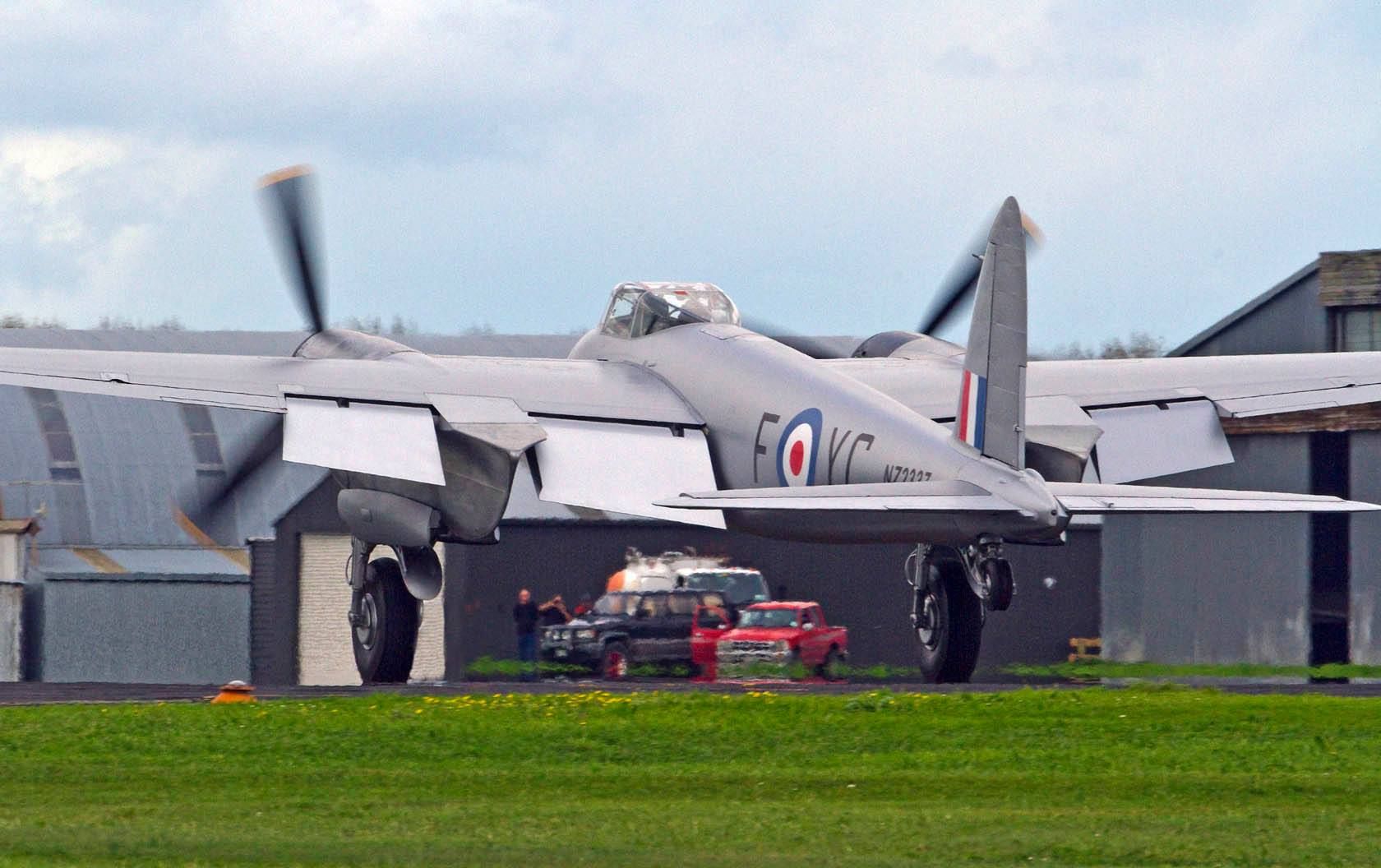
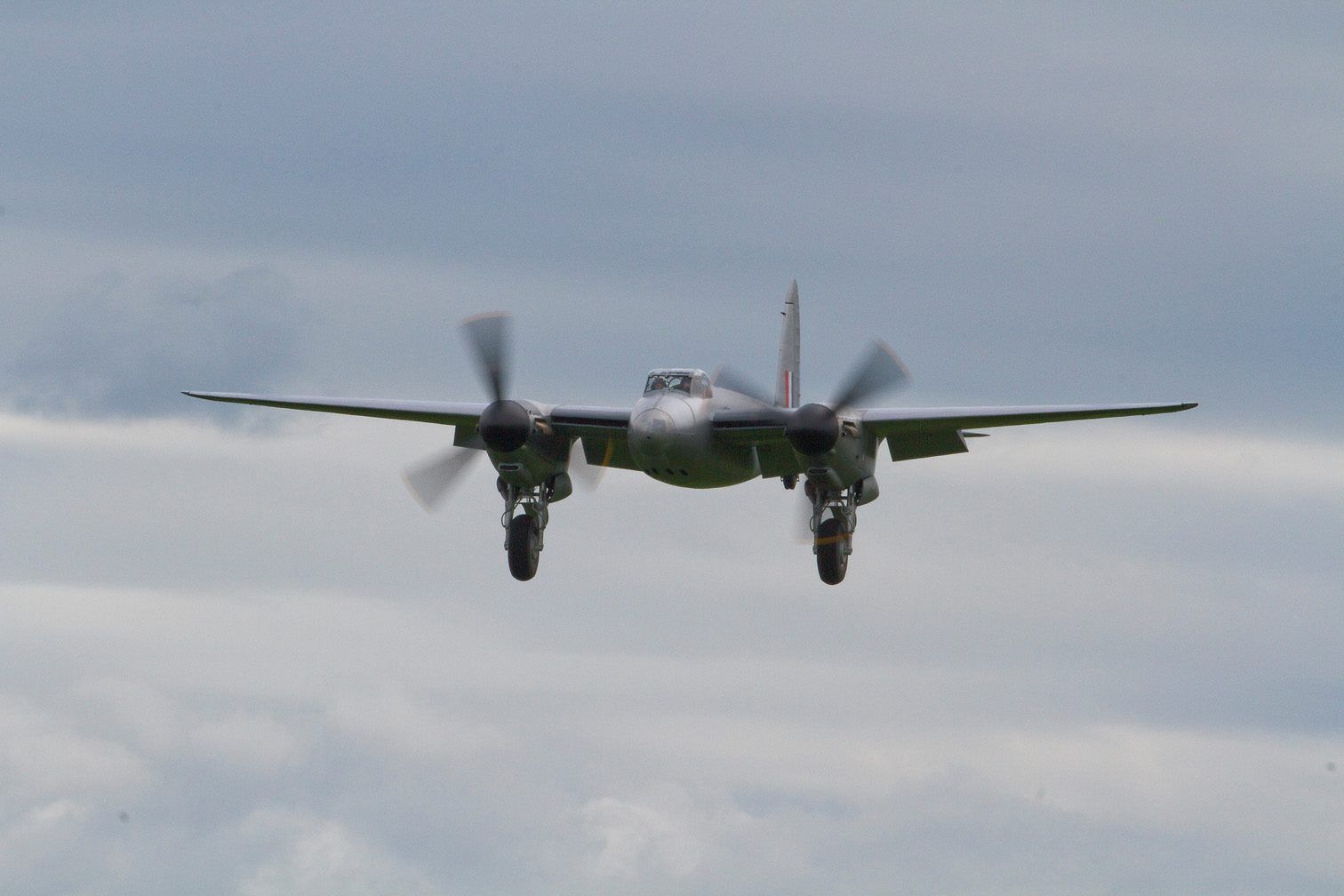

-
 Main AdminA CH-53E Super Stallion assigned to Marine Aviation Weapons and Tactics Squadron One (MAWTS-1) lands during Weapons and Tactics Instructor Course (WTI) 1-17 at Yuma Proving Ground, Ariz., Sept. 27, 2016. This exercise was part of WTI 1-17, a seven week training event, hosted by Marine Aviation Weapons and Tactics Squadron One (MAWTS-1) cadre, which emphasizes operational integration of the six functions of Marine Corps aviation in support of a Marine Air Ground Task Force. MAWTS-1 provides standardized advanced tactical training and certification of unit instructor qualifications to support Marine Aviation Training and Readiness and assists in developing and employing aviation weapons and tactics. (U.S. Marine Corps photo by Lance Cpl. Danny Gonzalez, MAWTS-1 COMCAM)
Main AdminA CH-53E Super Stallion assigned to Marine Aviation Weapons and Tactics Squadron One (MAWTS-1) lands during Weapons and Tactics Instructor Course (WTI) 1-17 at Yuma Proving Ground, Ariz., Sept. 27, 2016. This exercise was part of WTI 1-17, a seven week training event, hosted by Marine Aviation Weapons and Tactics Squadron One (MAWTS-1) cadre, which emphasizes operational integration of the six functions of Marine Corps aviation in support of a Marine Air Ground Task Force. MAWTS-1 provides standardized advanced tactical training and certification of unit instructor qualifications to support Marine Aviation Training and Readiness and assists in developing and employing aviation weapons and tactics. (U.S. Marine Corps photo by Lance Cpl. Danny Gonzalez, MAWTS-1 COMCAM)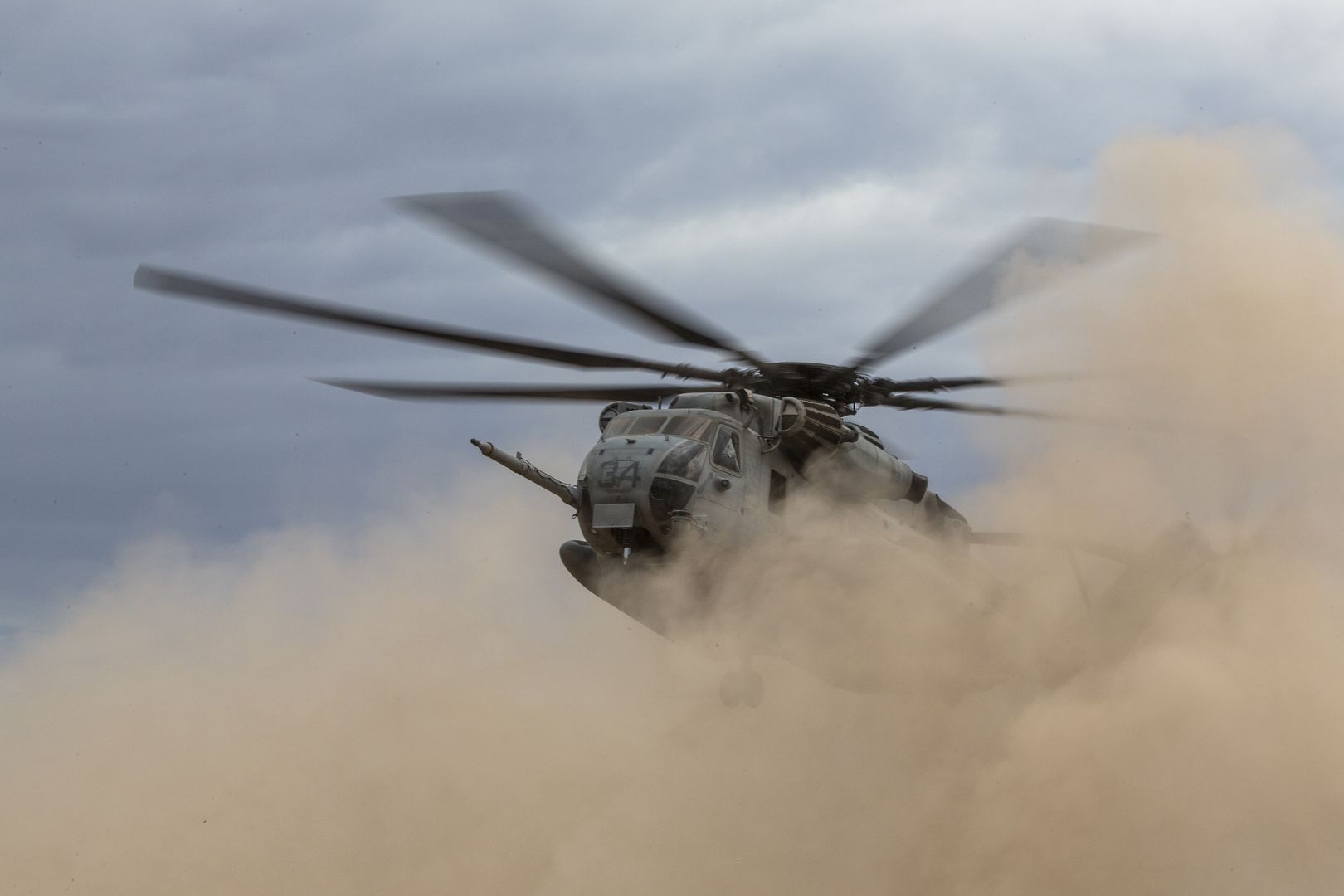
A U.S. Marine Corps CH-53E Super Stallion assigned to Marine Aviation Weapons and Tactics Squadron One (MAWTS-1) prepares to refuel at a forward arming refueling point during Weapons and Tactics Instructor (WTI) course 1-17 at LZ Bull Assault, Calif., Sept. 27, 2016. This exercise was a part of WTI, a seven week training event, hosted by MAWTS-1 cadre, which emphasizes operational integration of the six functions of Marine Corps aviation in support of a Marine Air Ground Task Force. MAWTS-1 provides standardized advanced tactical training and certification of unit instructor qualifications to support Marine Aviation Training and Readiness and assists in developing and employing aviation weapons and tactics. (U.S. Marine Corps photo by Cpl. AaronJames Vinculado, MAWTS-1 COMCAM)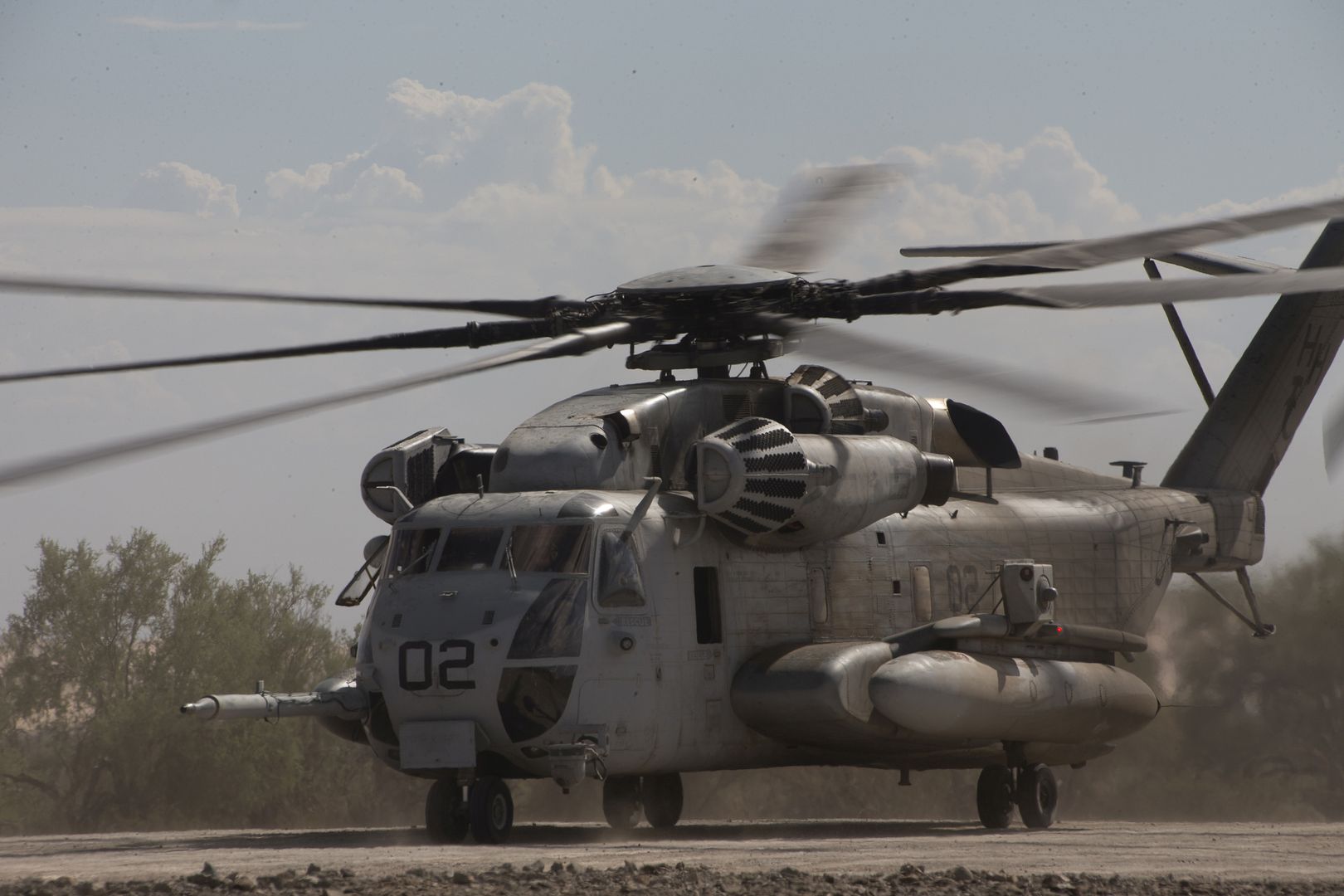
TYNDALL AIR FORCE BASE, Fla. --
After the intense warmth of the Florida heat lessens with the setting of the sun, the sound of maintainers shouting ?A-P-U,? and the starting of F-22 Raptor engines can still be heard well into the night.
The 325th Fighter Wing recently flew night missions to stay proficient in all conditions.
Airmen from maintenance, security forces, operations support and many others worked together to ensure that the pilots at Tyndall AFB are trained, prepared and protected while conducting night operations when needed.
?The bottom line on night flying is that we are tasked to be ready to support combat operations directly ? daytime, night time and even in less than ideal weather conditions,? said Maj. Joshua Biedermann, 95th Fighter Squadron director of operations. ?To do that, we have to train at night periodically throughout the year. For a typical pilot we need to get 15 night flights. This is something we can?t do all at once, so we spread it out throughout the year.?
From the ground up, all involved need to have the capability to work together regardless of the time of day and adverse weather conditions.
?Without the maintainers there is no night mission, we wouldn?t have any aircraft to fly,? Biedermann said. ?That?s everything from generating the jets for us to takeoff, manning the hot pit refueling, fixing aircraft and helping us trouble shoot or possibly switch out a part. They help maximize our training by getting us good aircraft and fixing aircraft so we can do it again the next night.?
With low visibility in the night hours, the pilots from the 95th FS must maintain a heightened sense of awareness while traveling down the runway at speeds upward of 180 miles per hour.
?It?s a time of day that can be very dangerous if you are not proficient at it,? Biedermann said. ?The 325th Operations Support Squadron tower and radar approach control sections are very important for us. They help us at night especially with the weather. They de-conflict aircraft and provide efficient flow to and from the air space, which is important for all of our fuel planning. When pilots come back and land at night everyone is flying in on instrument approach, so it is a higher task load for RAPCON as they are bringing fighters back in.?
To aid in the situational awareness of the pilots while on the ground and while airborne, air traffic controllers from the 325th OSS work tirelessly through the night to guarantee everyone?s safety.
?Doing night flying training at Tyndall means that we will be able to fight at night,? said Airman 1st Class John Dashiell, 325th OSS air traffic controller. ?The biggest difficulty with night flying is that all you can see is the lights on the aircraft. This makes determining the distance harder, but we have the radar and other instruments to help us out.?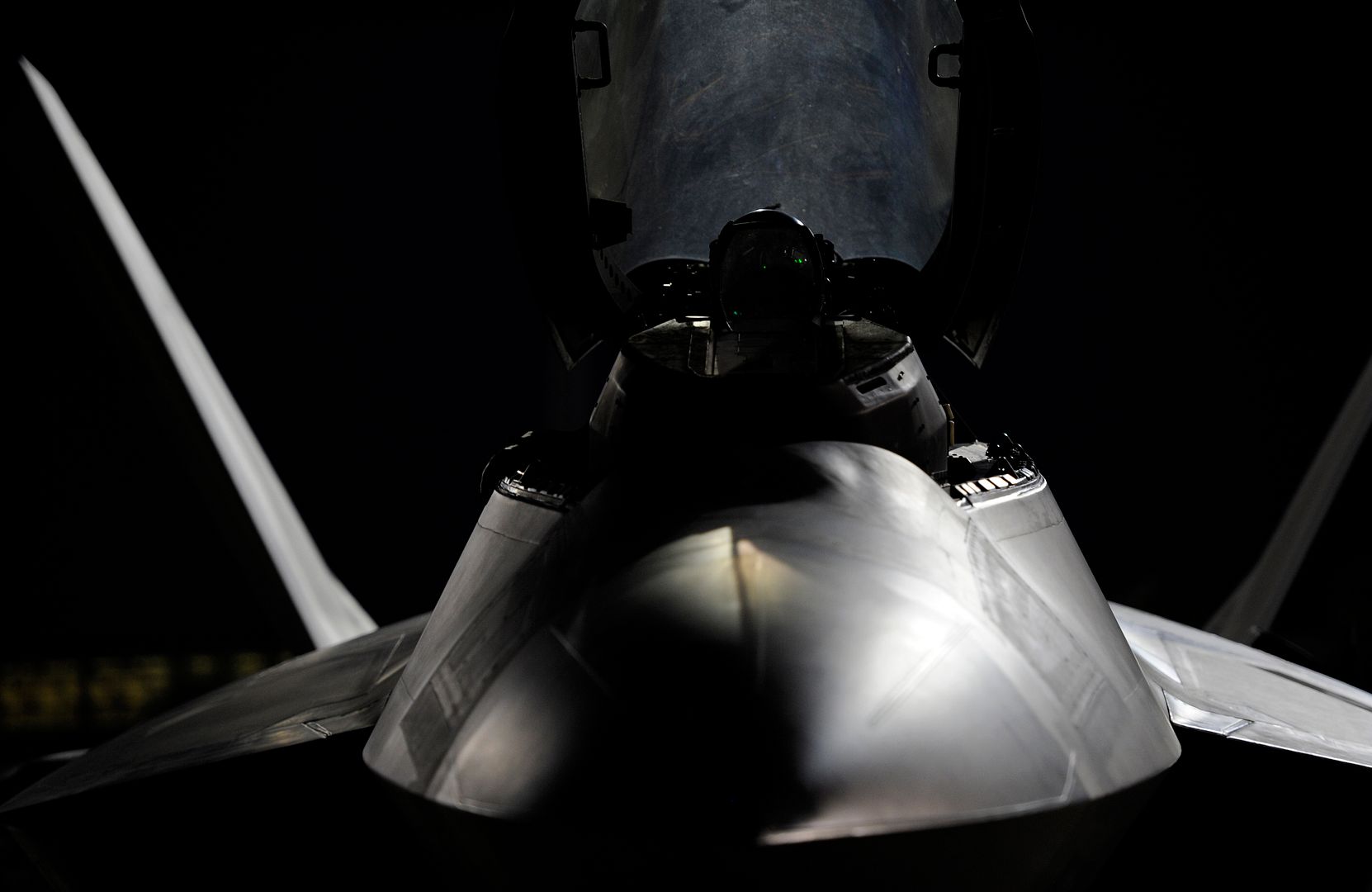
Whether it be maintenance, security, air traffic control or flying, the Airmen of Tyndall ensure the Raptors are ready to fight, no matter the time of day.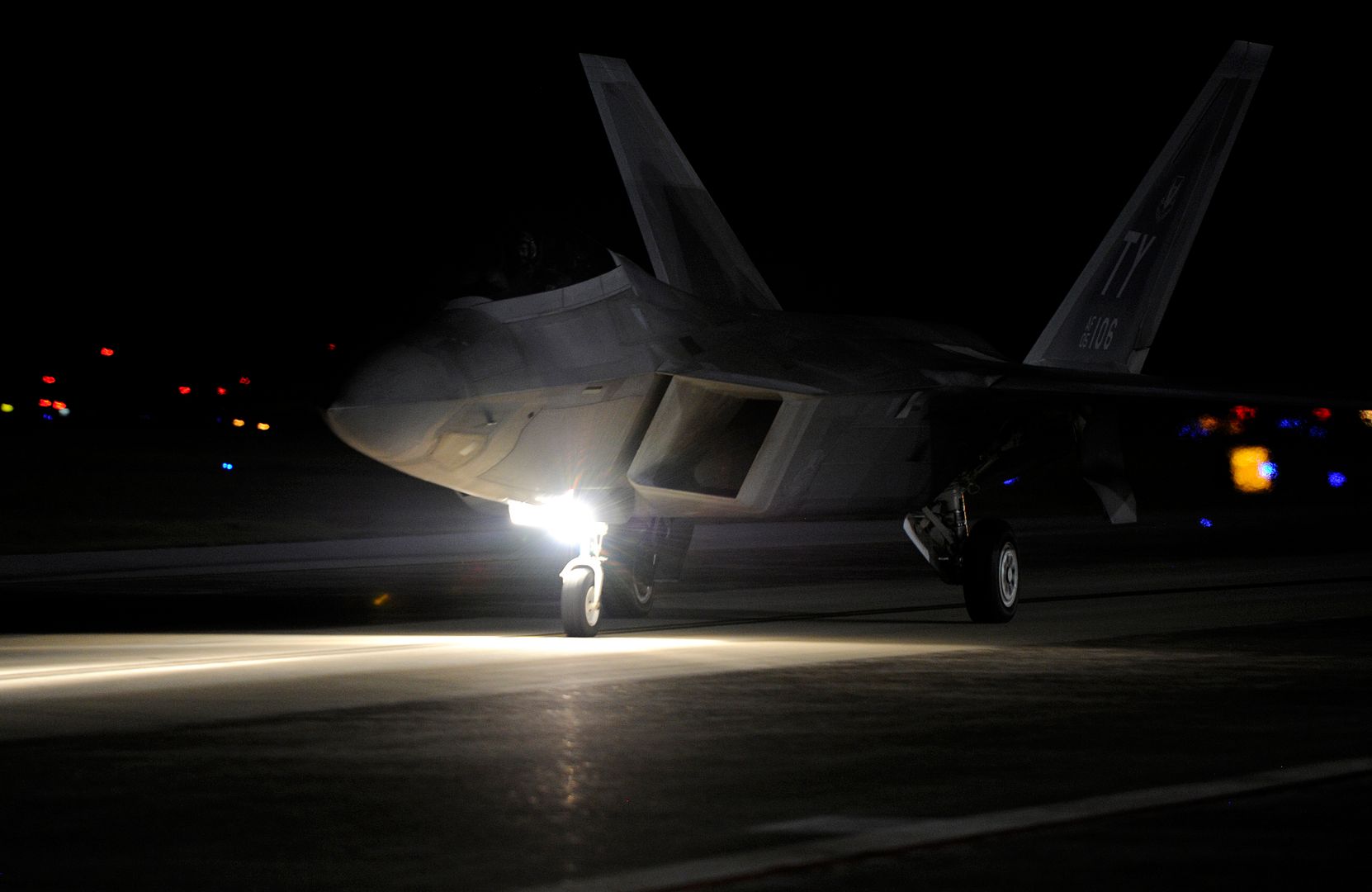
27 September 2016 Press Release
Airbus has commenced the final assembly of its first A330neo, an A330-900, at its Final Assembly Line in Toulouse with the joining of the wings to the centre fuselage at station 40.
As the newest member of the world?s most popular A330 wide-body family the A330neo builds on the Family?s proven economics, versatility and reliability, set to reduce fuel consumption by a further 14 per cent per seat. Both the A330-800 and A330-900 feature a new A350-inspired wing with Sharklet wingtip devices for state-of-the-art aerodynamics, incorporating latest-generation Rolls-Royce Trent 7000 engines, and the new AirSpace by Airbus cabin for the latest experience in cabin comfort.
?We have started with a very tight development schedule and are today right on time,? says Odile Jub?court, Airbus Head of the A330neo programme. ?I am happy to say we are in good shape to meet the high standards of maturity and reliability our customers expect from us and I want to thank the teams for this outstanding achievement.?
Thanks to its low, new generation fuel-burn, the A330neo expands its operators? market opportunities by offering an additional 400 nautical miles range, leading to a 6,550 nautical miles range on the A330-900 and 7,500 nautical miles on the A330-800. To date, 10 customers have ordered a total of 186 A330neo.
The A330-800 and the A330-900 are 99 per cent common, sharing a 95 per cent commonality across the entire A330 fleet, set to optimize costs and flexibility for all its operators. Airlines will also benefit from the Family?s market-leading reliability and reduced maintenance costs.
The A330 is the most popular mid-size wide-body aircraft ever, having won over 1,600 orders to date. Today, over 1,250 aircraft are flying with over 120 airlines worldwide on a wide range of routes, from domestic and regional flights to long range intercontinental services.
Offering the lowest operating costs in its category, and due to continuous investments in latest innovations, the new generation A330neo is the most profitable and best performing aircraft in its size category.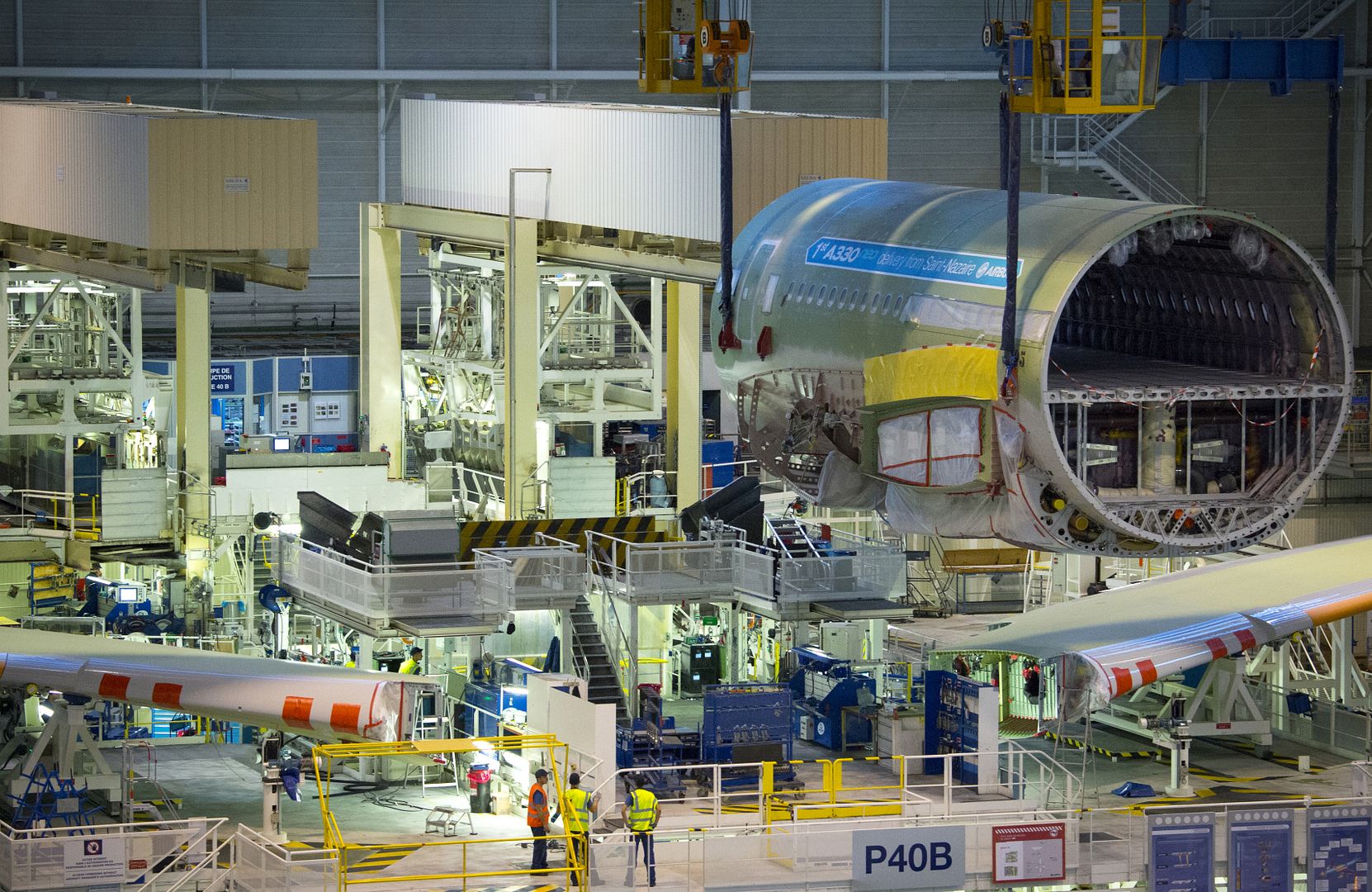
September 27, 2016 Montr?al Commercial Aircraft, Press Release
Bombardier Commercial Aircraft announced today that its CS300 jetliner, the second CS300 flight test vehicle, has embarked on a series of European and Middle Eastern route-proving flights alongside first operator airBaltic of Latvia. The flights ? which will operate from the airline?s base in Riga include stops in Vilnius, Lithuania, Tallinn, Estonia and Abu Dhabi, United Arab Emirates - will use airBaltic air and ground operational practices.
?It?s exciting for the airBaltic team to welcome the CS300 to its home base in Riga for the first time to see the aircraft simulate operations in our route system that covers much of Europe - all in advance of our first delivery later this fall,? said Martin Gauss, Chief Executive Officer, airBaltic. ?The CS300 aircraft has outstanding performance, admirable efficiency and an impressive cabin that offers maximum comfort and we are looking forward to introducing this fine aircraft to our passengers and airports in our network.?
?Because of the 99 per cent commonality between the CS100 and CS300 aircraft and the diverse routes that award-winning airline airBaltic operates, we are expecting to see a perfect blend of performance, outstanding reliability and operational ground support,? said Rob Dewar, Vice President, C Series, Bombardier Commercial Aircraft. ?Our teams are working closely together as we ramp up activities for a real indication of how the CS300 will operate in the network and we are confident that its entry-into-service with airBaltic later this year will be impressive.?
With a firm order for 20 CS300 airliners - which will eventually join airBaltic?s 12 Q400 turboprops - the airline will gradually transition to an all-Bombardier fleet. The route-proving flights provide a very good indication of how the aircraft will perform in typical day-to-day airline operations by observing airfield performance, airport turnaround times and on-ground operations at various airports.
About C Series Aircraft
The C Series is the only aircraft optimized for the 100- to 150-seat market segment, which drives the aircraft?s phenomenal economic proposition and performance, opening up new opportunities for single-aisle aircraft operation.
Comprised of the CS100 and the larger CS300 aircraft, the C Series family represents the fusion of performance and technology. The result is aircraft that deliver unmatched performance and economics in the 100- to 150-seat market segment and an 18 per cent lower cost per passenger, making them the ideal candidates to complement larger single-aisle aircraft. Airlines can now operate routes that were previously not profitable or even possible. An improvement in range in excess of 20 per cent out of hot-and-high airports such as Denver, Mexico City or Lhasa has been confirmed.
Bombardier has created a new standard in cabin design and flexibility to ensure an unrivalled passenger experience. The aircraft?s larger seats, overhead bins and windows deliver a widebody feel that offers passengers unparalleled comfort in a single-aisle cabin.
The CS100 and the CS300 aircraft have over 99 per cent parts commonality as well as the same pilot type rating. The groundbreaking Pratt & Whitney PurePower? PW1500G engine, combined with the aircraft?s advanced aerodynamics, delivers reduced fuel burn, noise, and emissions ? making the C Series the most community-friendly aircraft.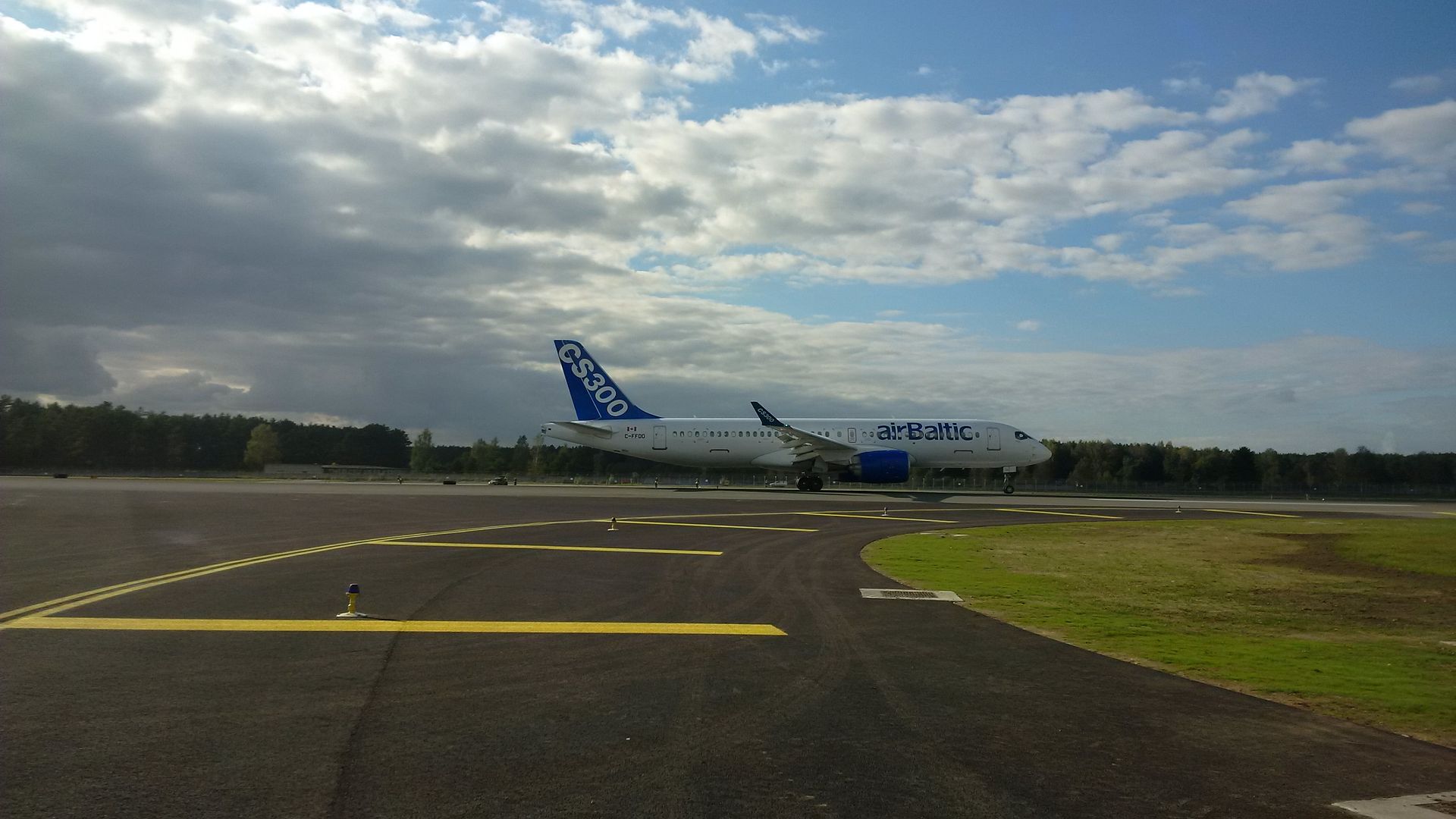
The first of twelve Australian P-8A Poseidon aircraft has been unveiled by Boeing at a roll-out ceremony in Seattle, Washington State, USA on September 27.
Chief of Air Force, Air Marshal Leo Davies, attended the ceremony and accepted into service the Royal Australian Air Force?s newest aircraft.
?It is a privilege to accept the first Australian P-8A Poseidon aircraft, said CAF AIRMSHL Davies.
?The P-8A is the latest in a pedigree of Boeing aircraft that have provided important and significant operational capability to Australia. This history includes the C-17A Globemaster, E-7A Wedgetail, F/A-18 Classic Hornet, F/A-18F Super Hornet, Helicopter Aircrew Training System and in the near future E/A-18G Growler.? CAF said.
Built from the ground up as a military aircraft, the P-8A is based on the proven commercial designs of Boeing?s 737-800 fuselage, but is substantially structurally modified to include a weapons bay, under wing and under fuselage hard points for weapons, as well as increased strengthening to allow for continued low level operations and high angle of bank turns.
Director Maritime Intelligence, Surveillance, Reconnaissance and Response Transition Office, GPCAPT Roger McCutcheon, said the P-8A was a fundamental element of Australia?s future maritime patrol and response strategy in replacing the current AP-3C Orion fleet - due for withdrawal in 2018-19.
?Over the next three years the P-8A will replace our current fleet of AP-3C Orion aircraft currently based at RAAF Base Edinburgh, said GPCAPT McCutcheon.
The first aircraft will arrive in Australia on 15 November 2016, with the remaining 11 aircraft to be delivered by March 2020.?
Air Force aircrew and maintenance personnel have been busy training for the arrival of the P-8A since early 2015 - working side by side with the US Navy at Naval Air Station Jacksonville, Florida. The first P-8A Australian pilot flew a four-hour sortie around the Air Station on 14 April 2015.
CAF AIRMSHL Davies said that close cooperation with the US Navy to develop mission, system and training requirements for the P-8A was crucial and has helped strengthen an already close relationship.
?Speaking to my team today, it is obvious they have been the recipients of some of the best training in the world from the US Navy,? said CAF AIRMSHL Davies.
?The bilateral cooperative program for the P-8A between Australia and the United States has been very successful. It is now the model to which our other Air Force projects must aspire.?
?The passion, pride and dedication of the all the Boeing team is evident in every aircraft produced,said CAF AIRMSHL Davies.
?I have no doubt that the aircraft Boeing has proudly built here today, along with the collaborative input from both Australia and the United States, will serve our nation with consummate success. I congratulate Boeing on this significant occasionand I thank you for all for your work.?
For Boeing Mechanic Paul Lingenfelter - a Washington State native whose work on Sonobouy structure rake installations directly resulted in zero manufacturing defects and improved time management for the P-8 program - CAF AIRMSHL Davieshad a more personal message.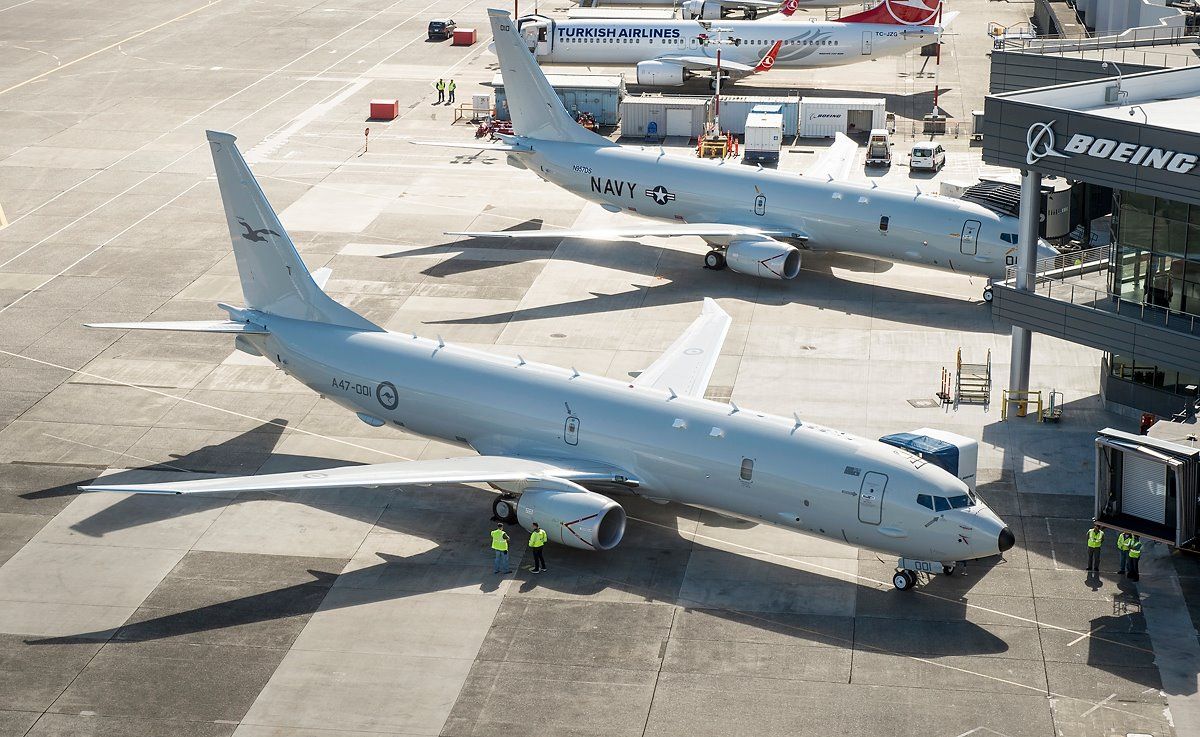

?Paul you are a great asset to the P-8A program and I thank you for your work, but sorry mate - your aircraft is coming with me.?
From Lithuania some stunning shots of French Mirage 2000's, on "Police Mission".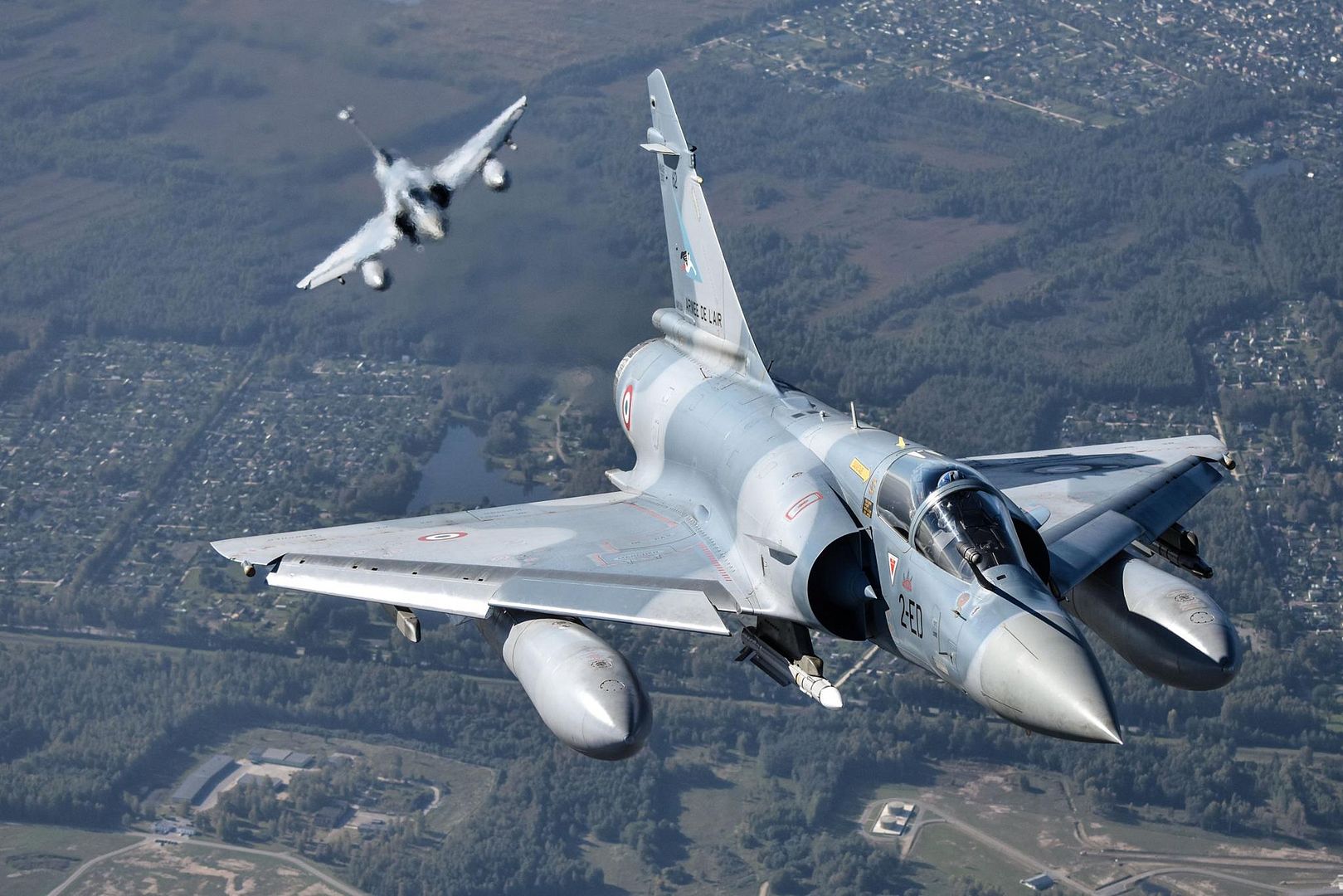

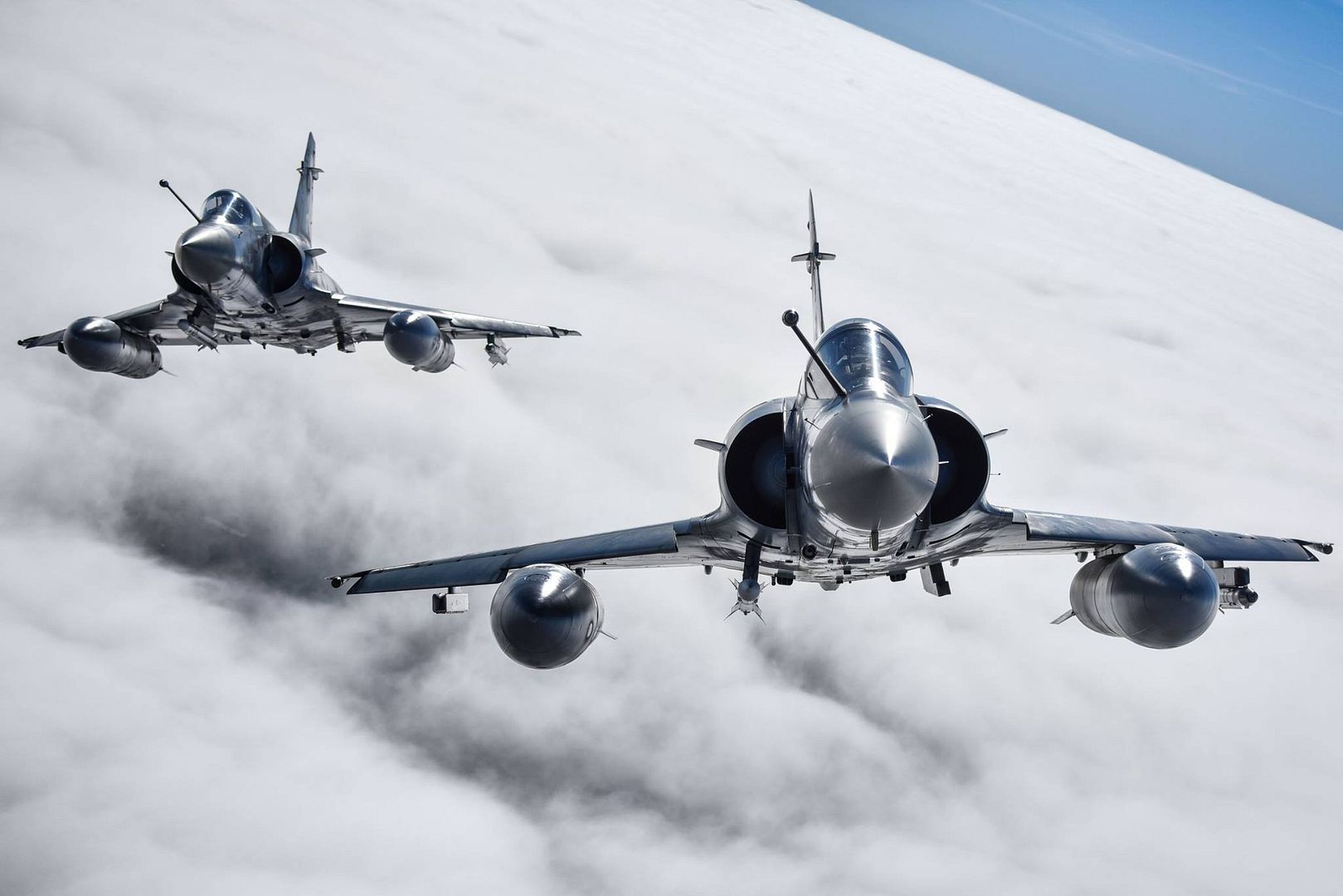
Credits: kpt. E. Karanauskas
Post a reply
- Go to Previous topic
- Go to Next topic
- Go to Welcome
- Go to Introduce Yourself
- Go to General Discussion
- Go to Screenshots, Images and Videos
- Go to Off topic
- Go to Works in Progress
- Go to Skinning Tips / Tutorials
- Go to Skin Requests
- Go to IJAAF Library
- Go to Luftwaffe Library
- Go to RAF Library
- Go to USAAF / USN Library
- Go to Misc Library
- Go to The Ops Room
- Go to Made in Germany
- Go to Campaigns and Missions
- Go to Works in Progress
- Go to Juri's Air-Raid Shelter
- Go to Campaigns and Missions
- Go to Works in Progress
- Go to Skinpacks
- Go to External Projects Discussion
- Go to Books & Resources
